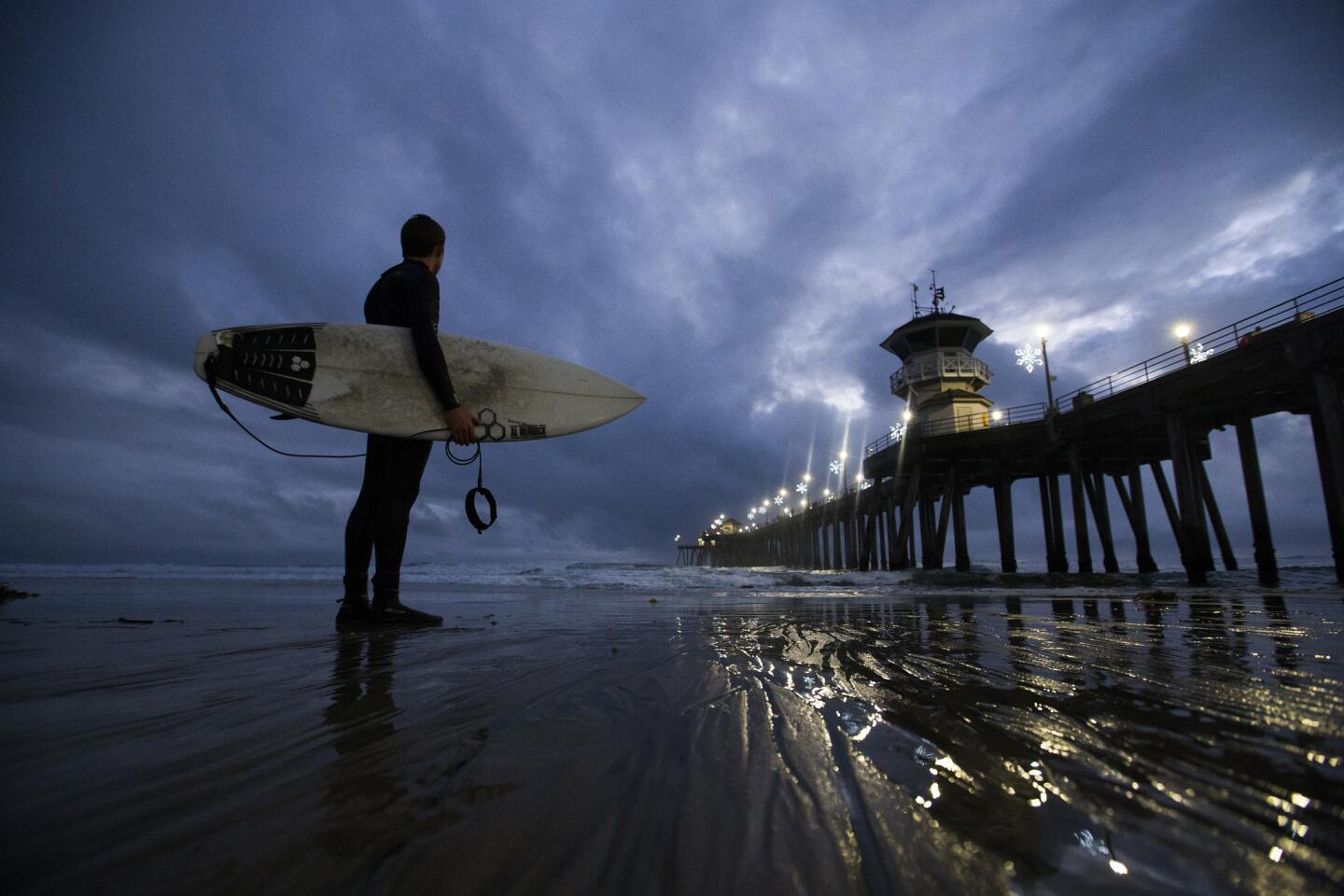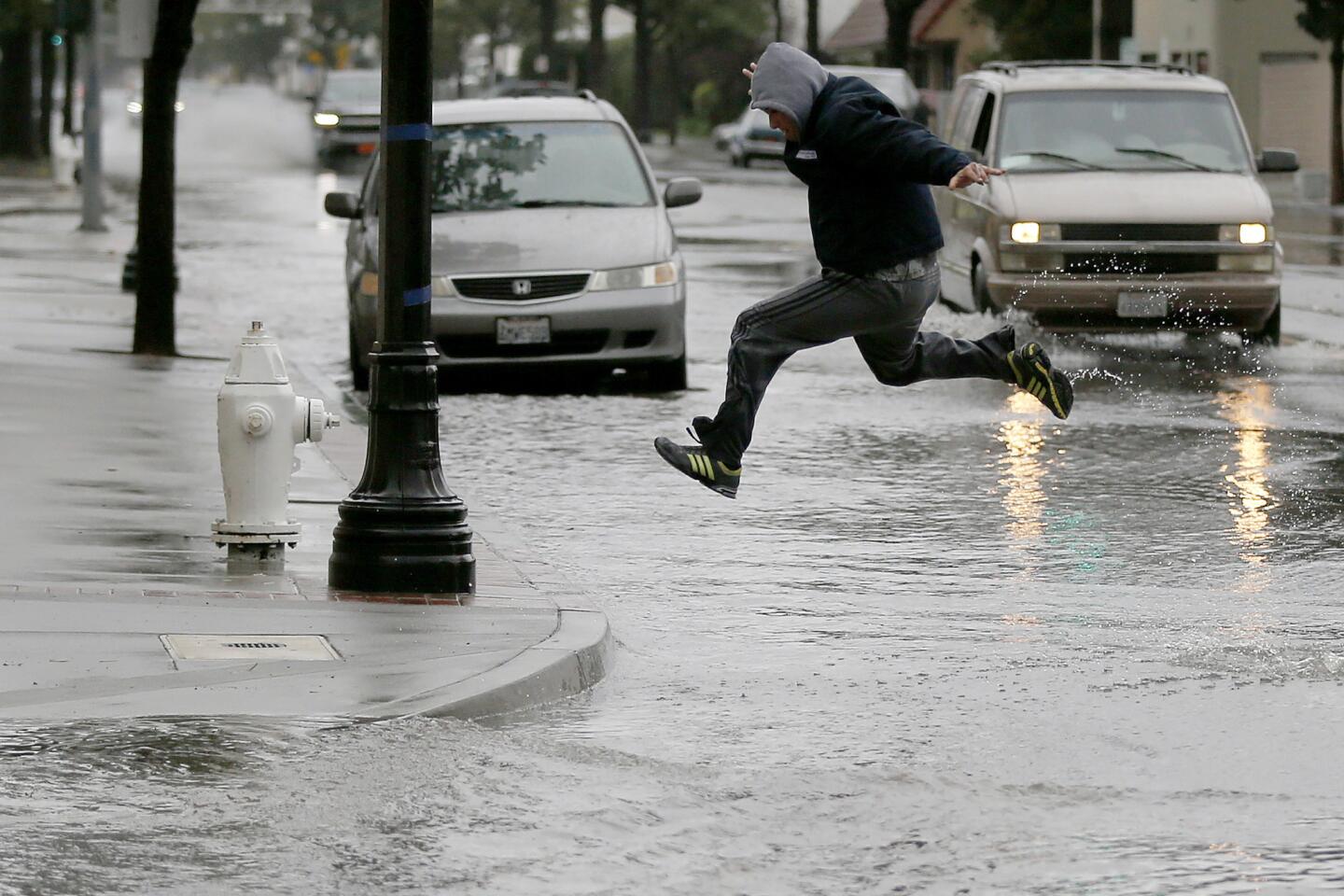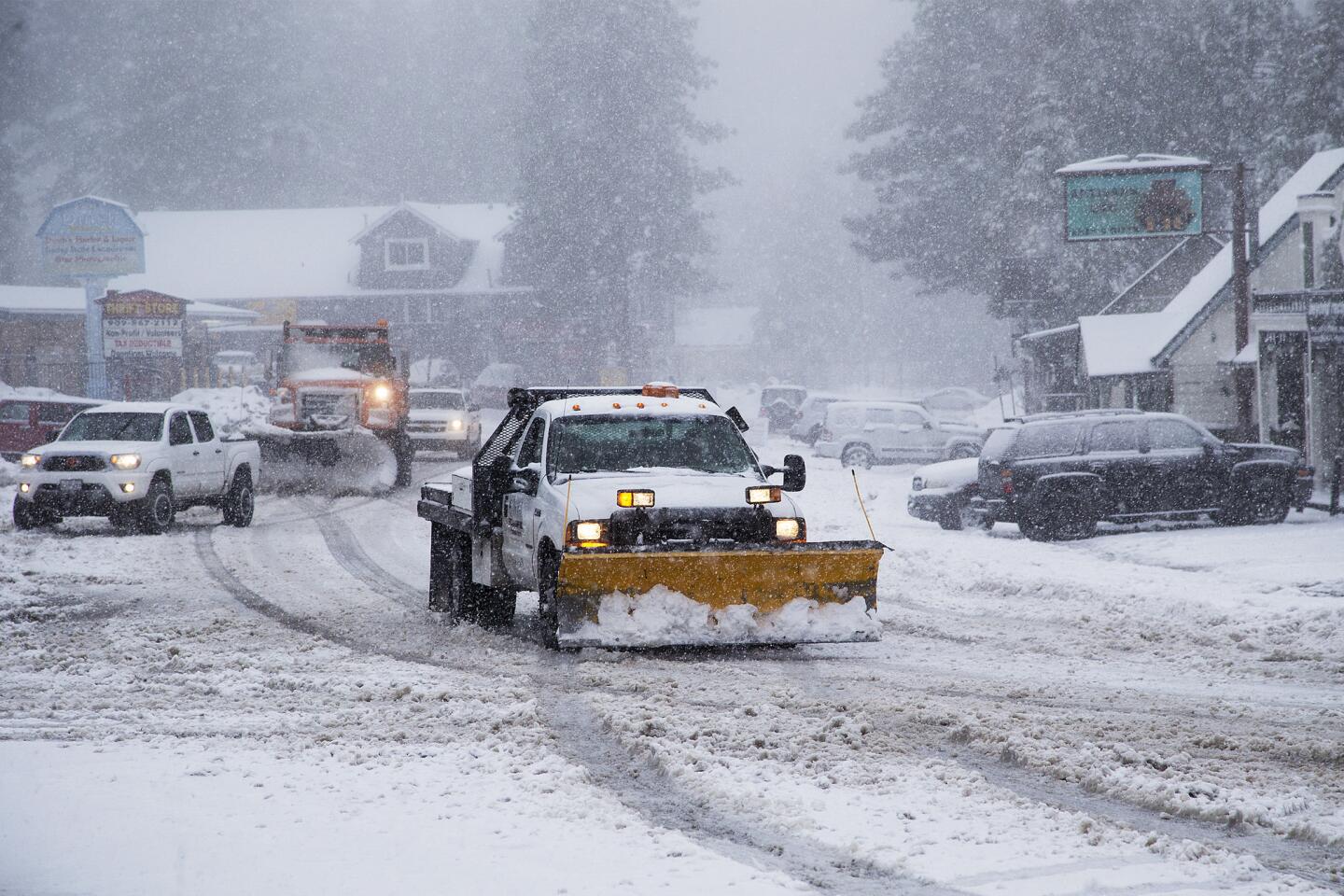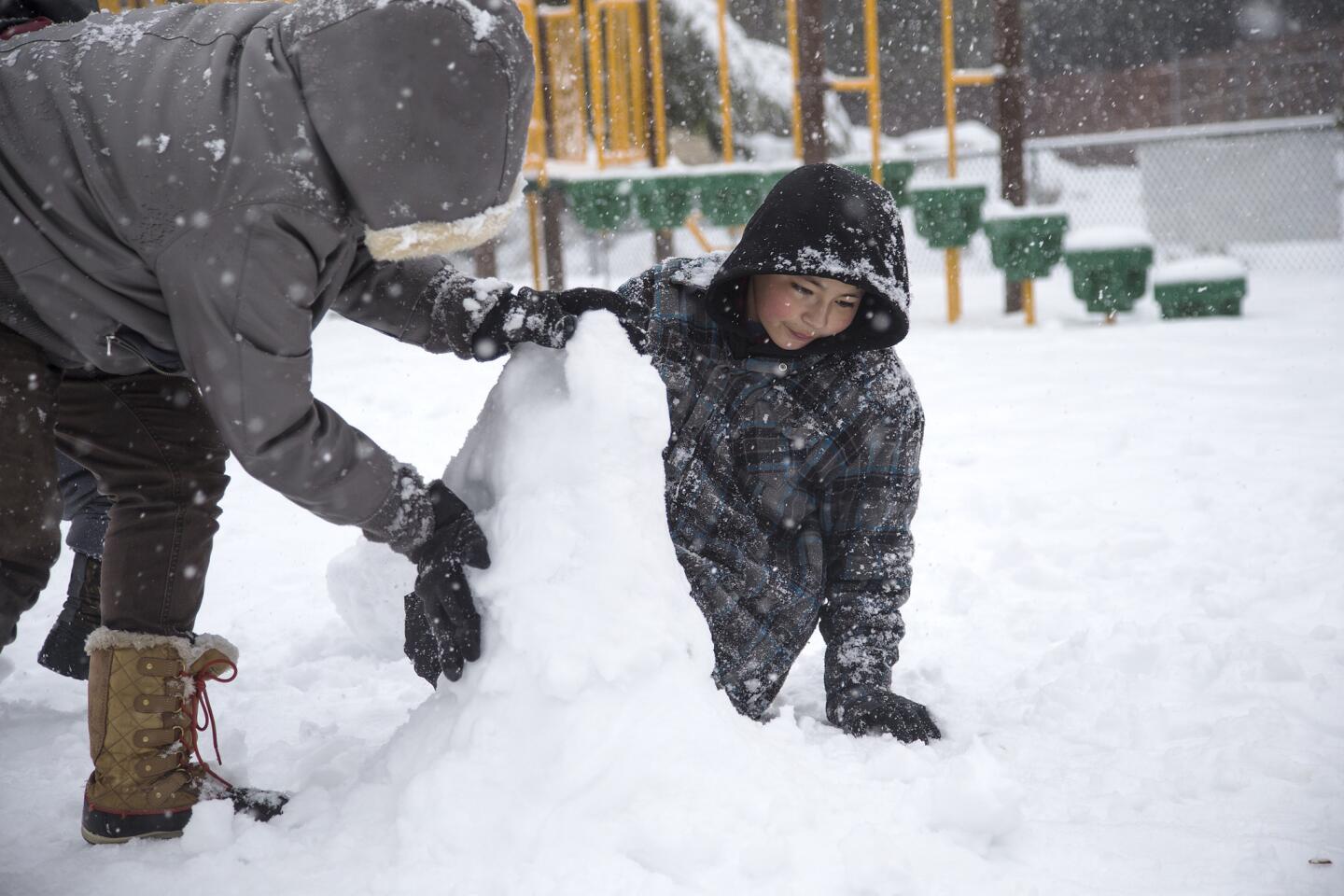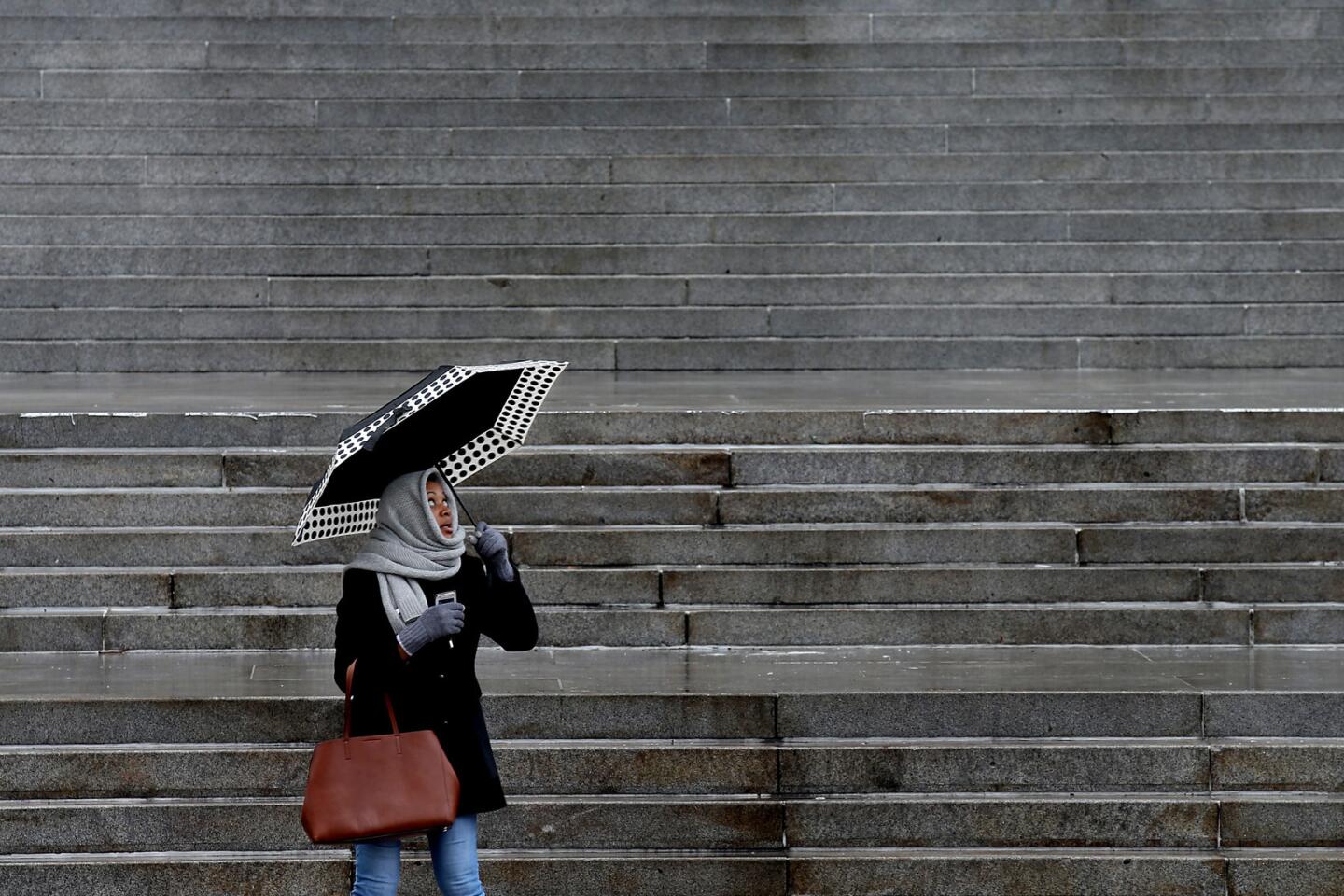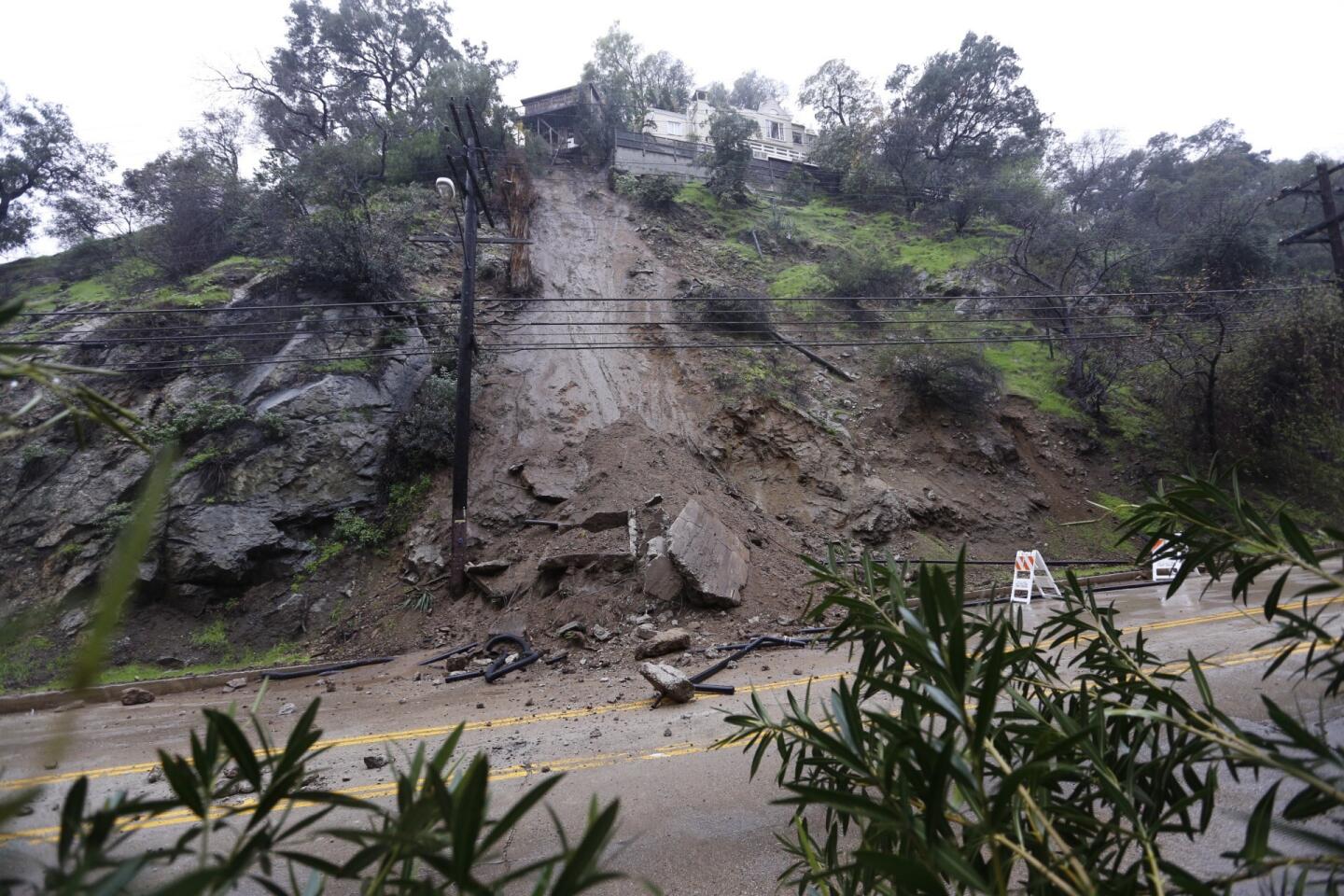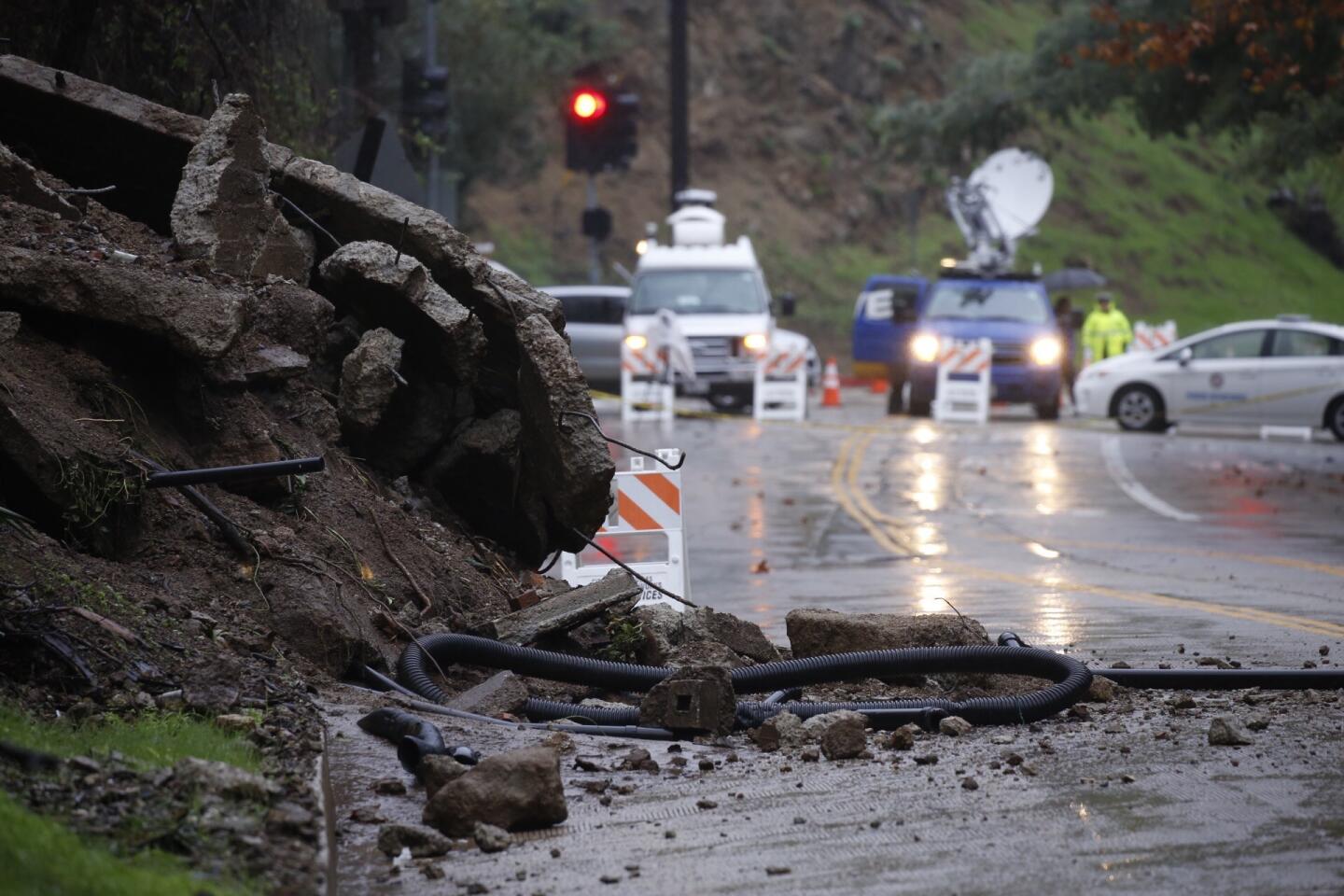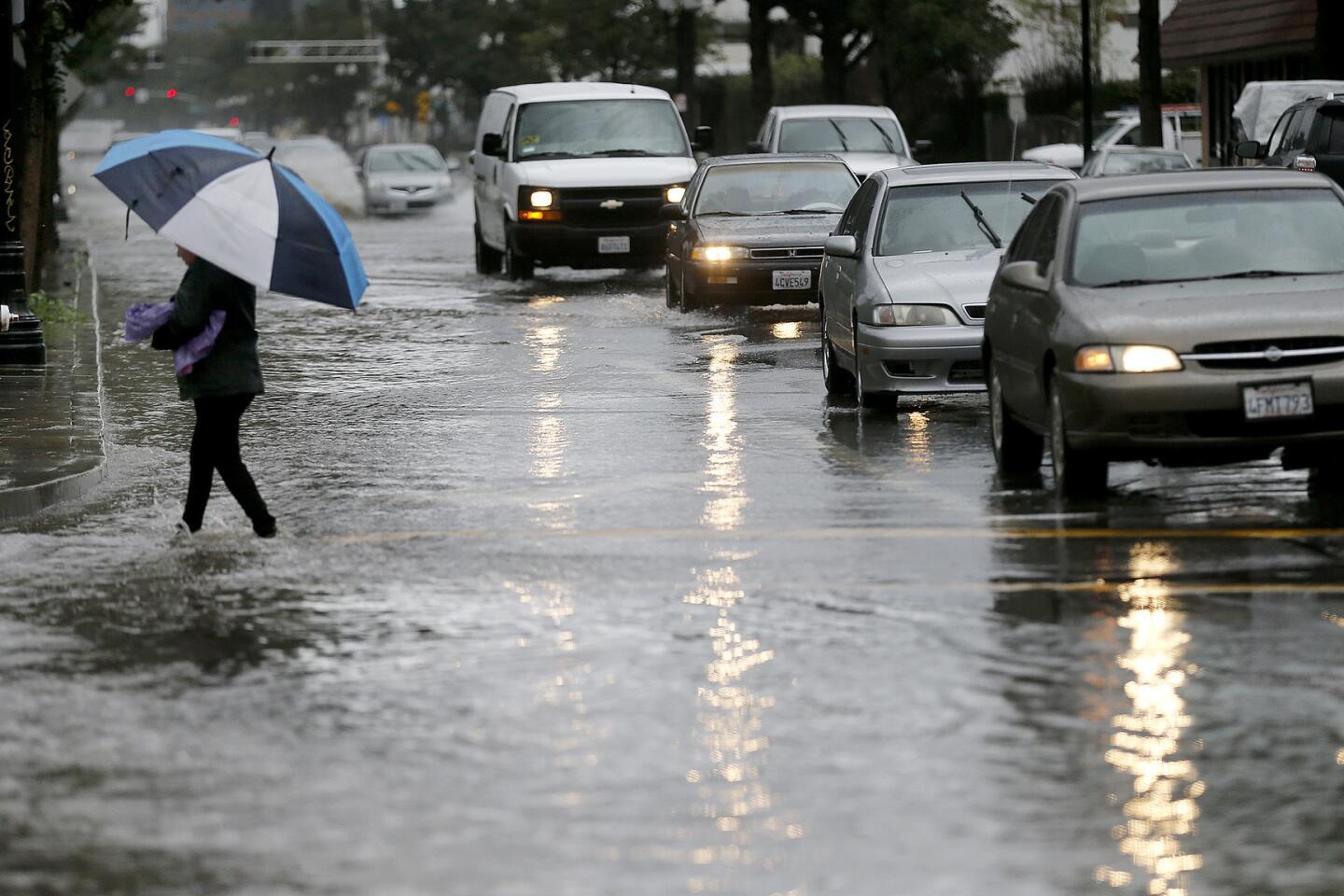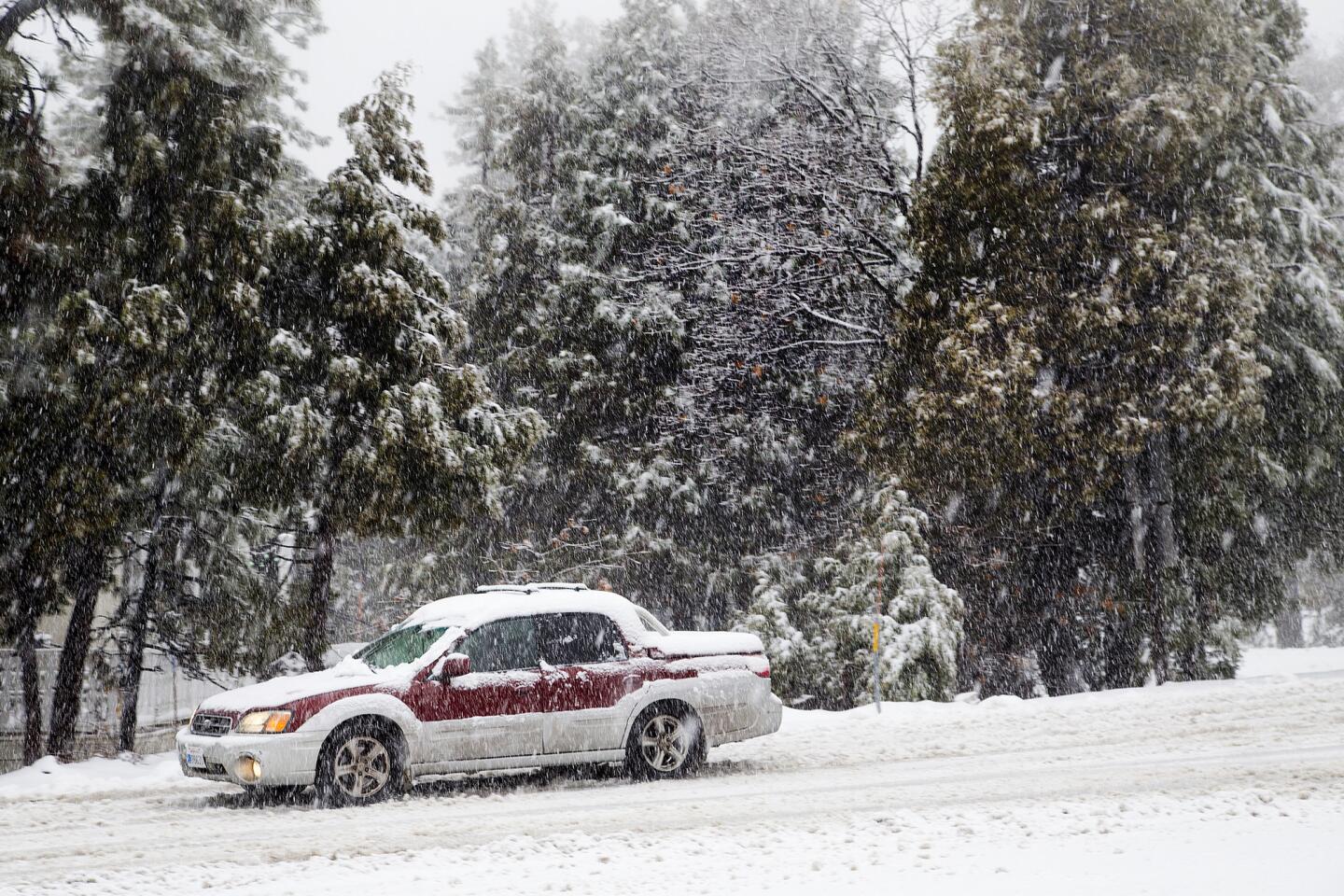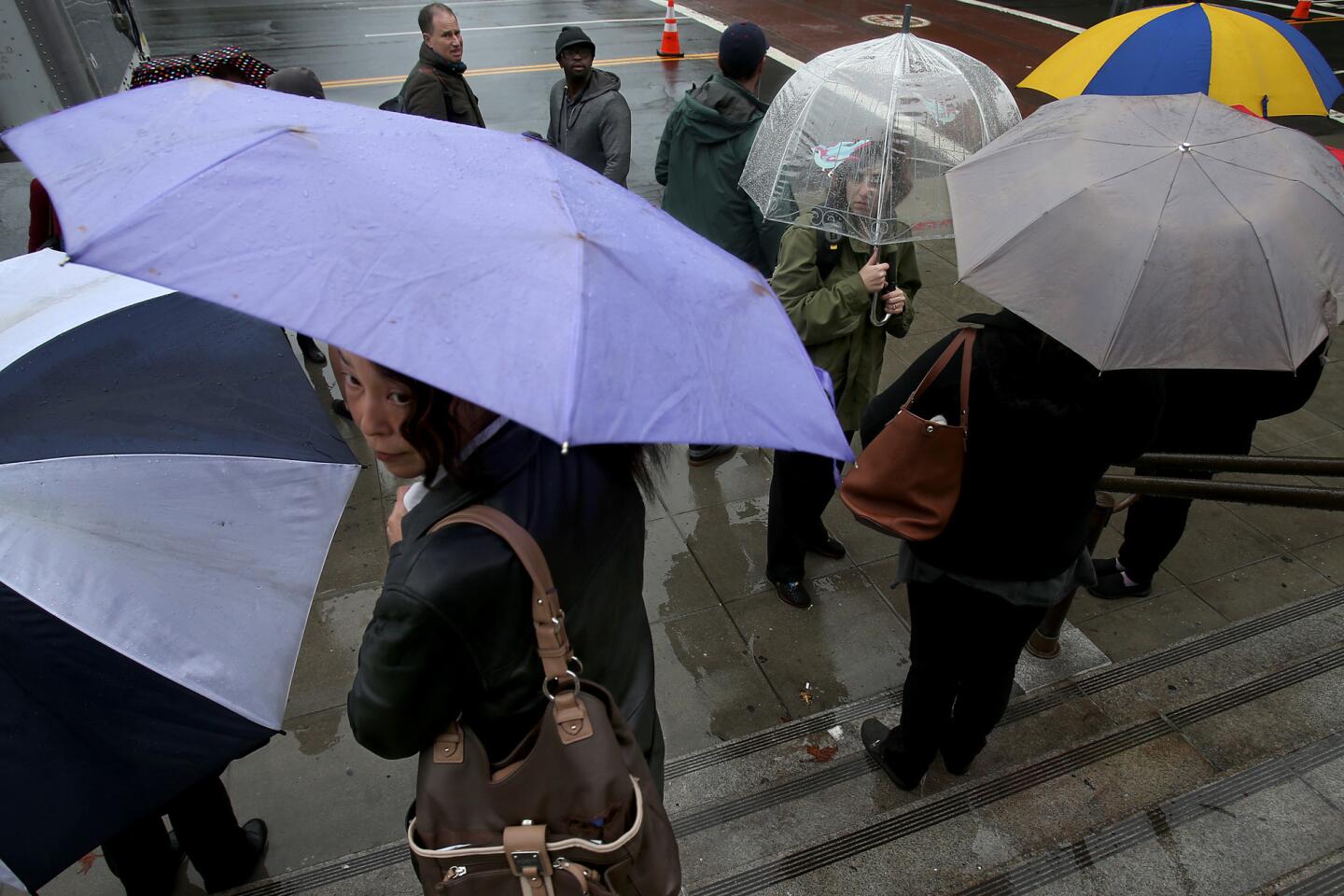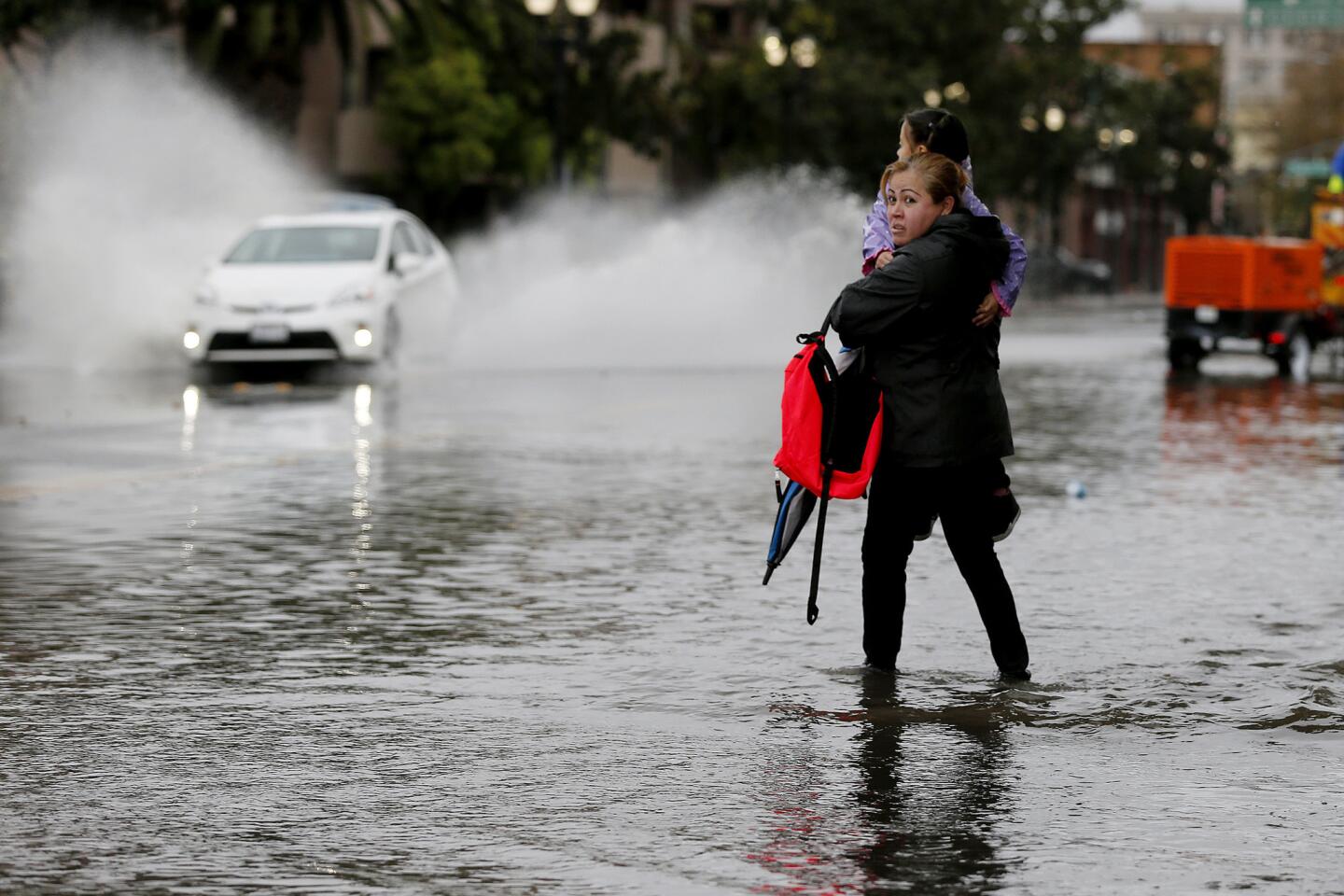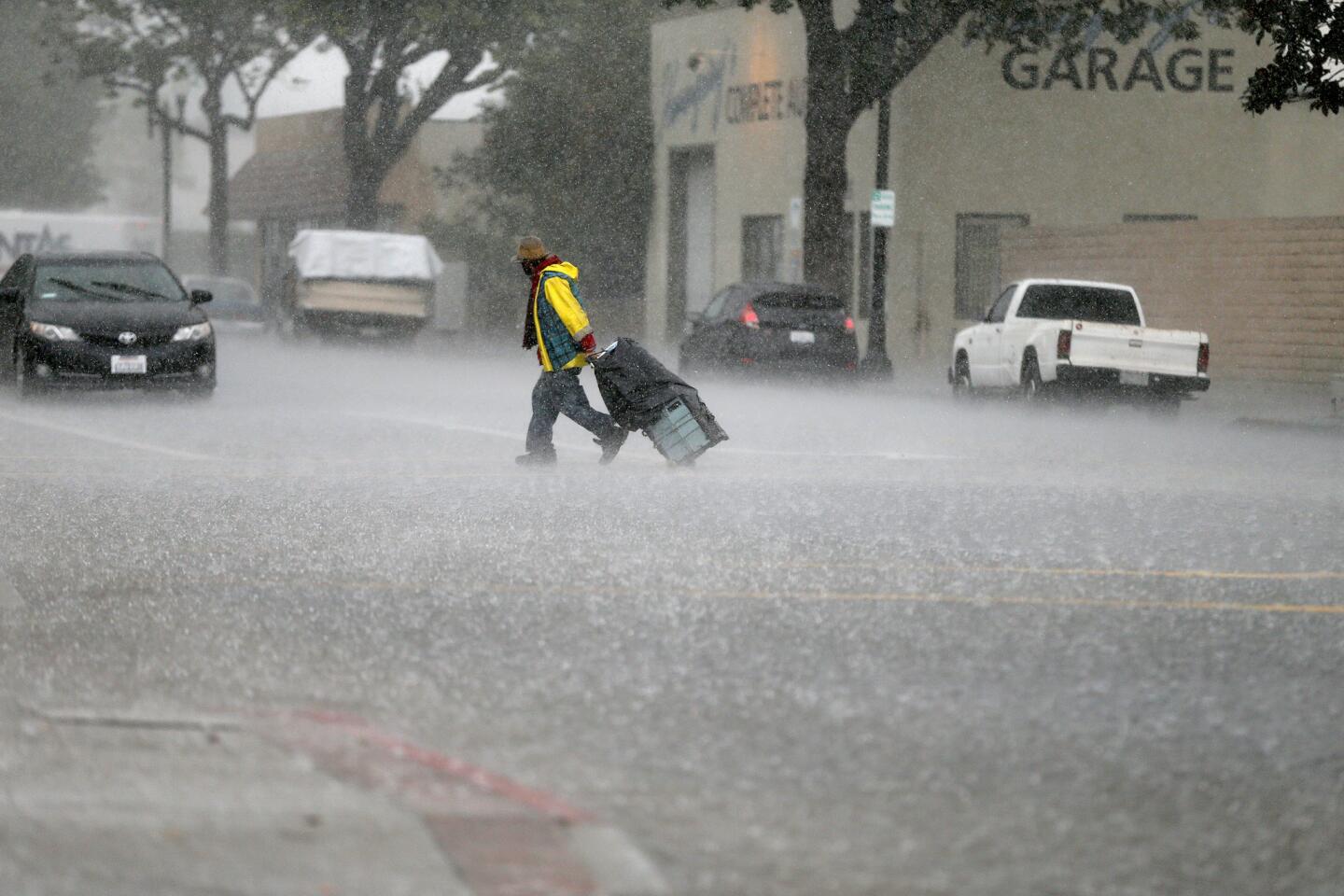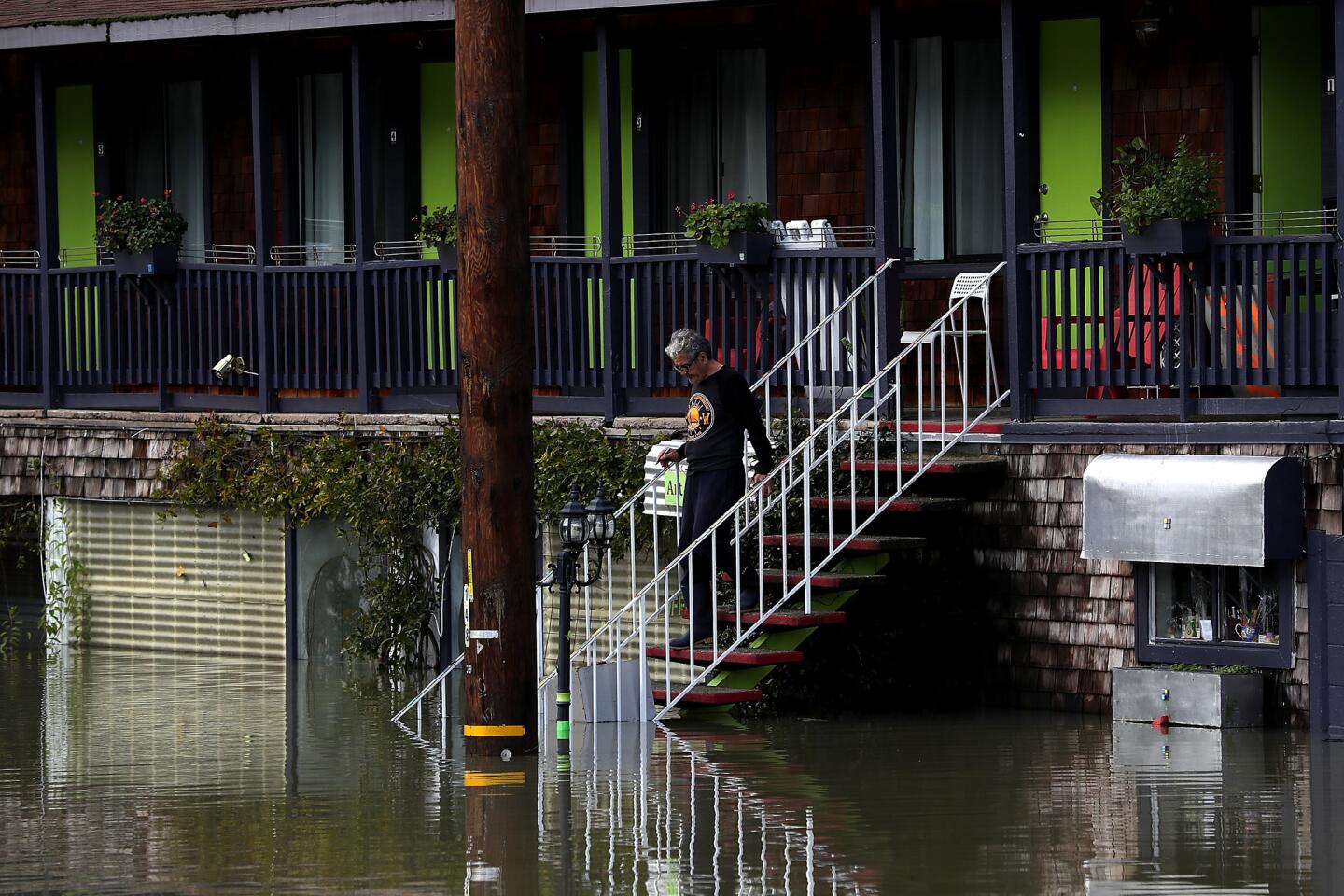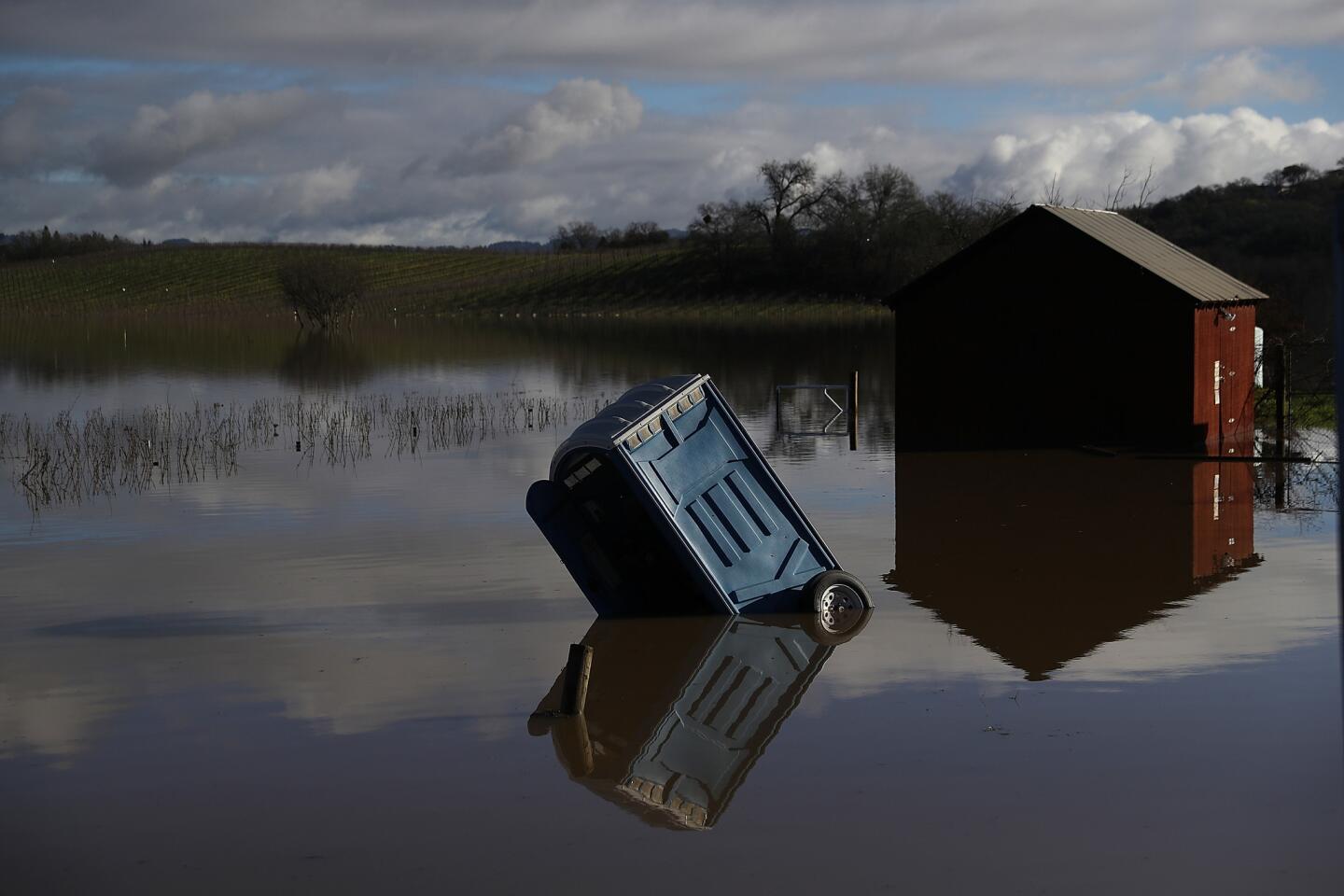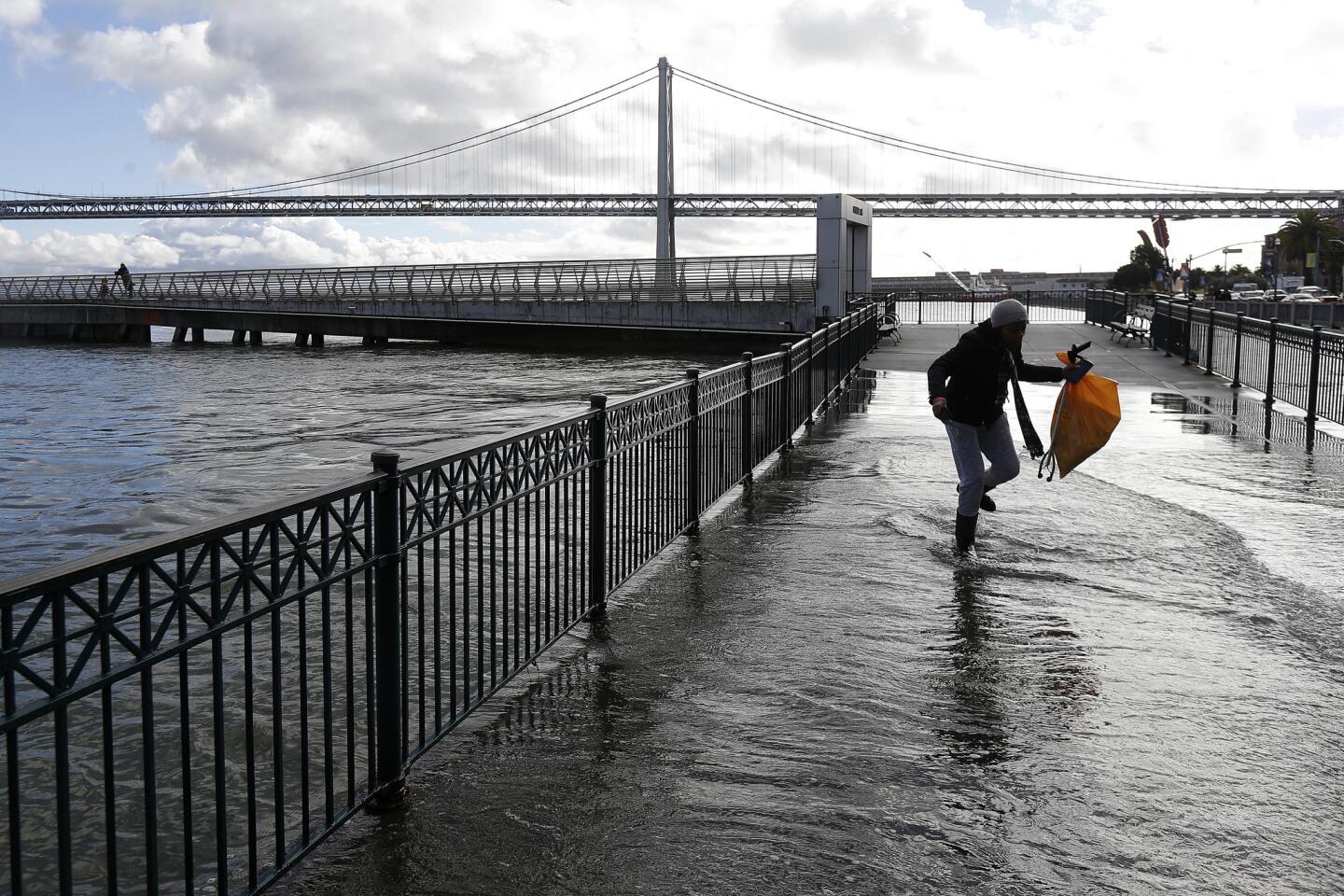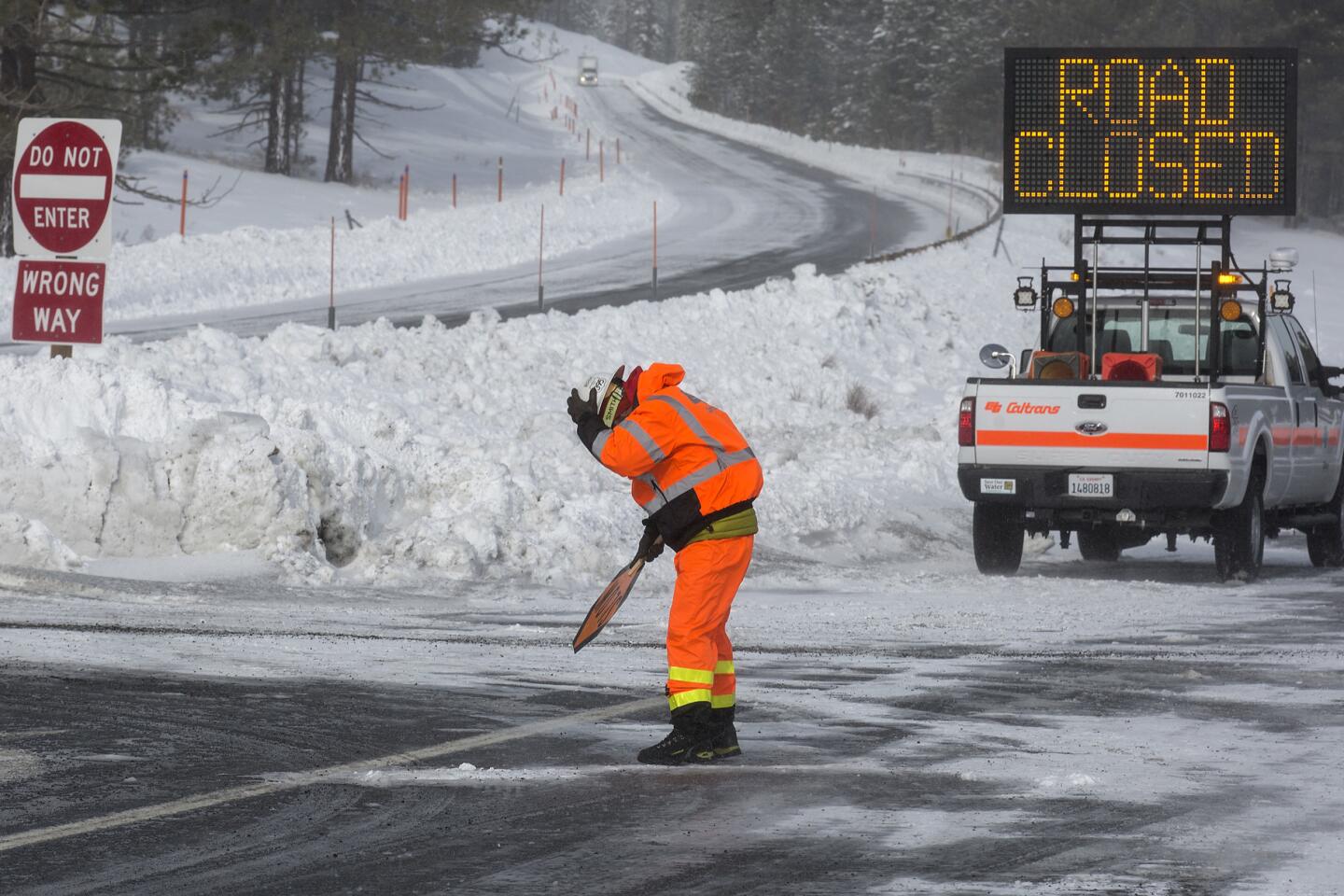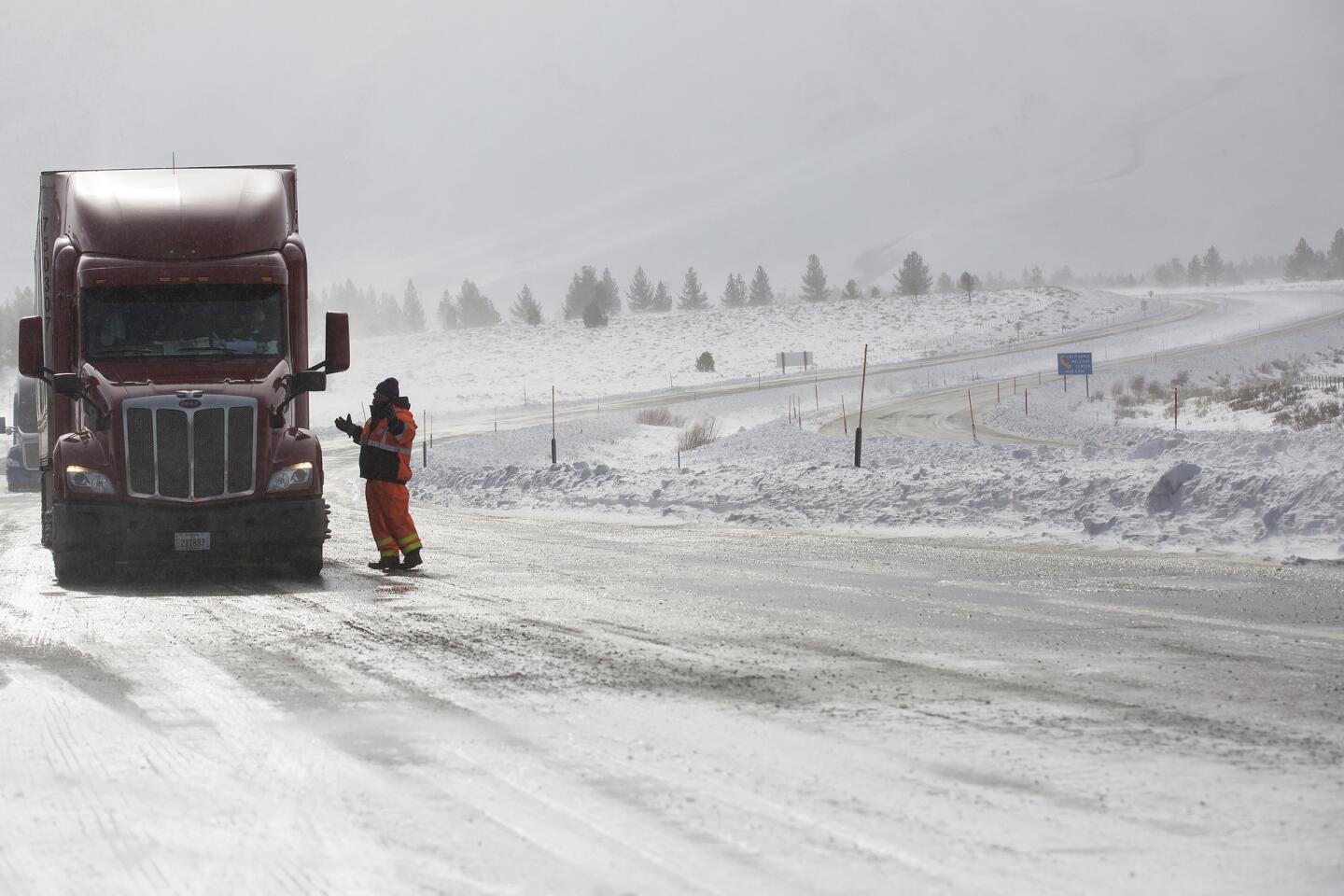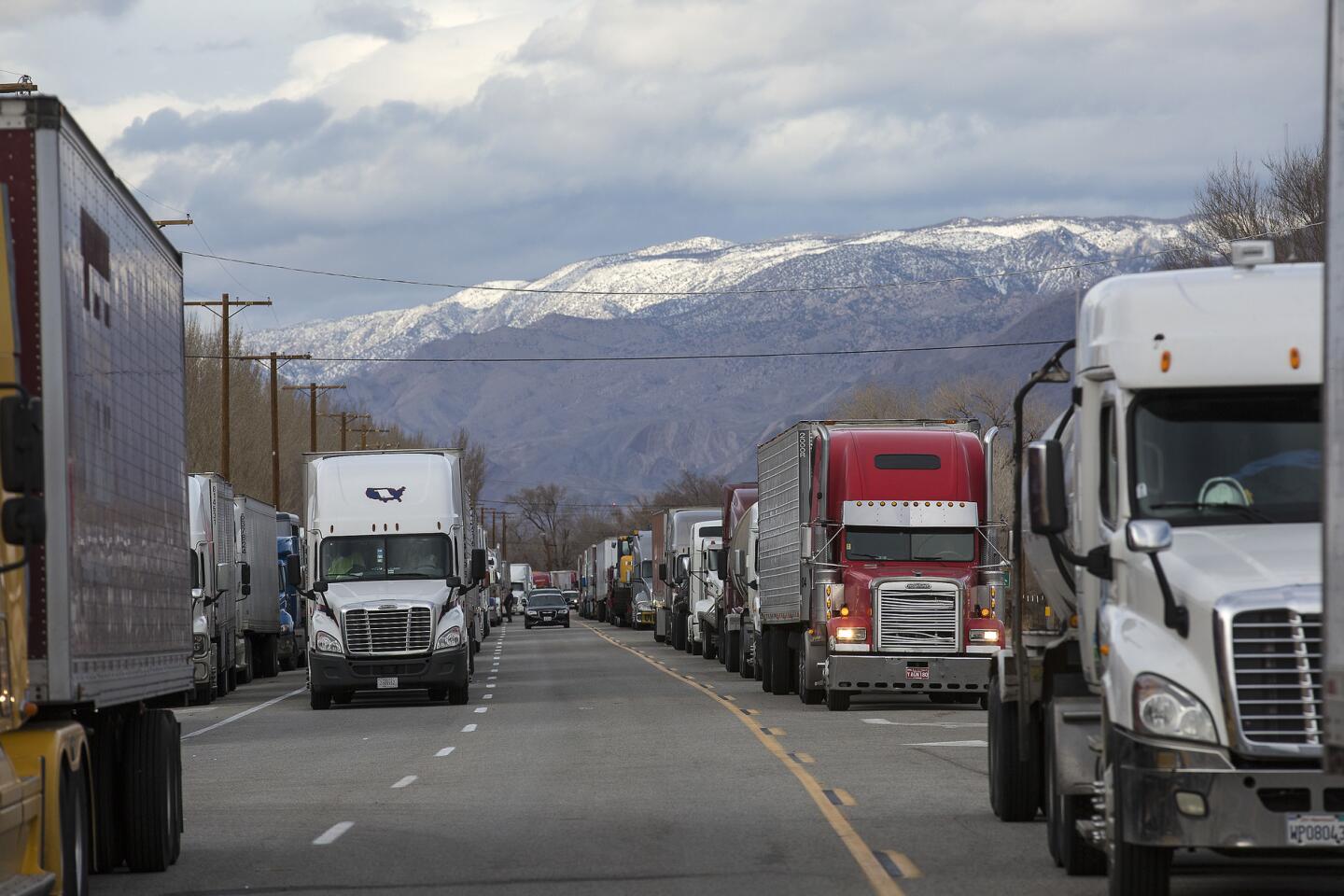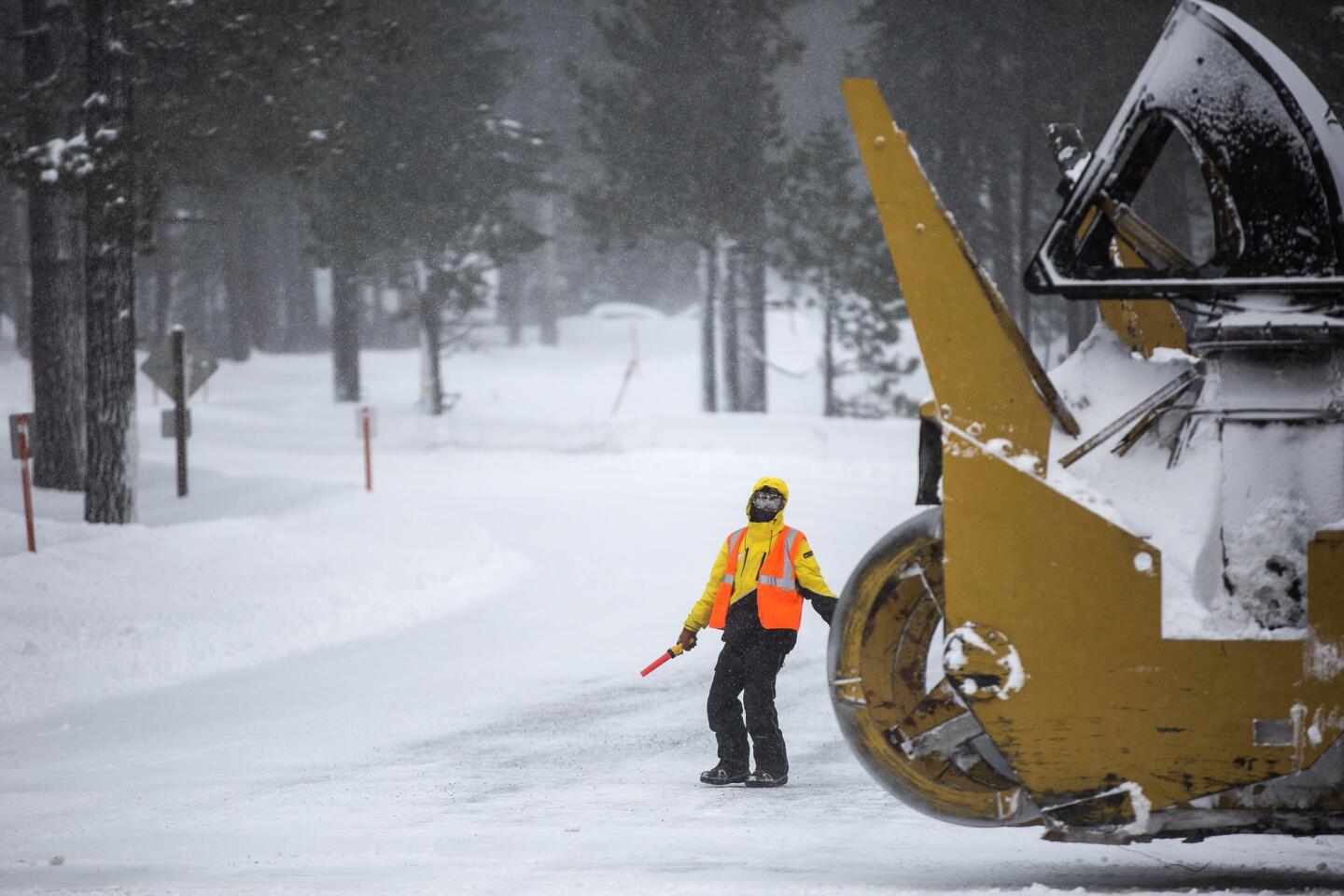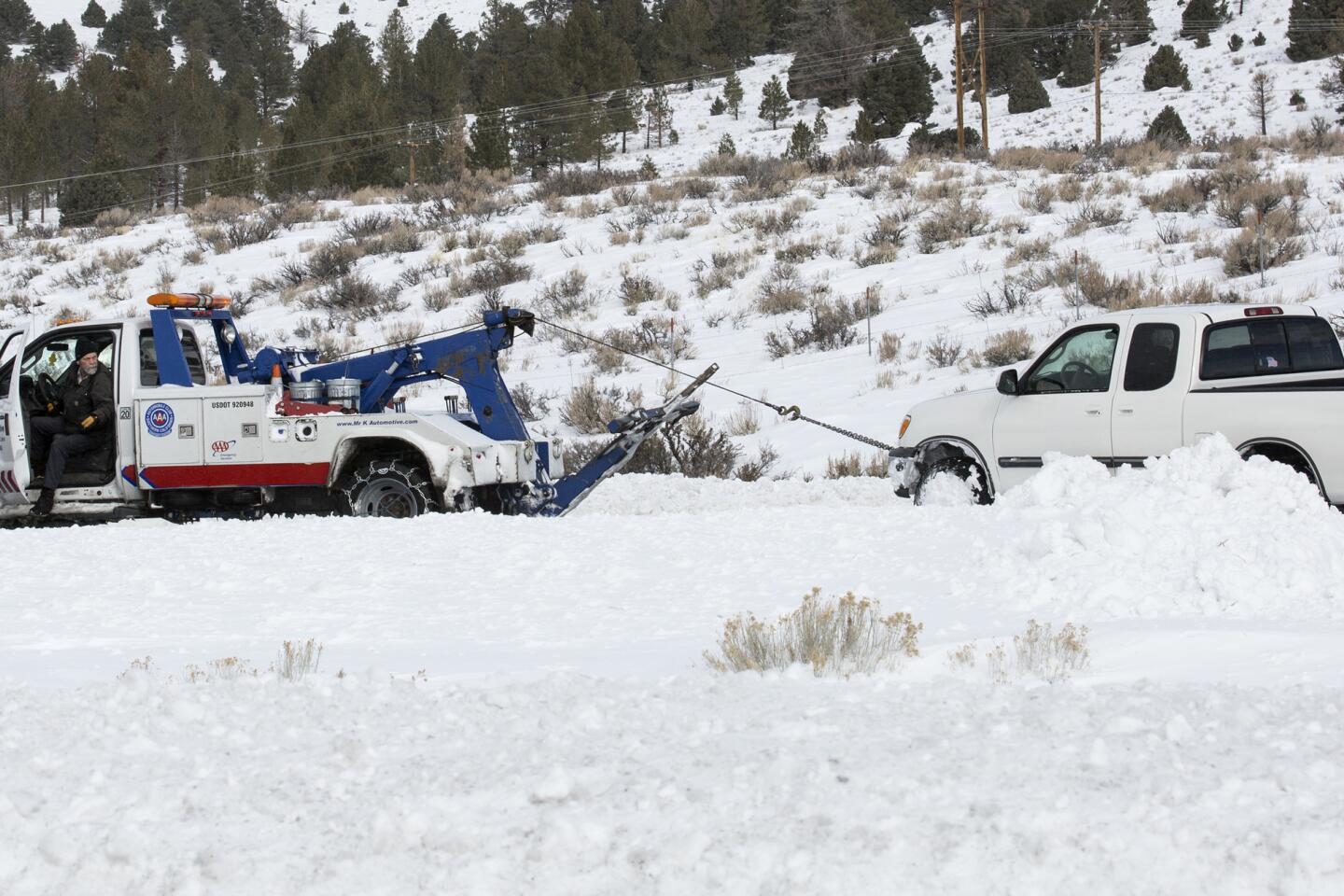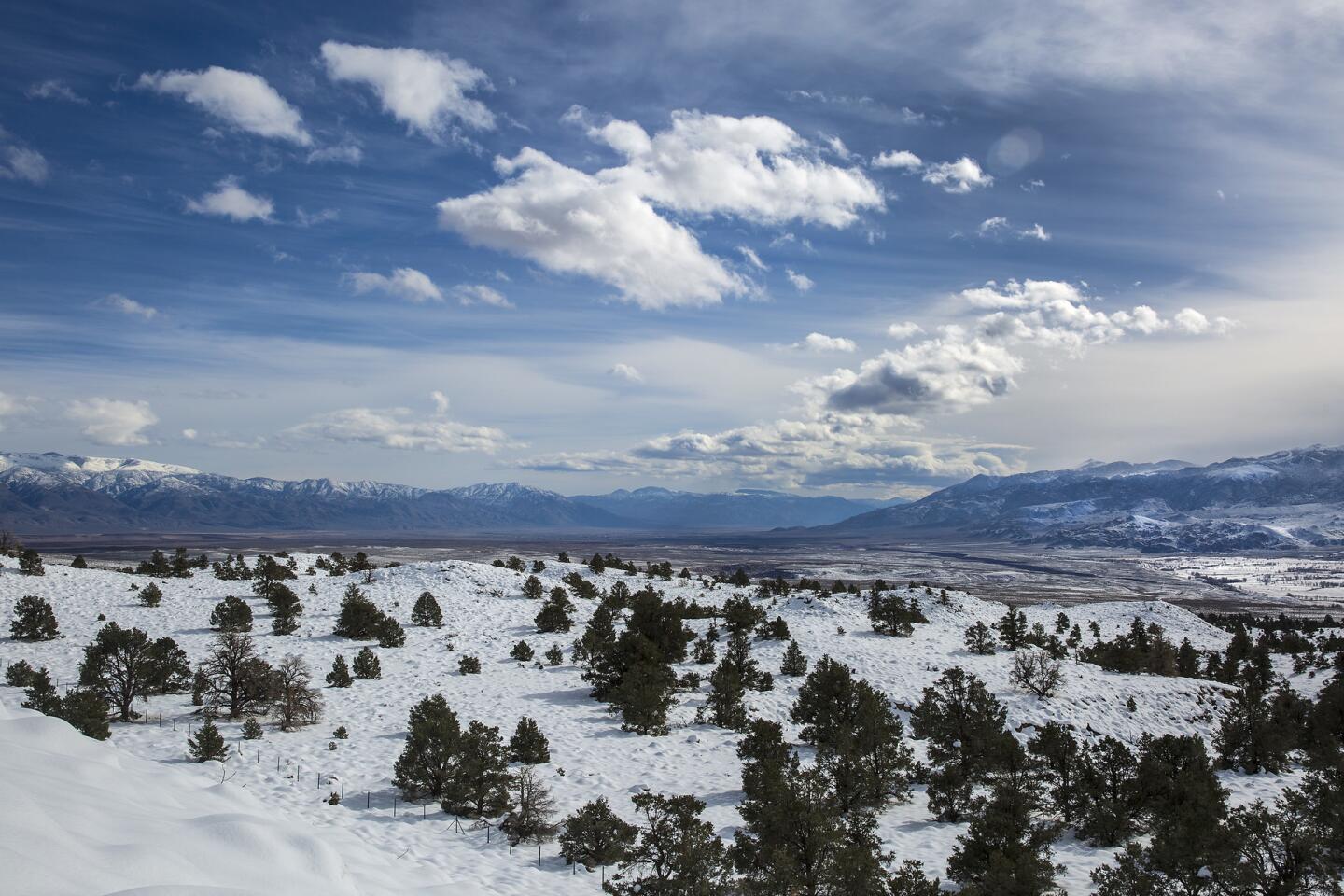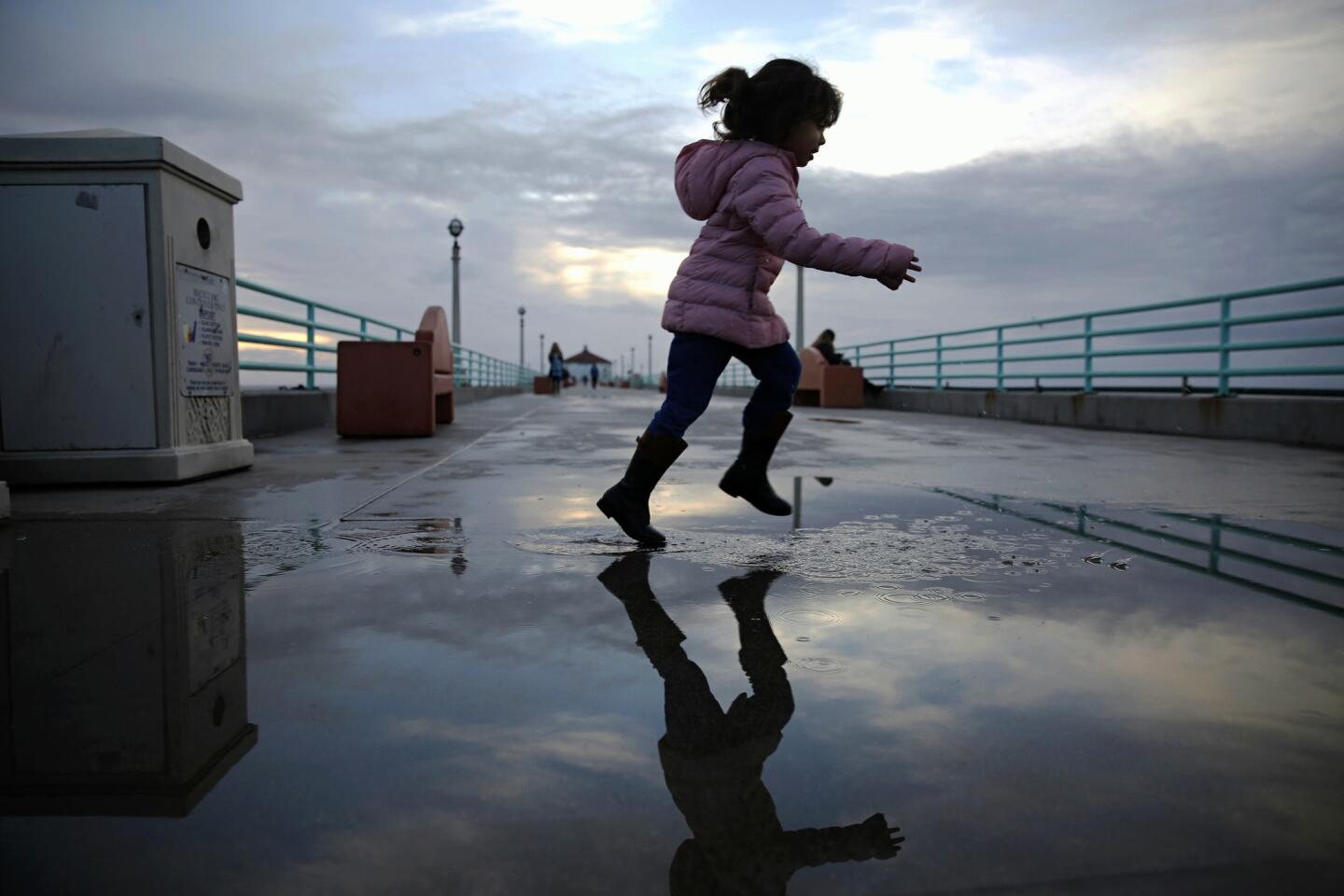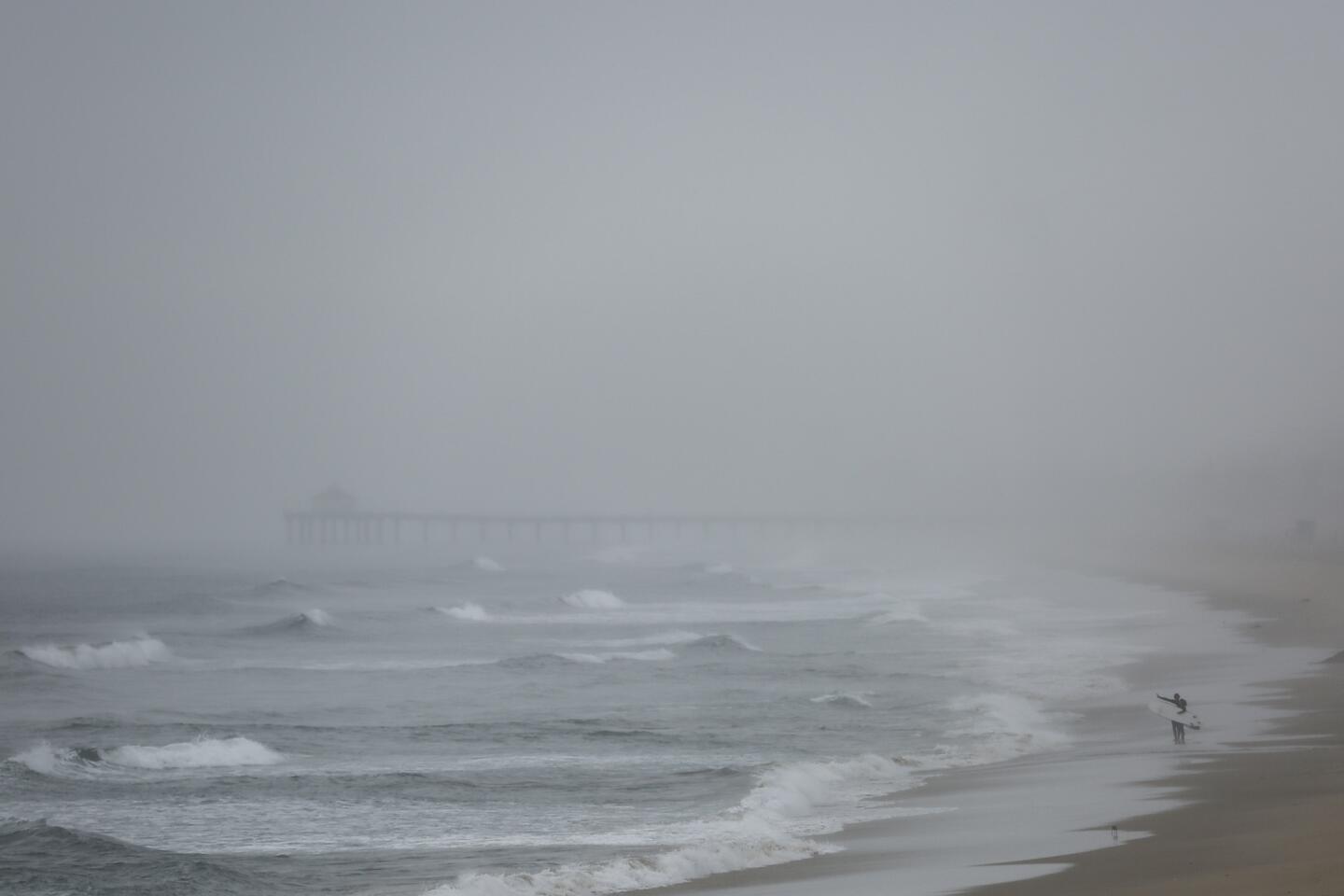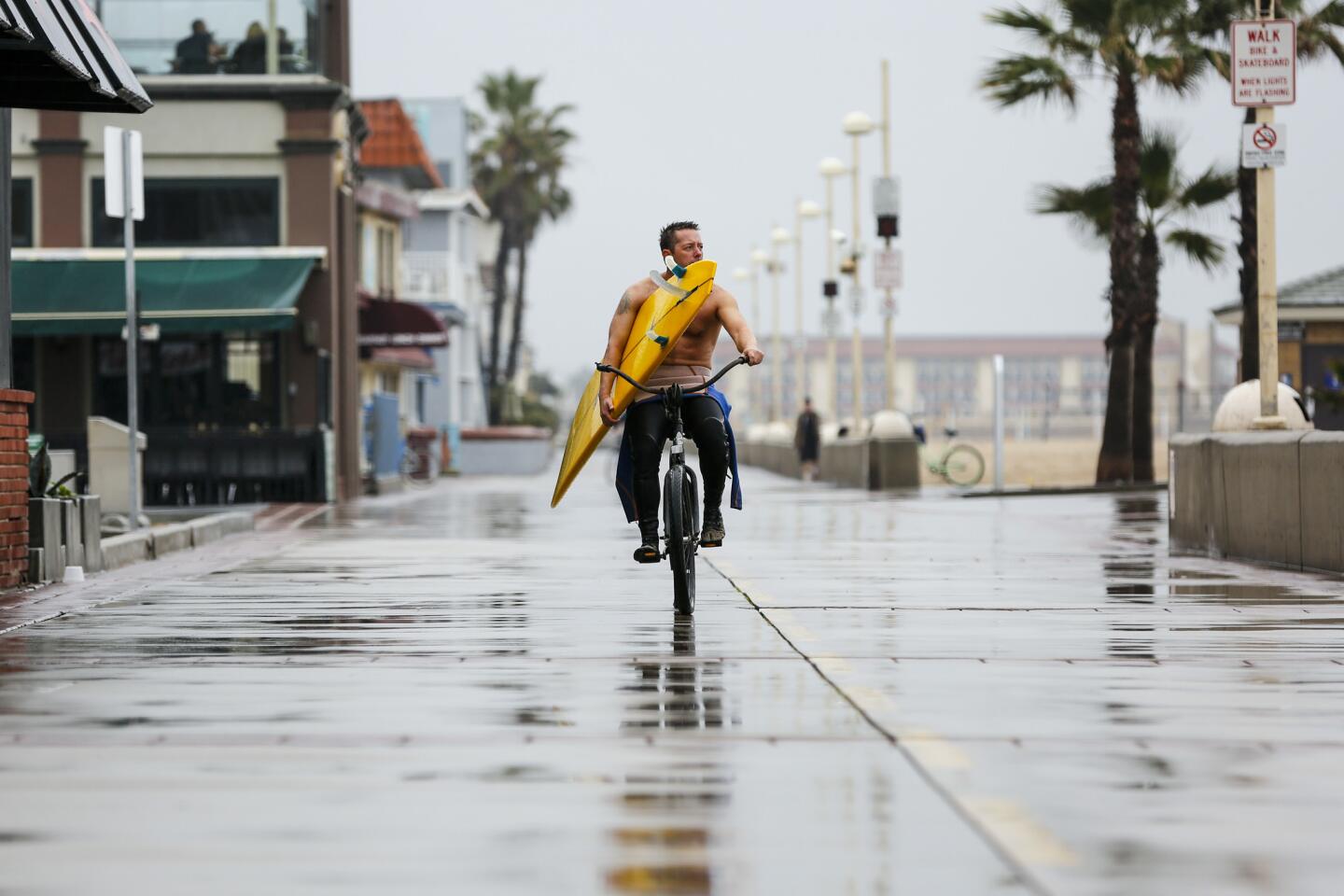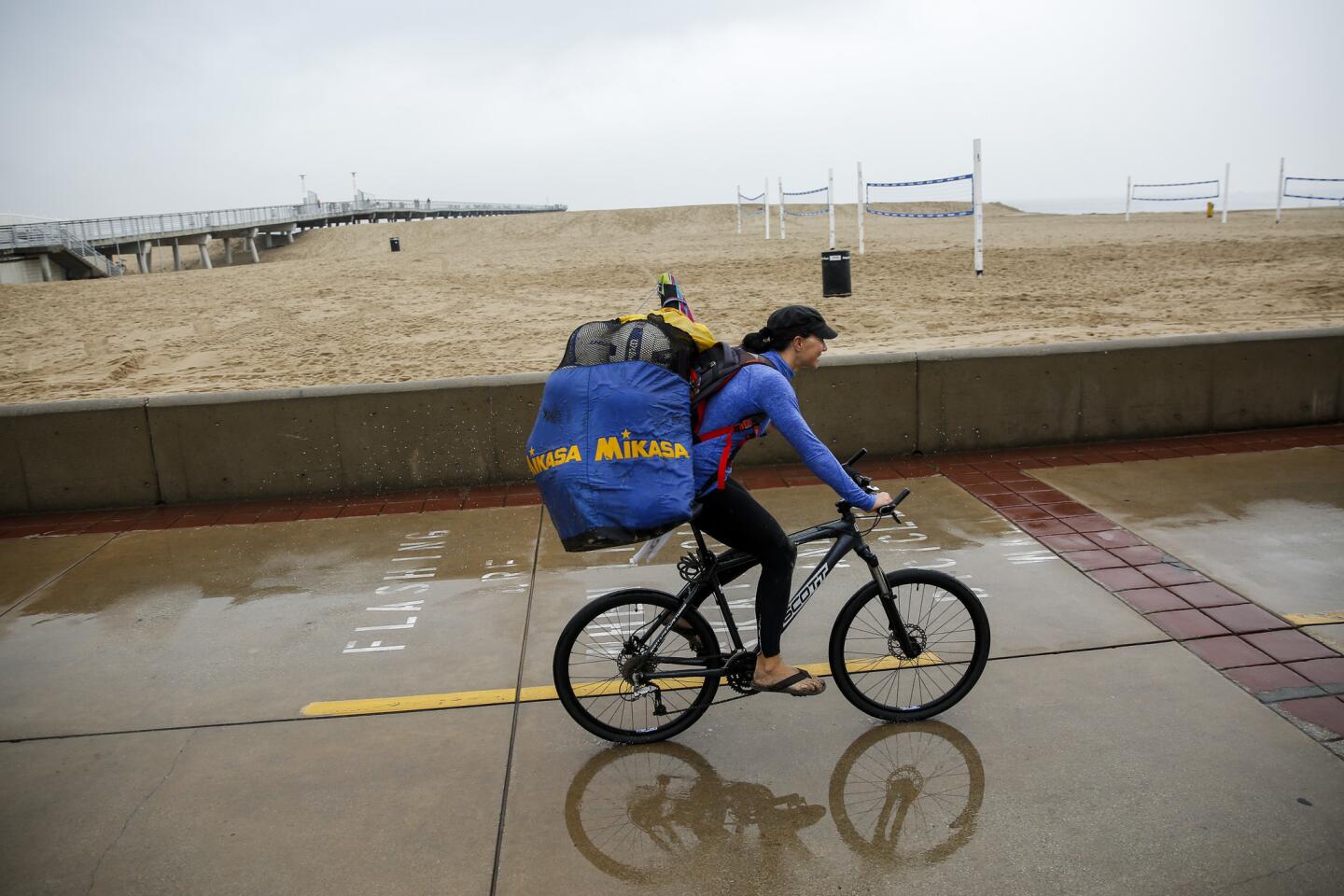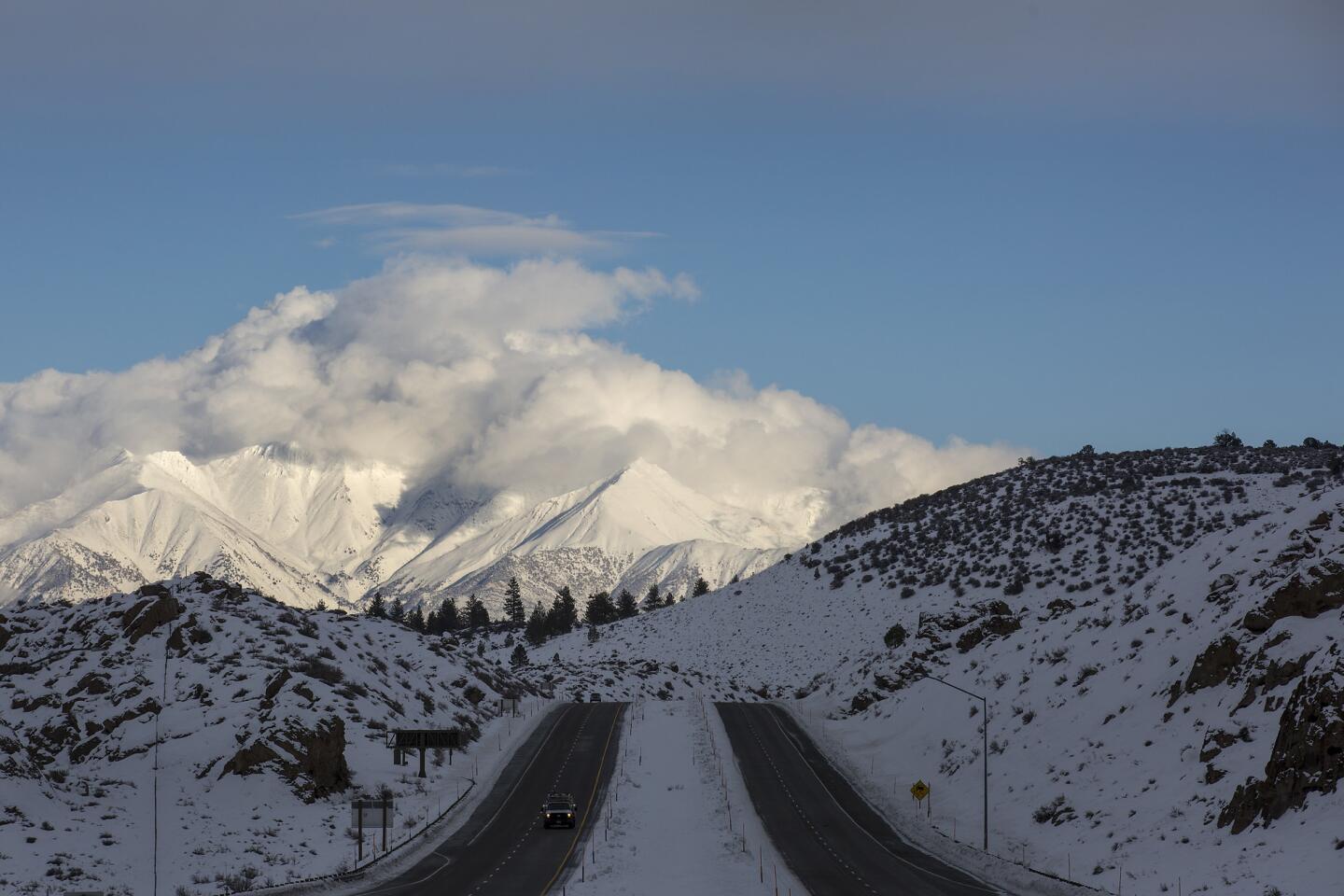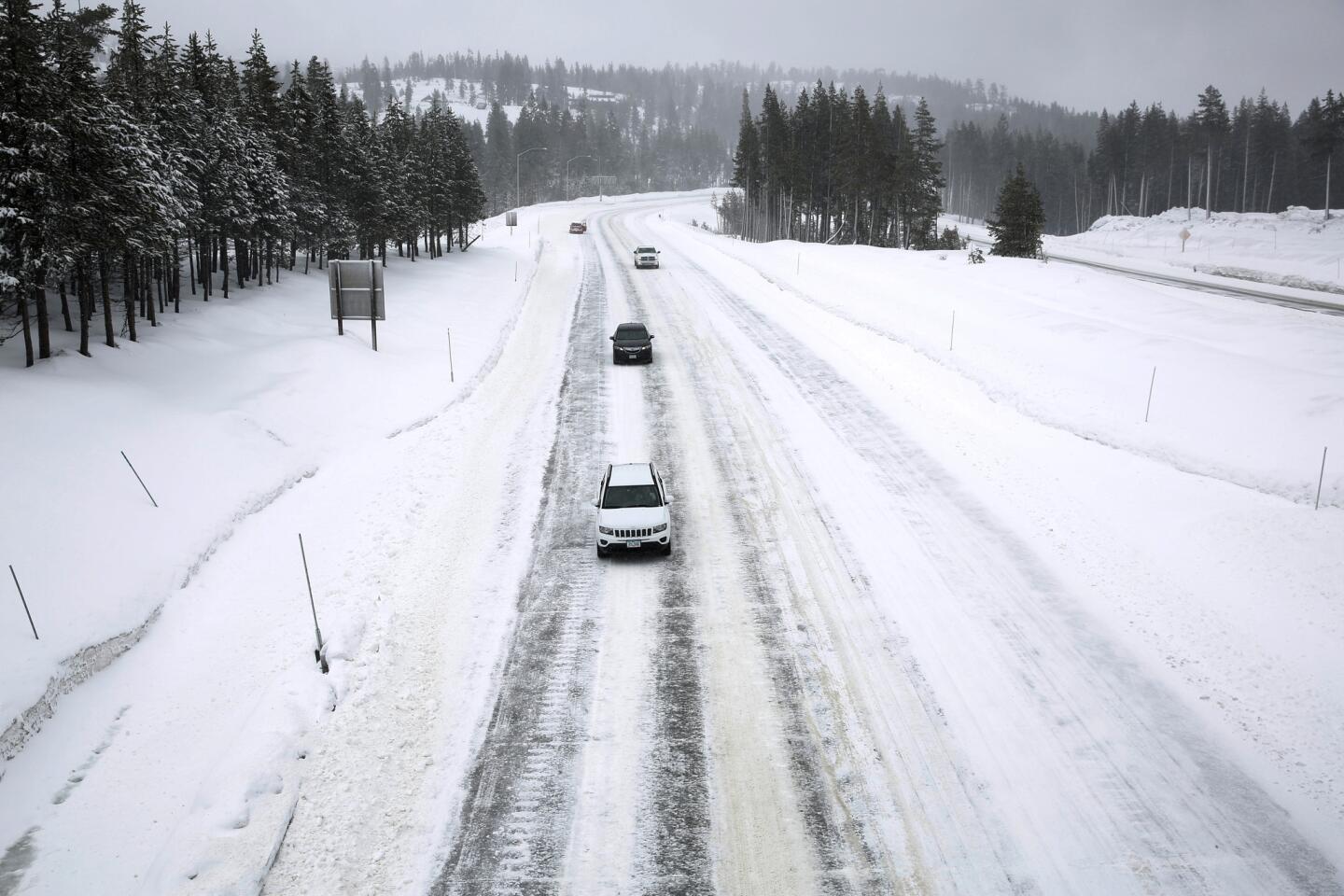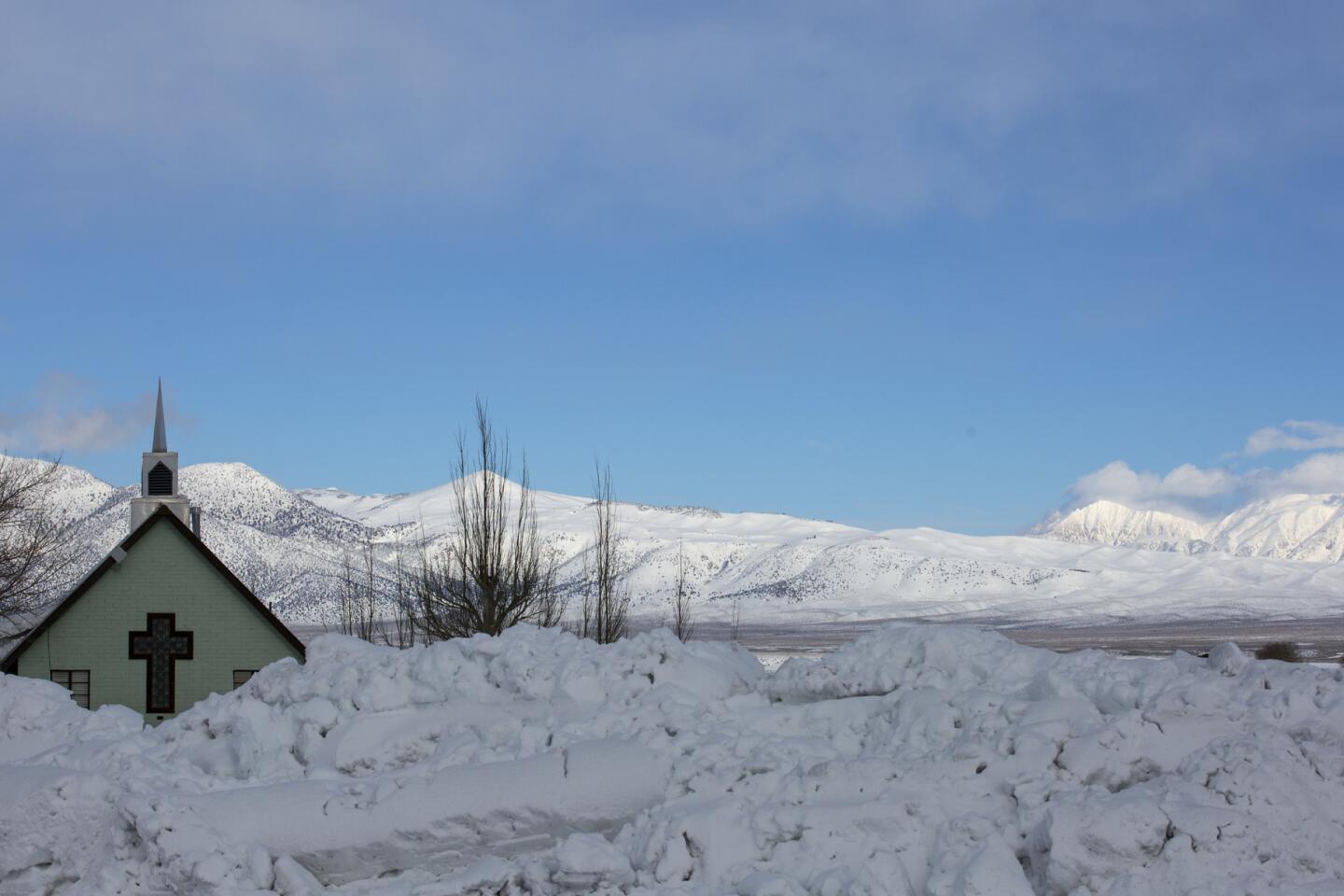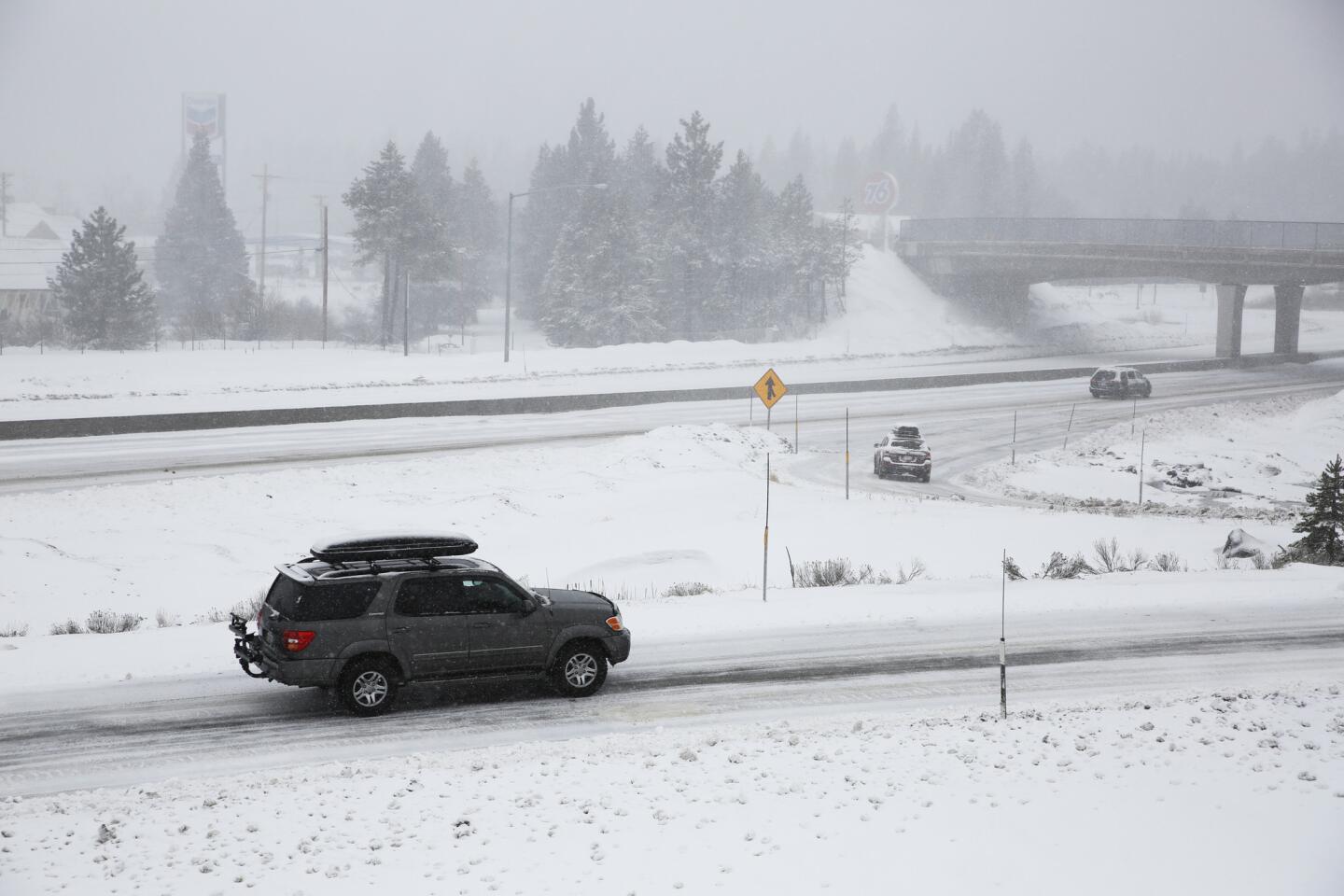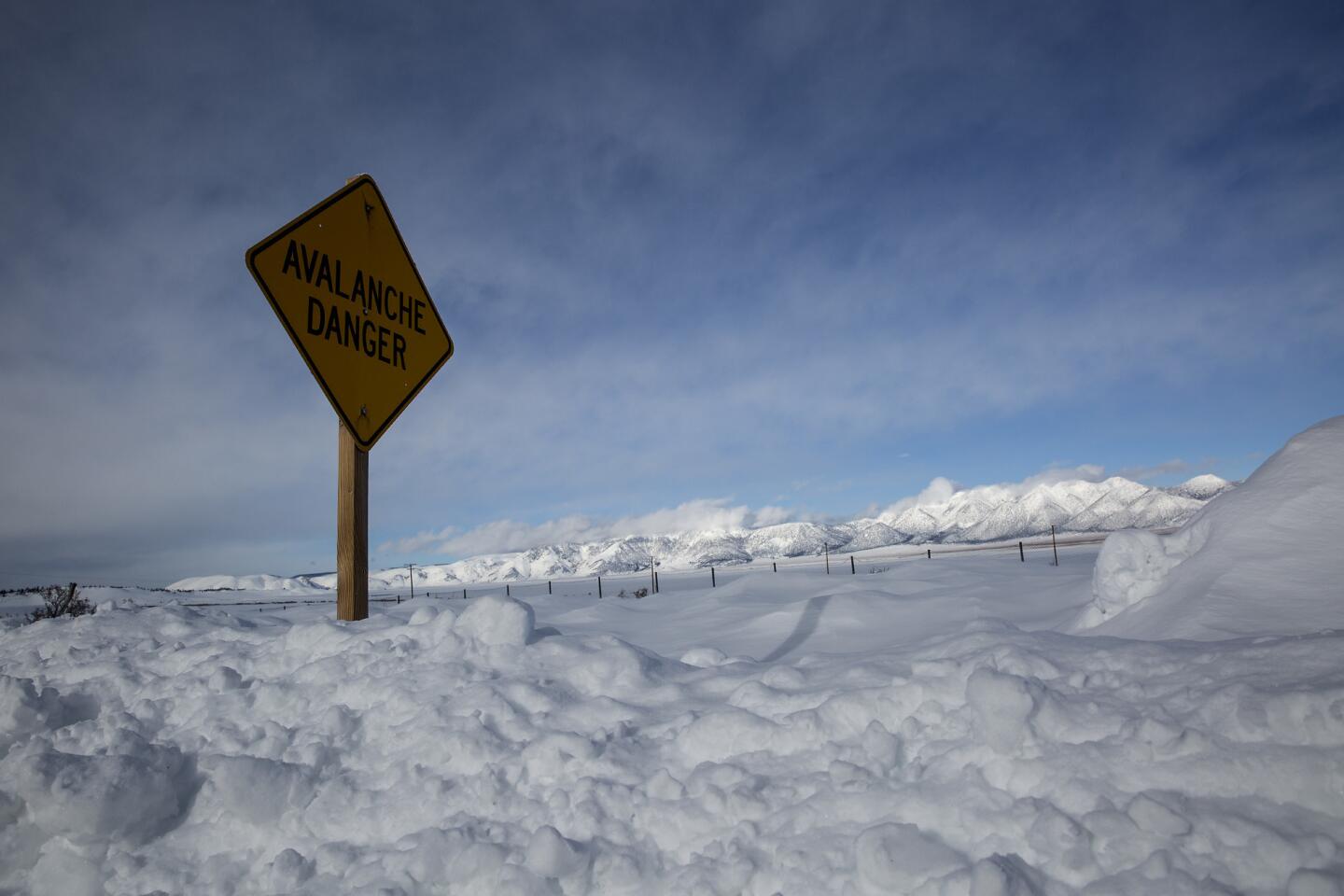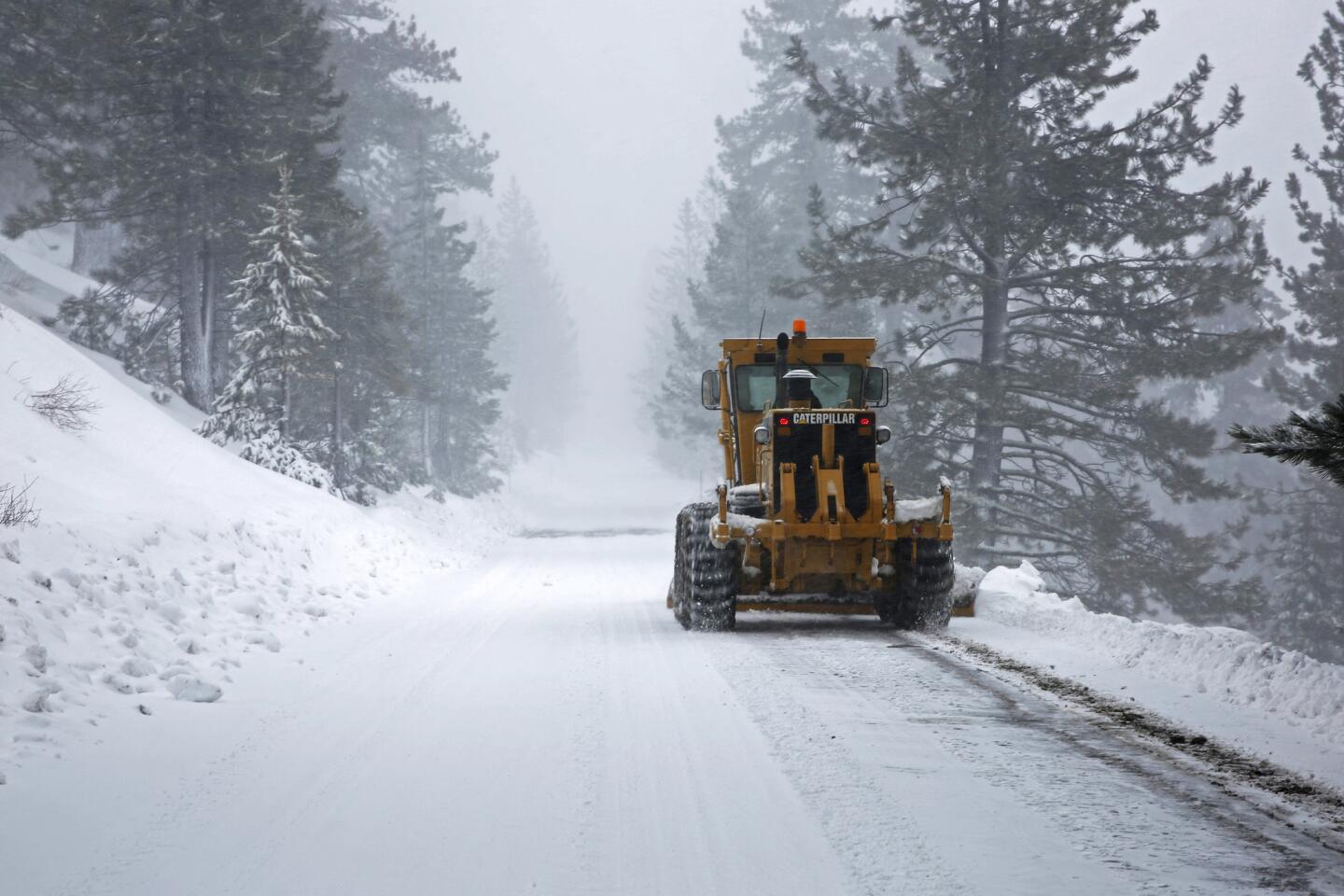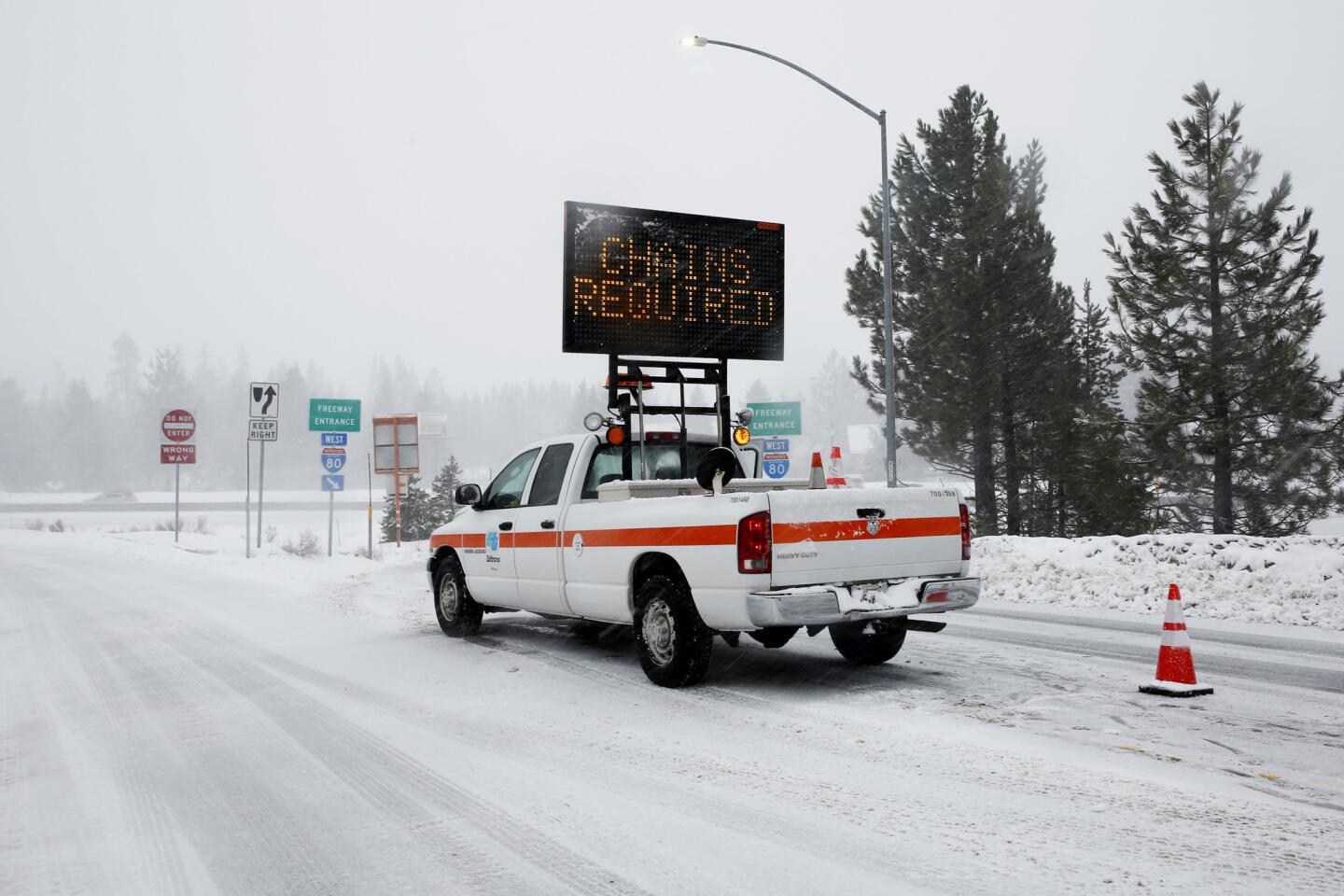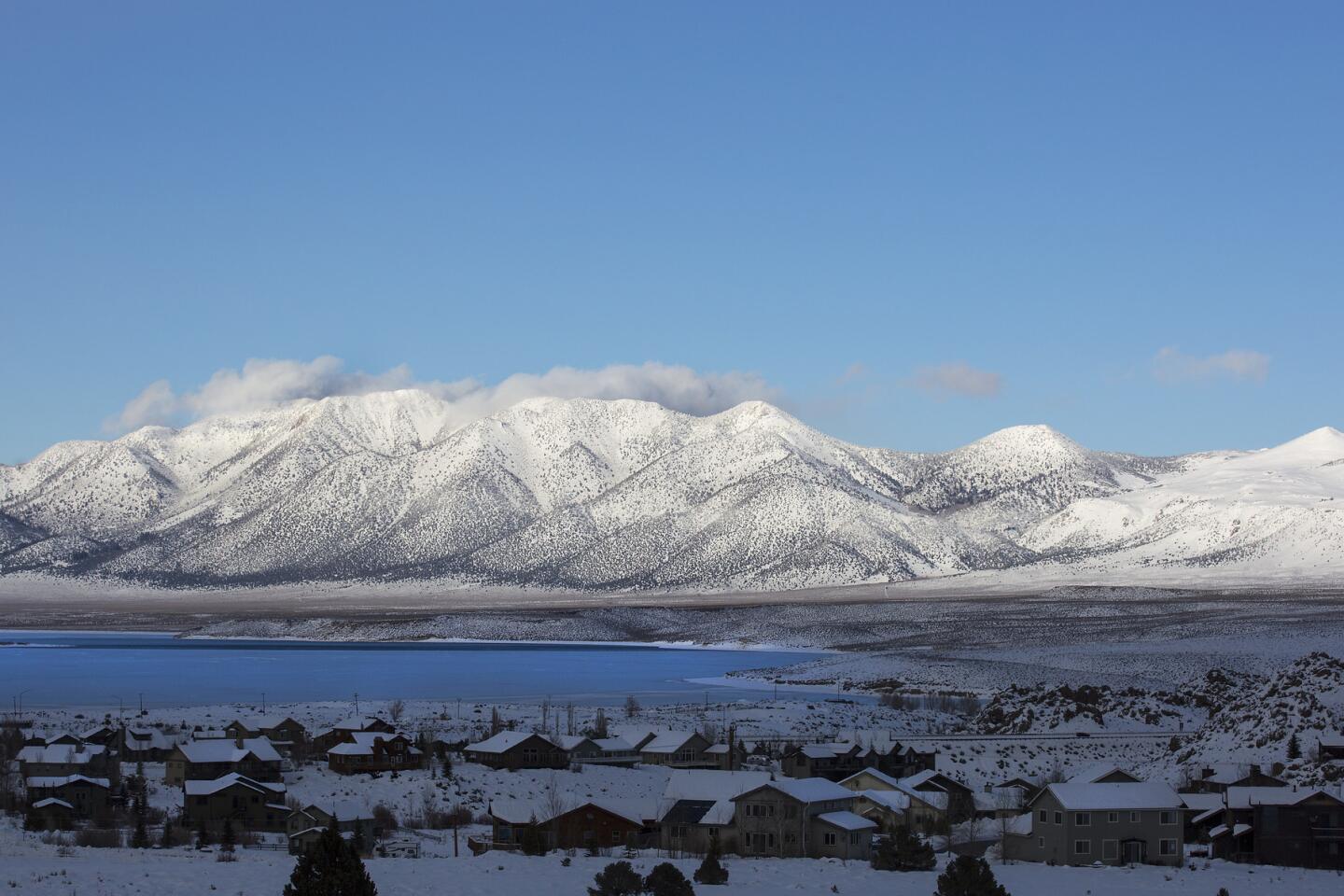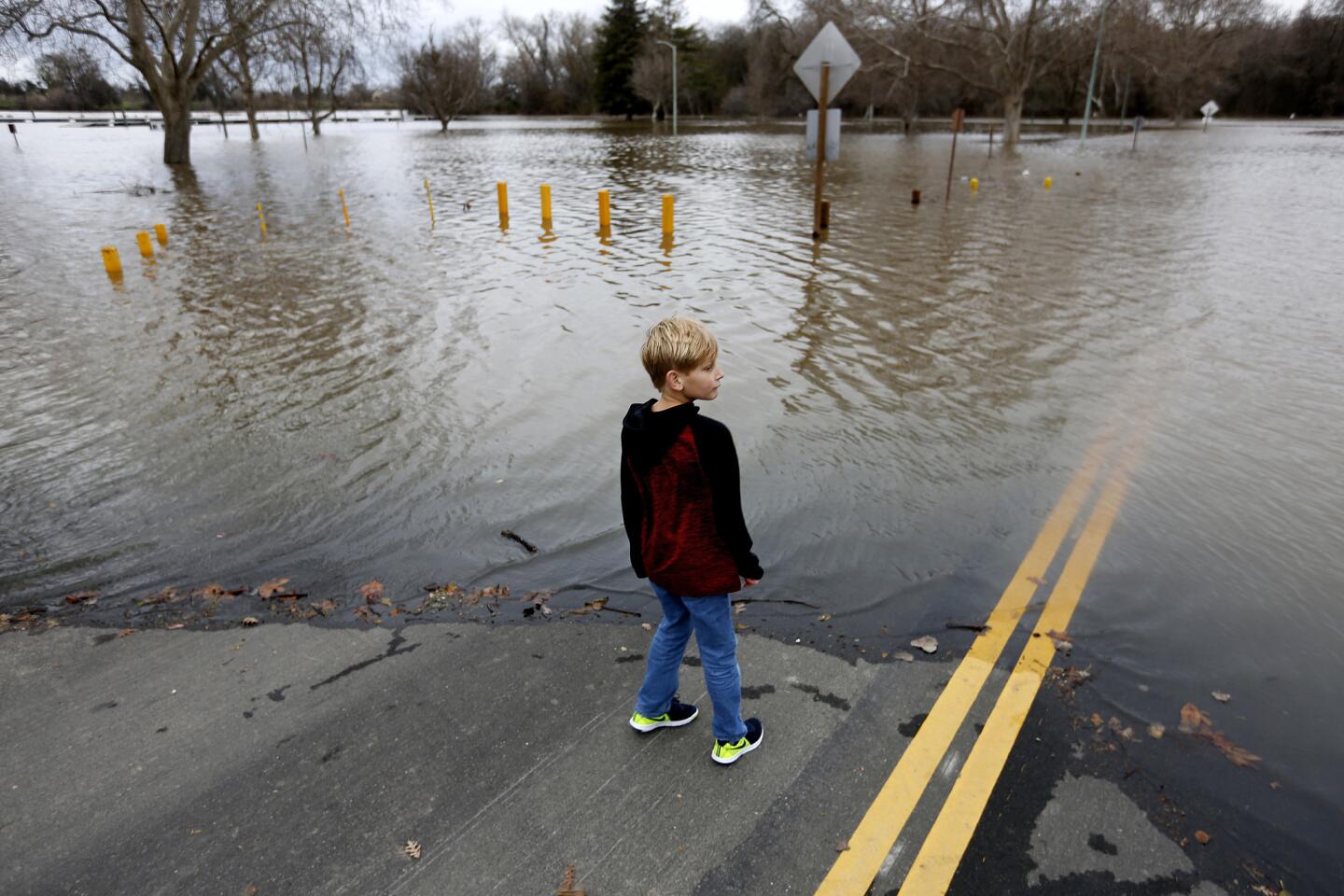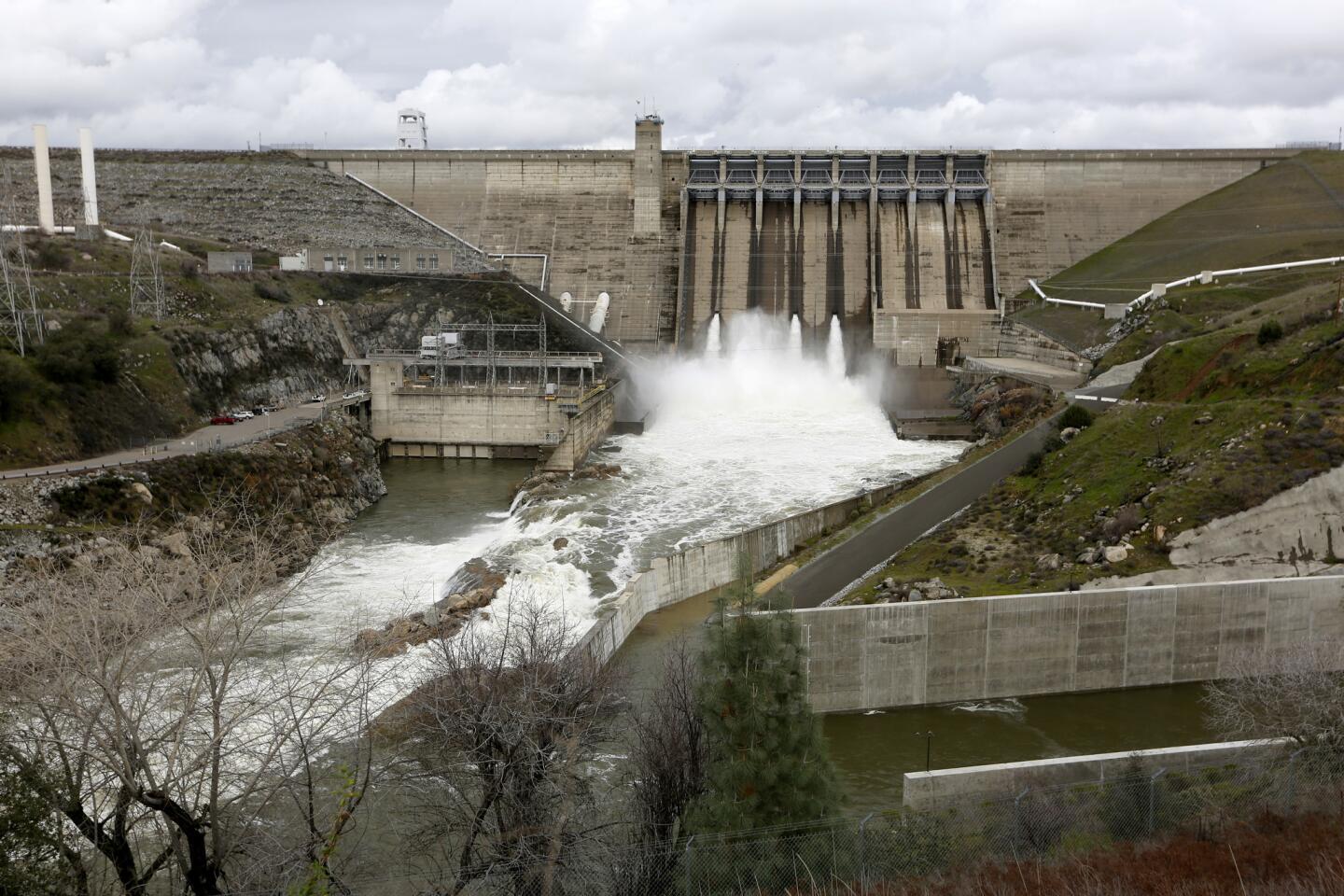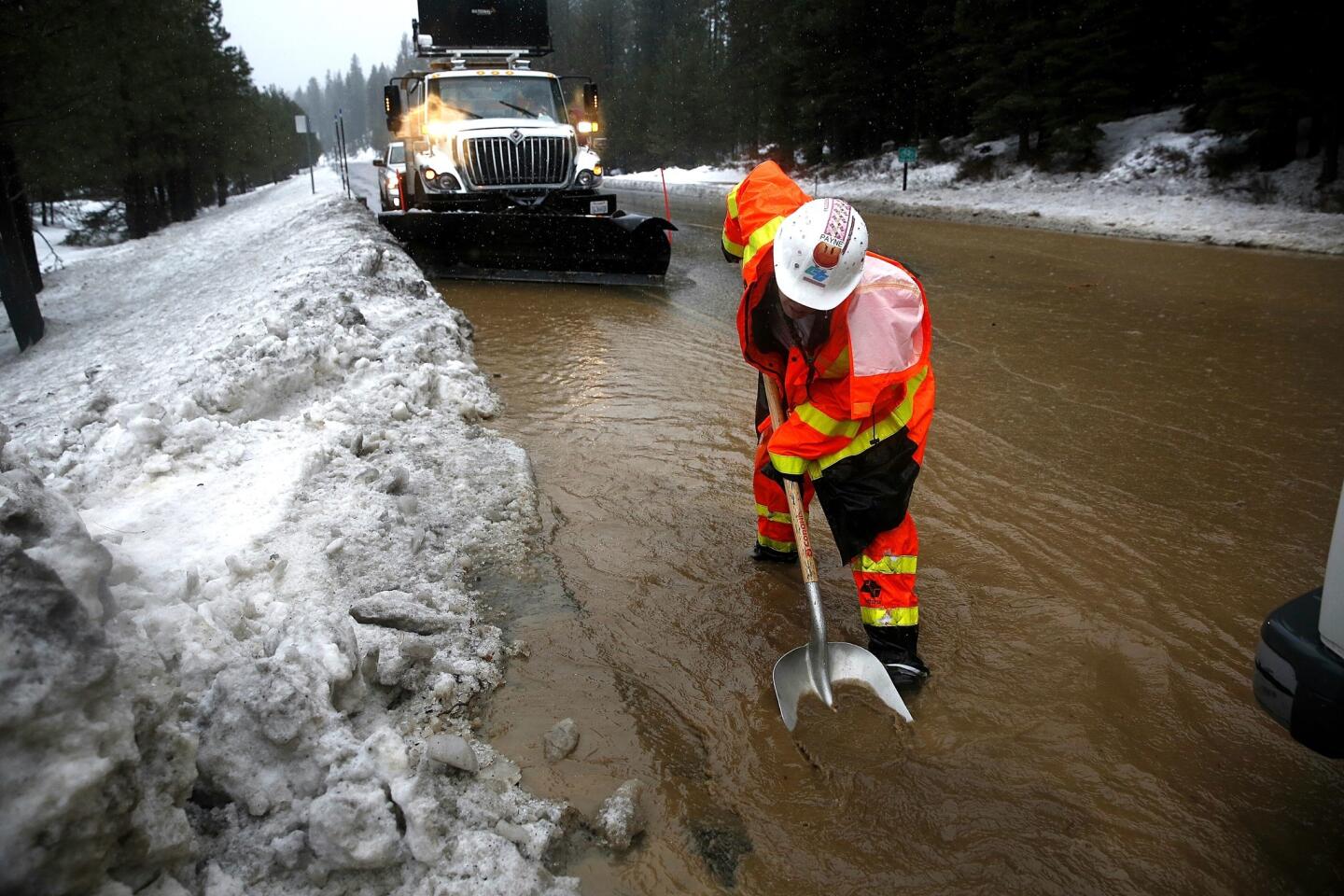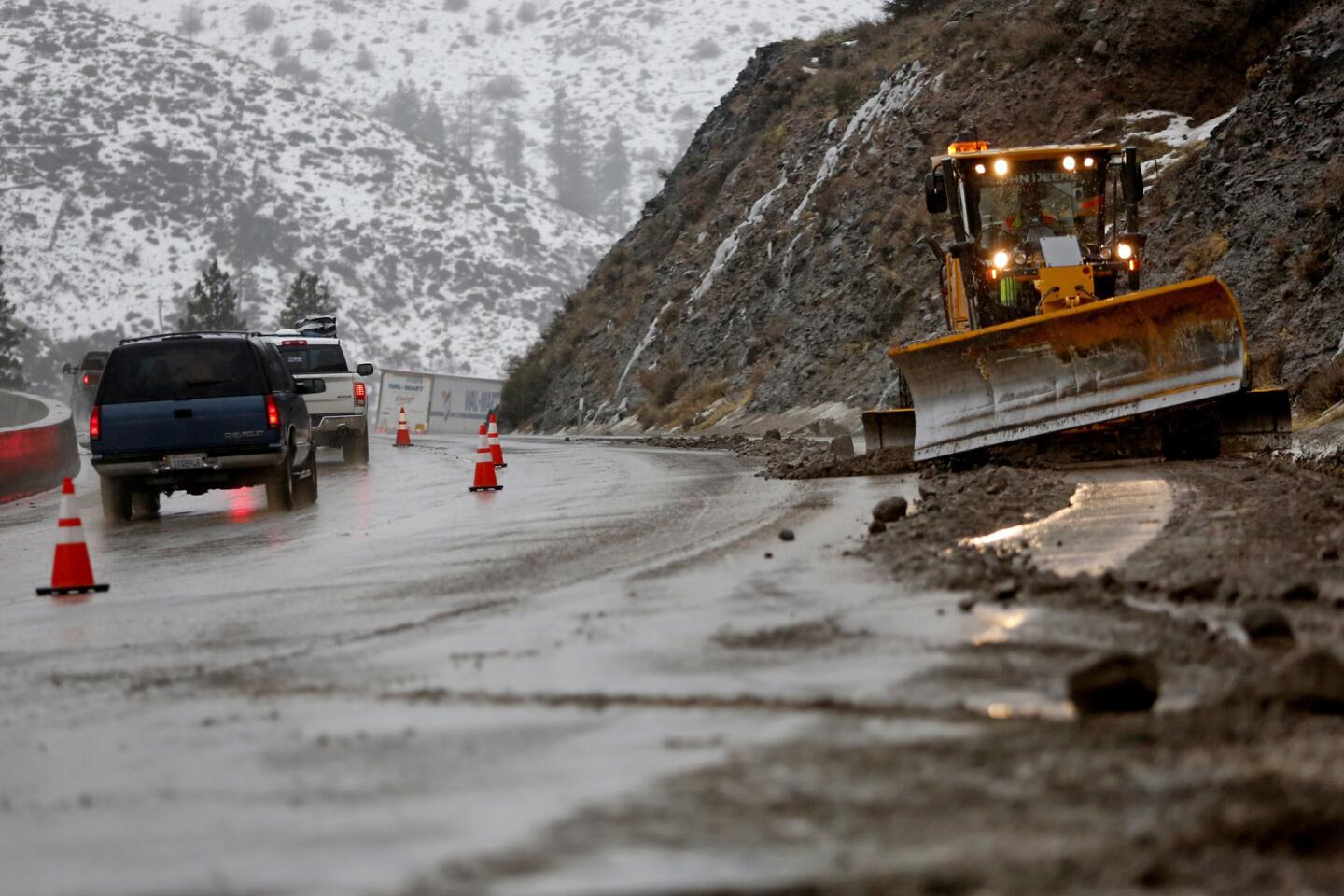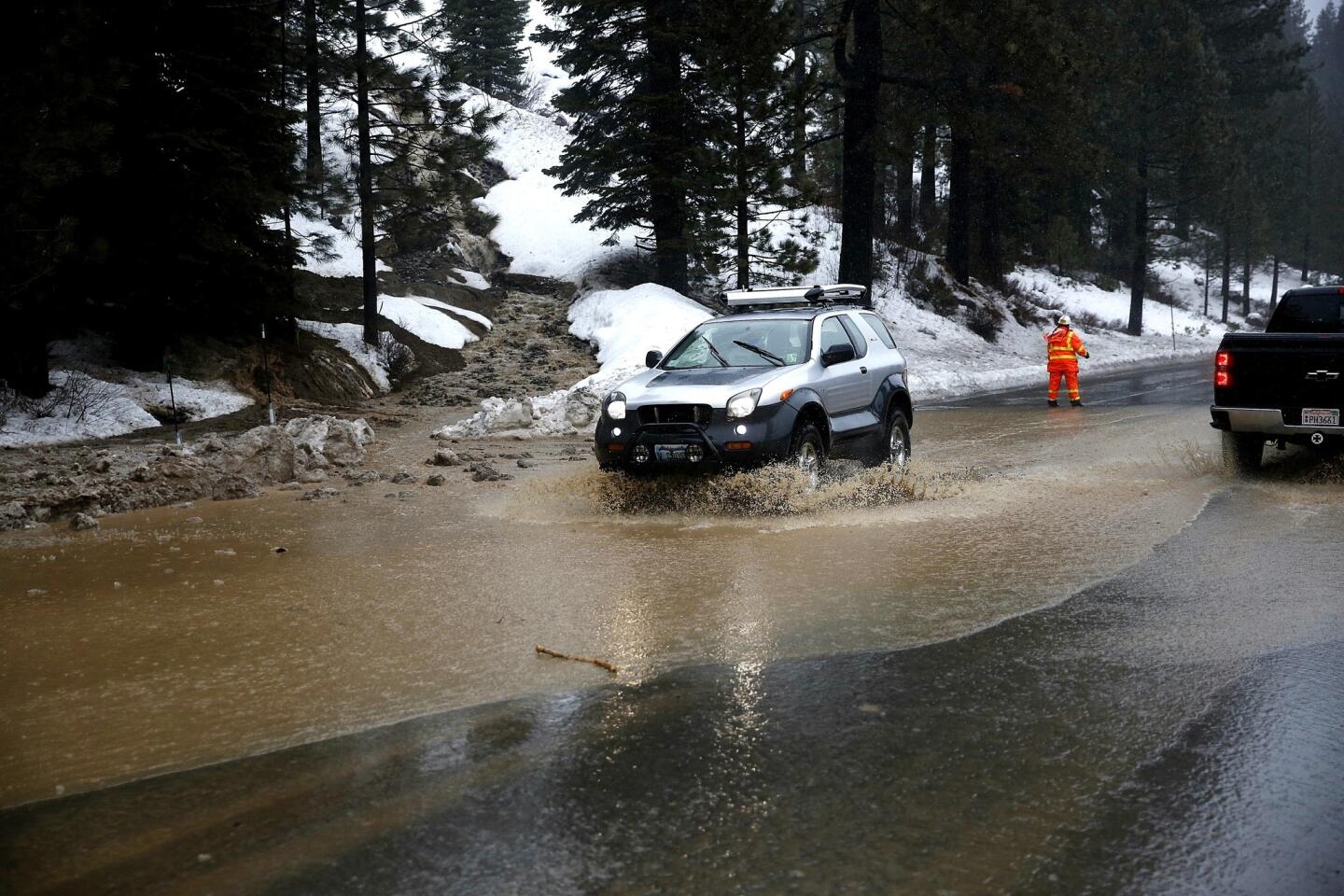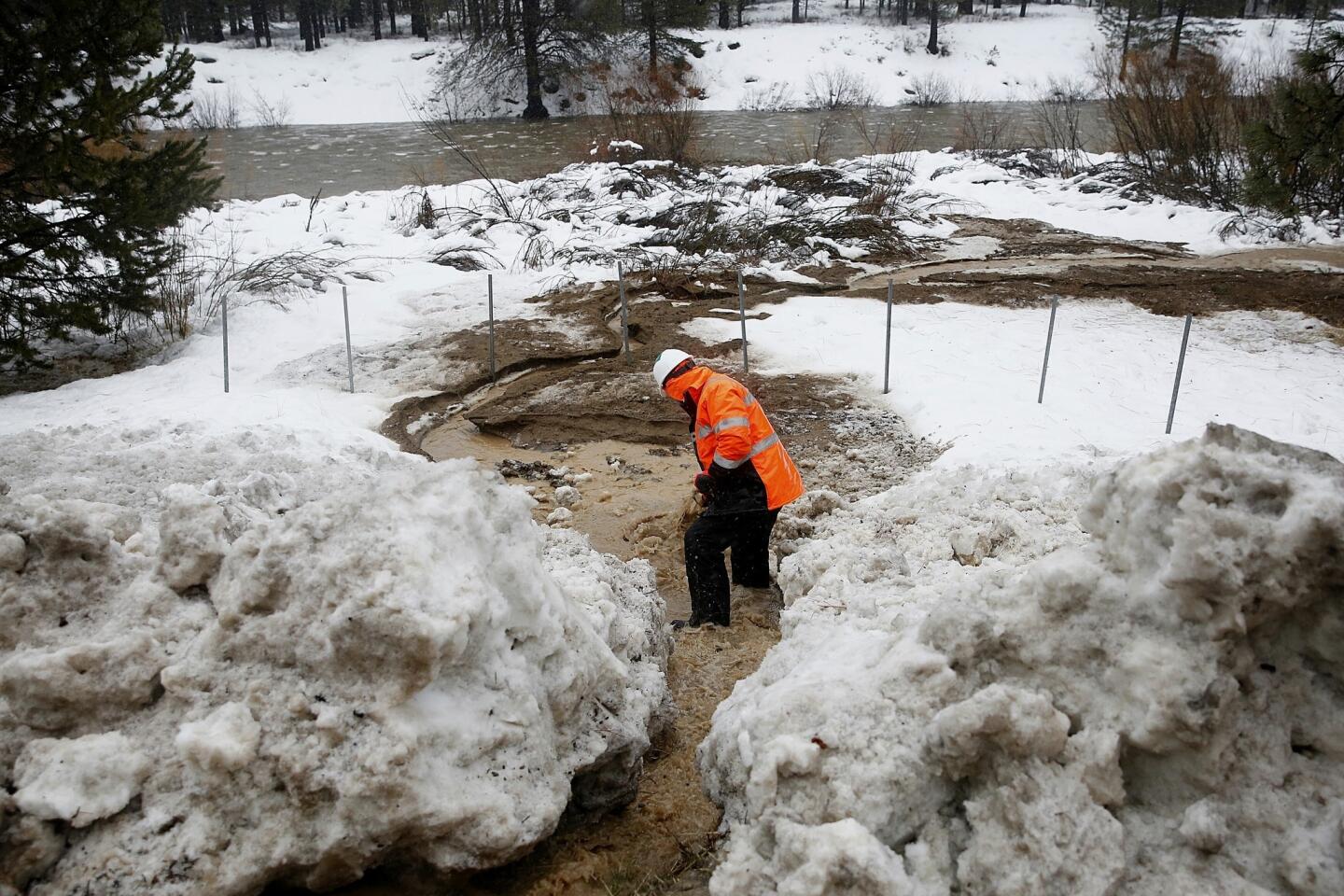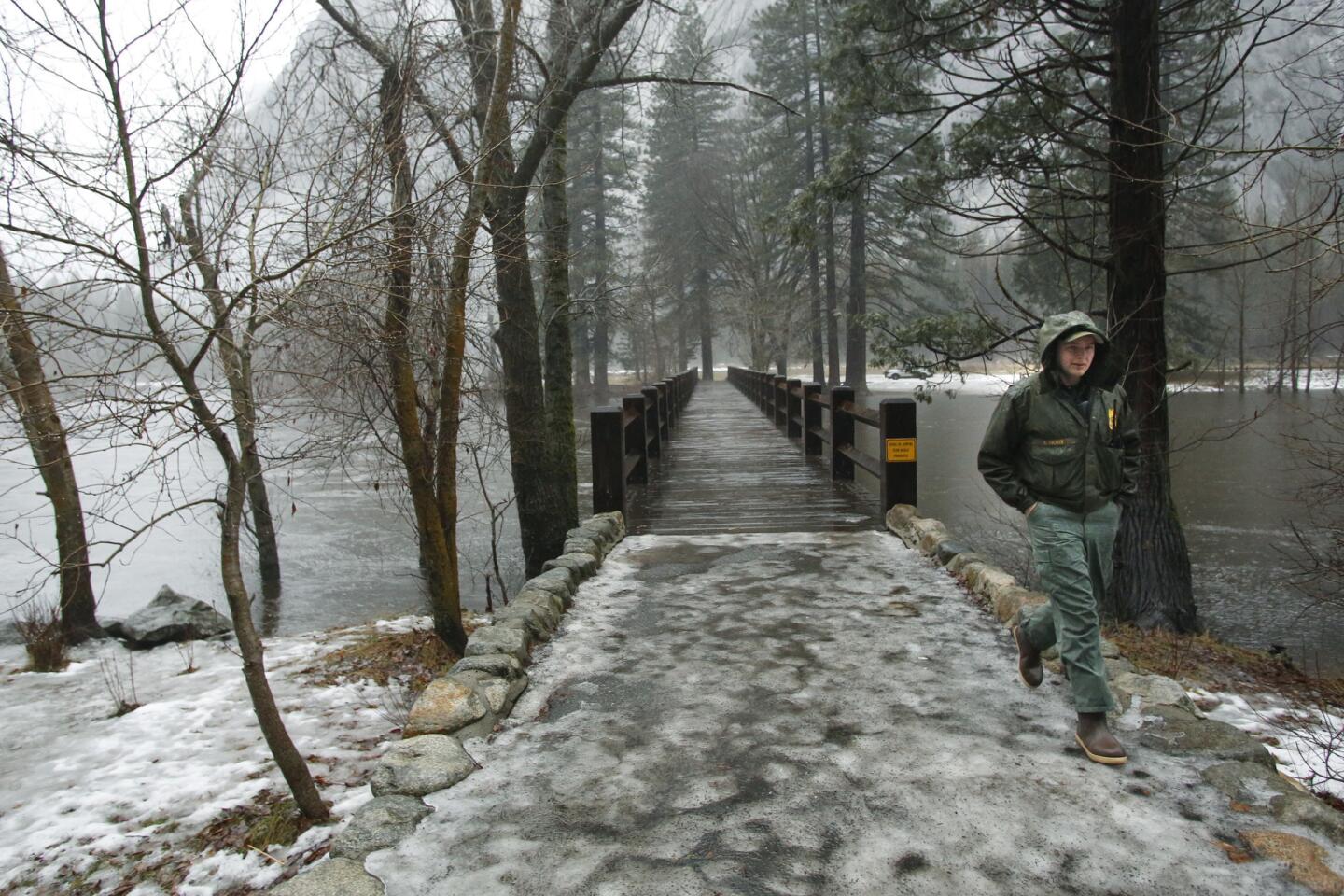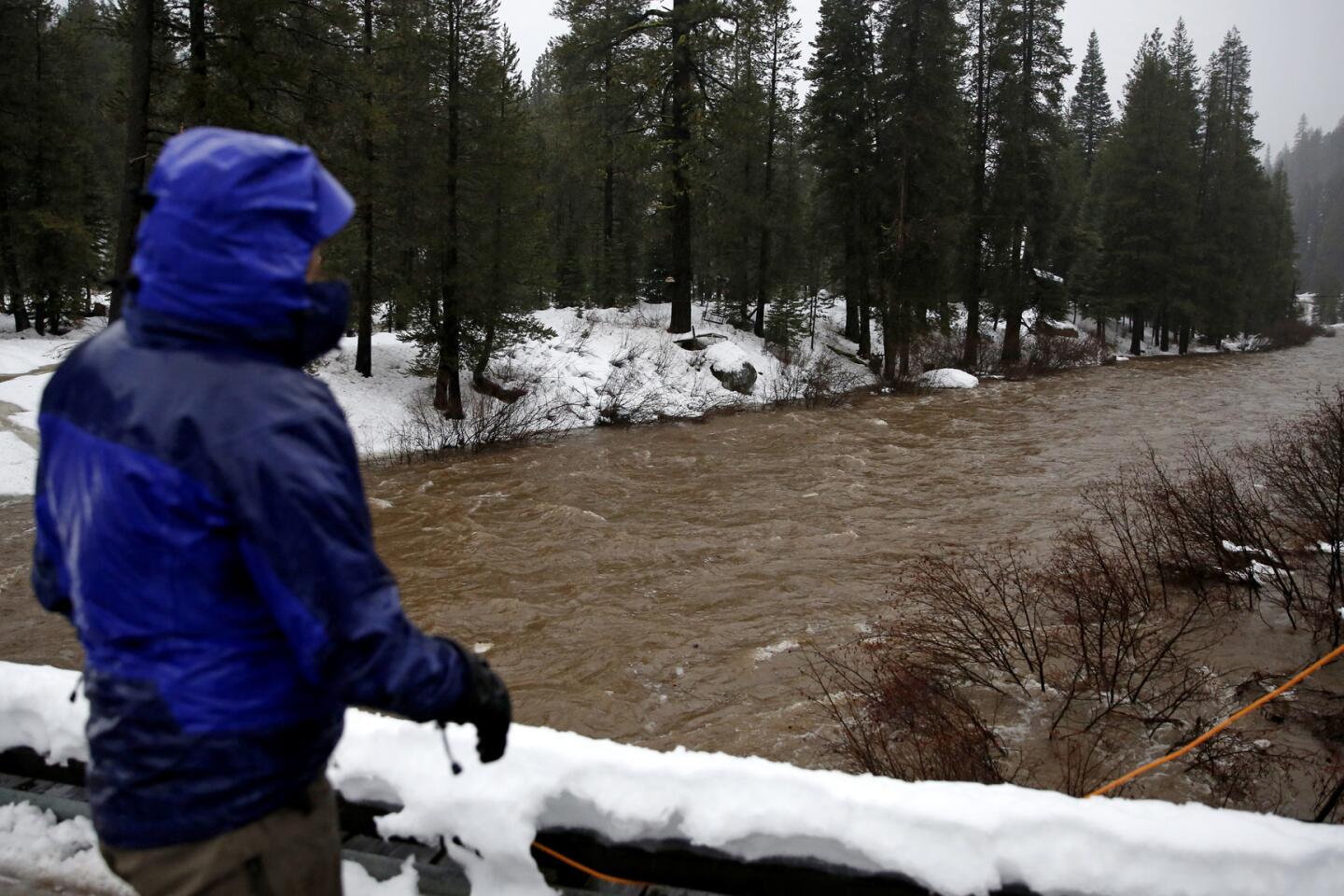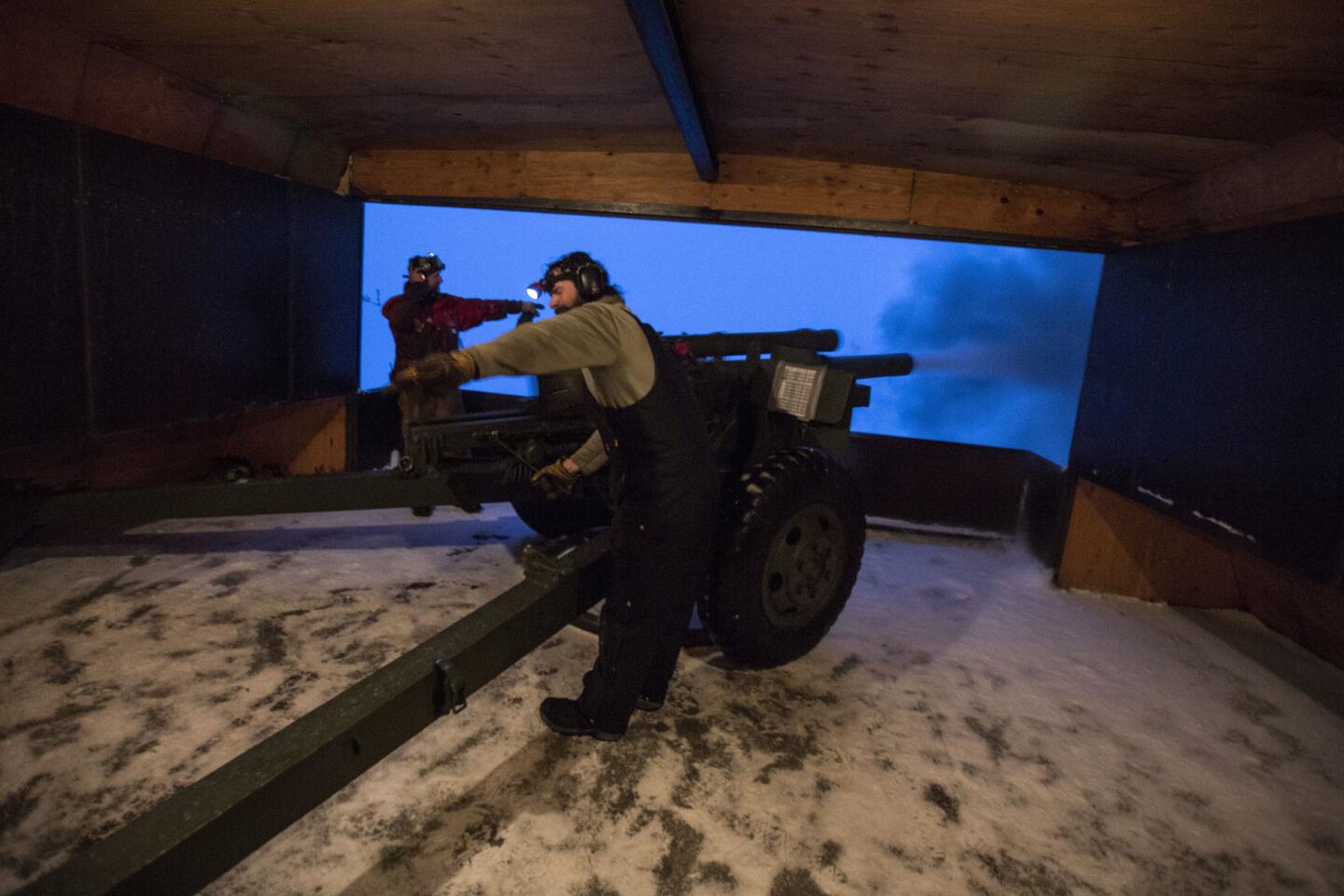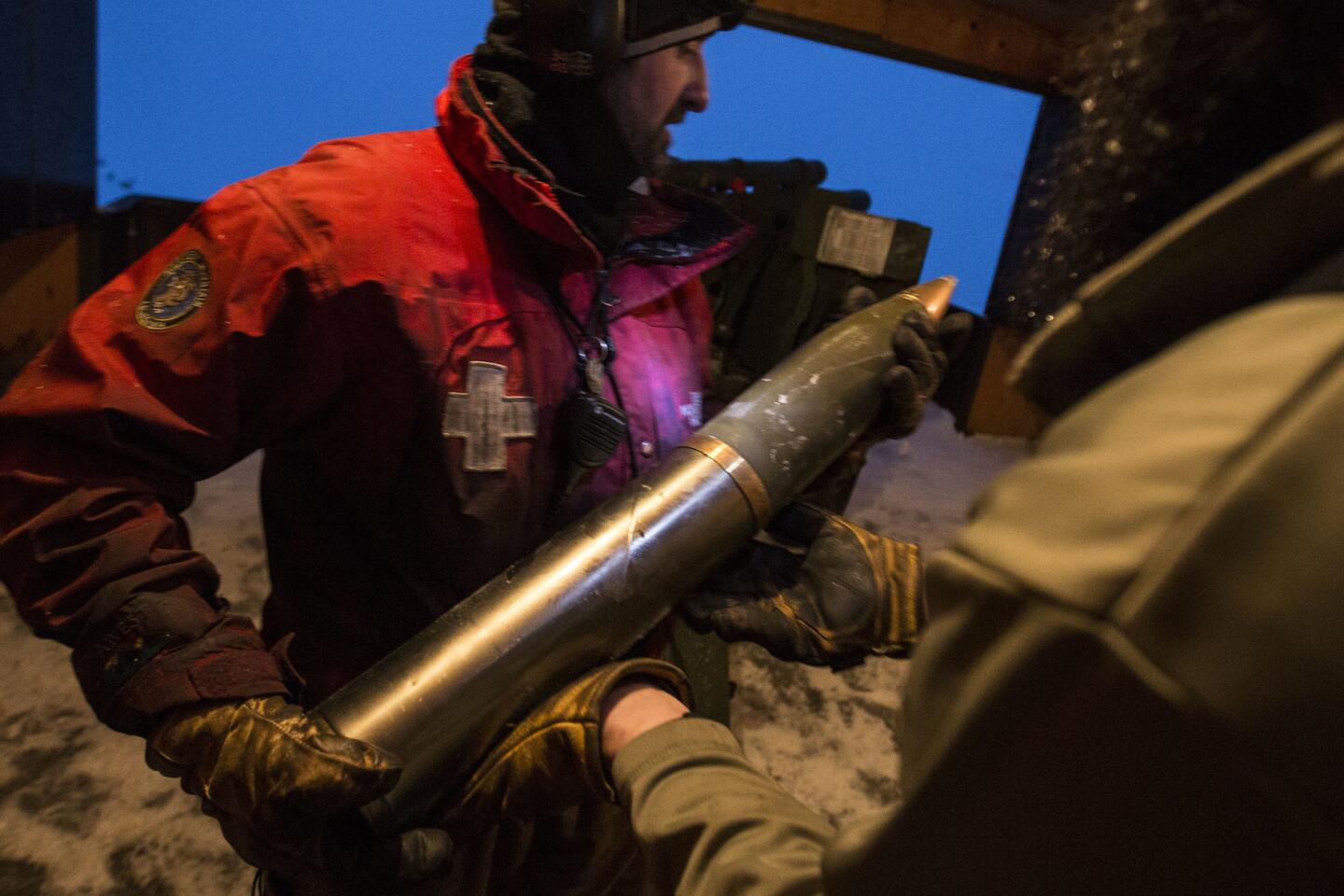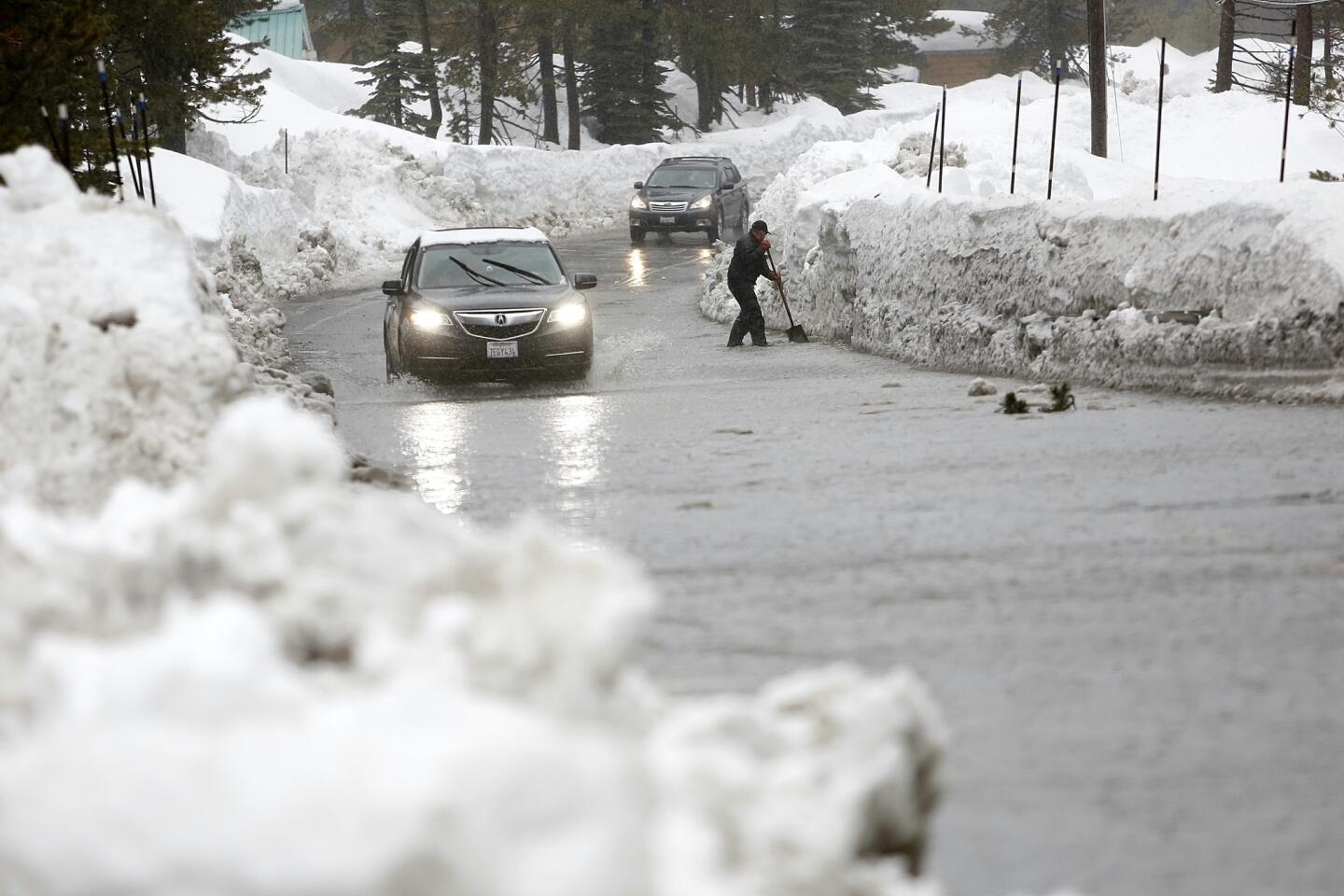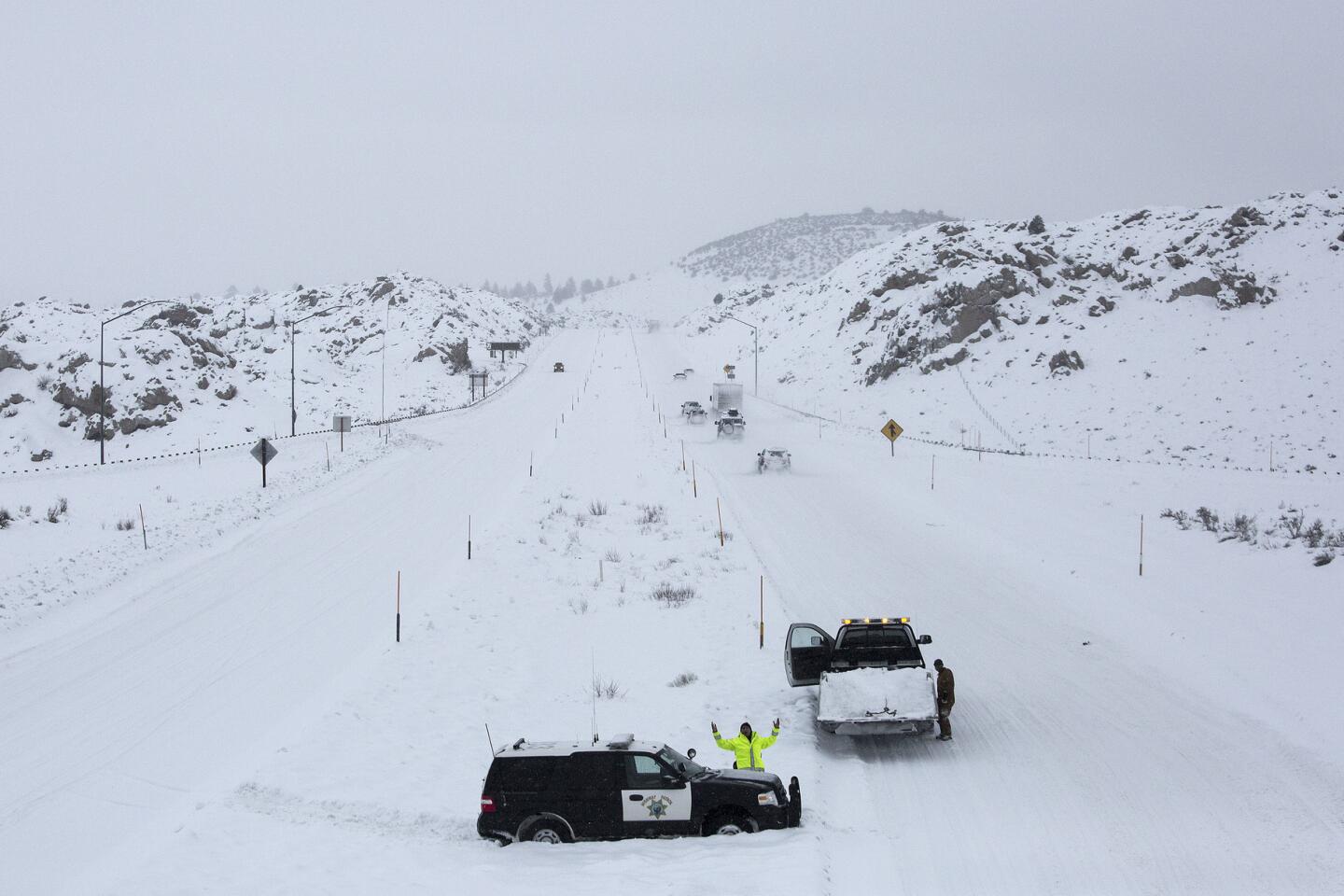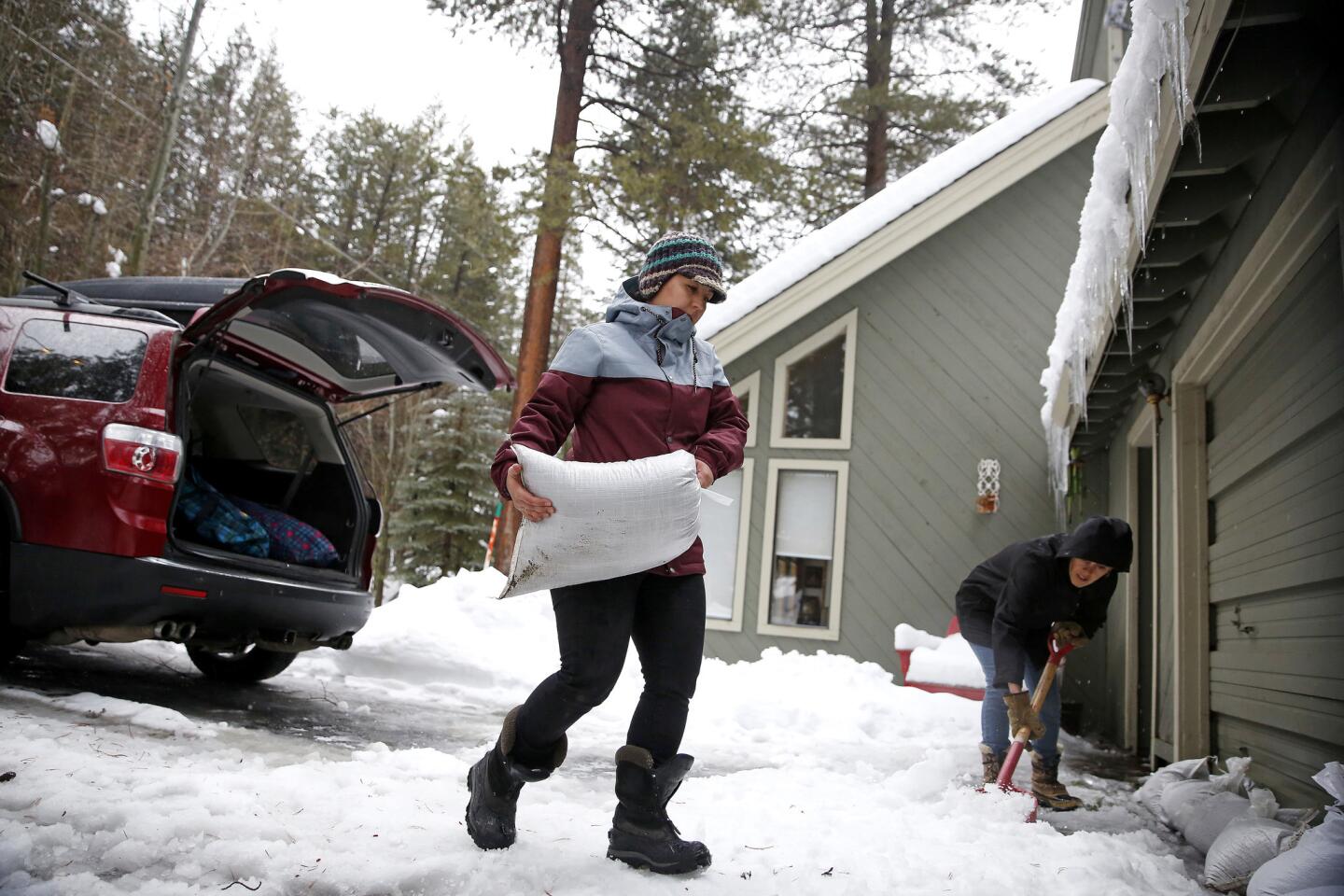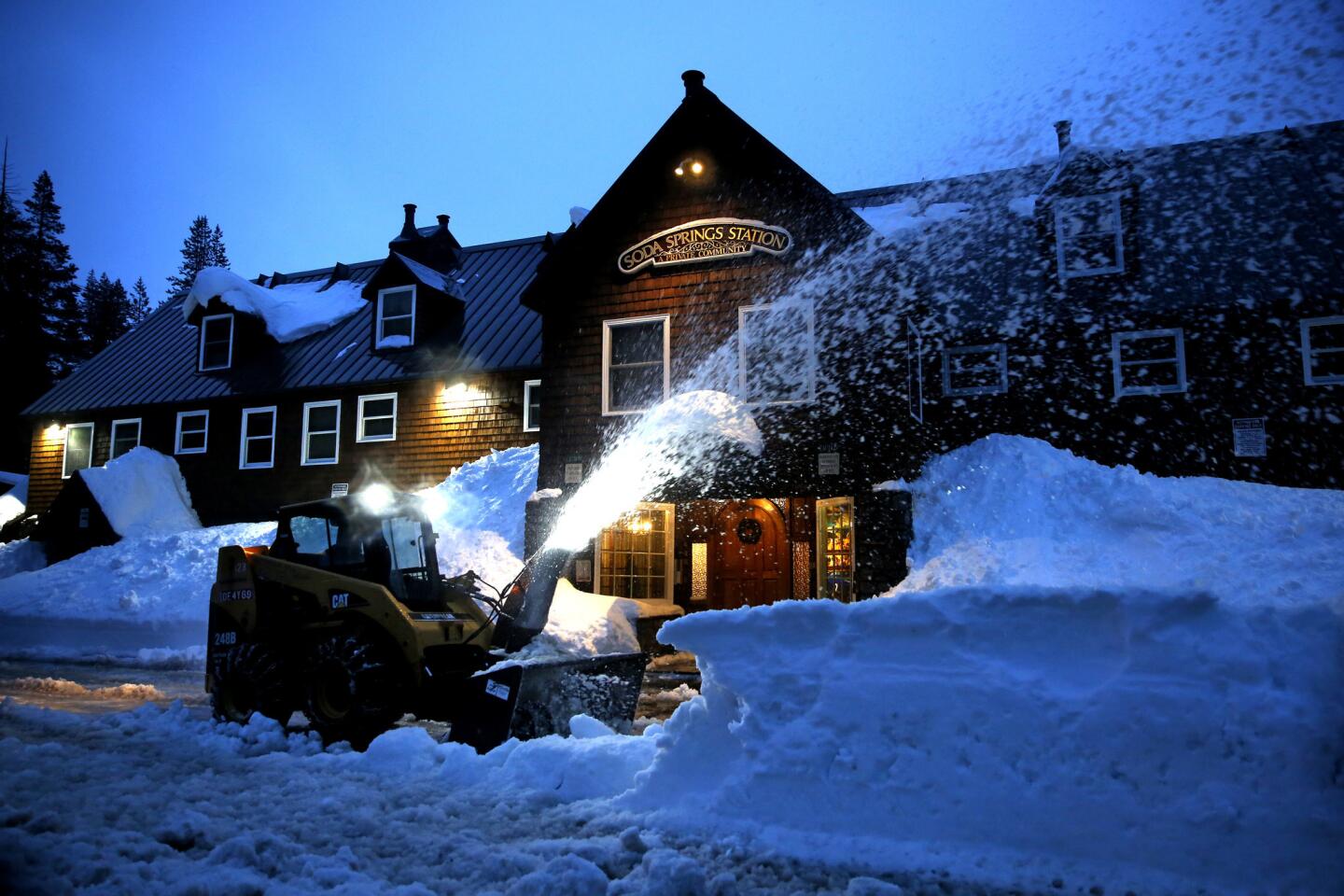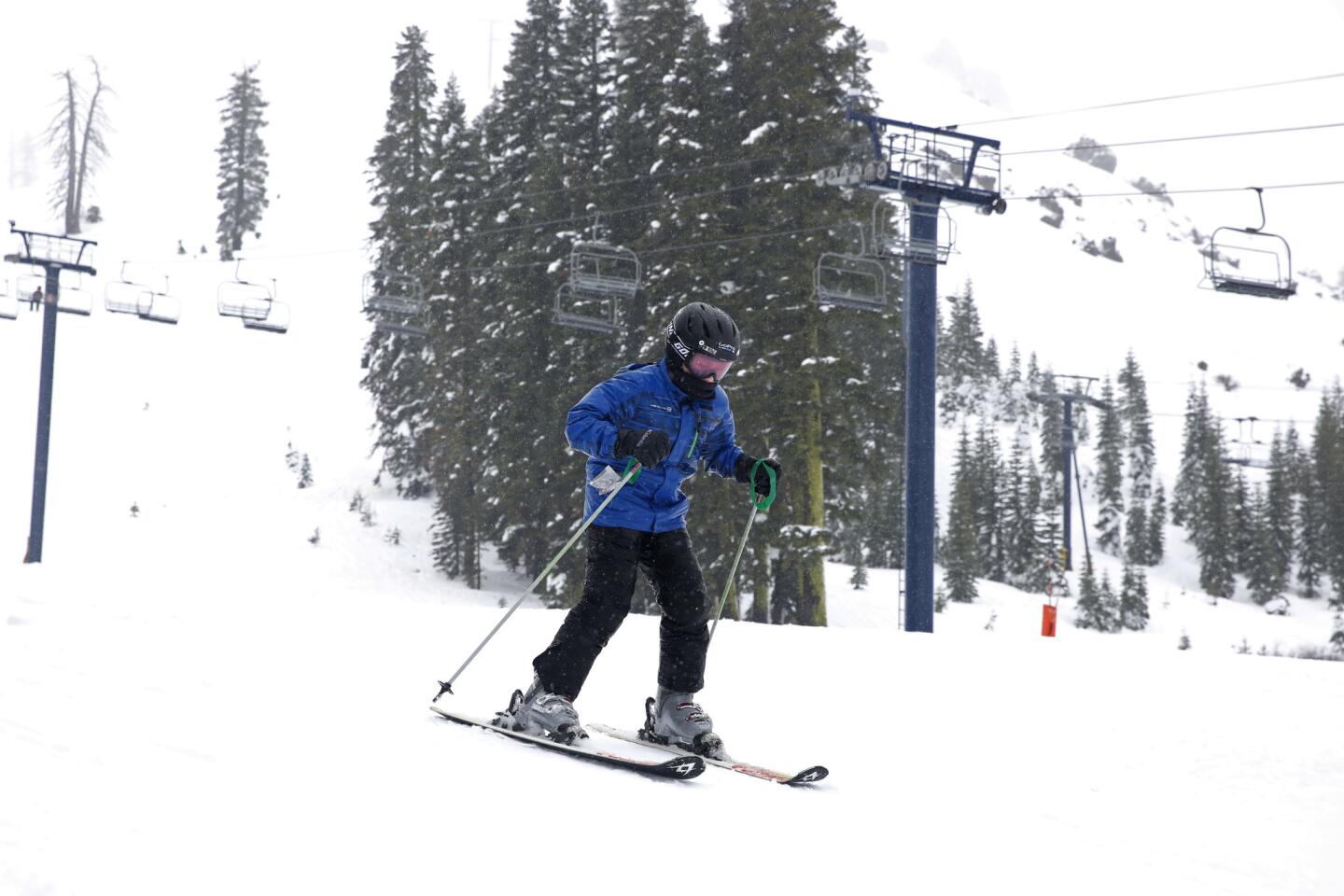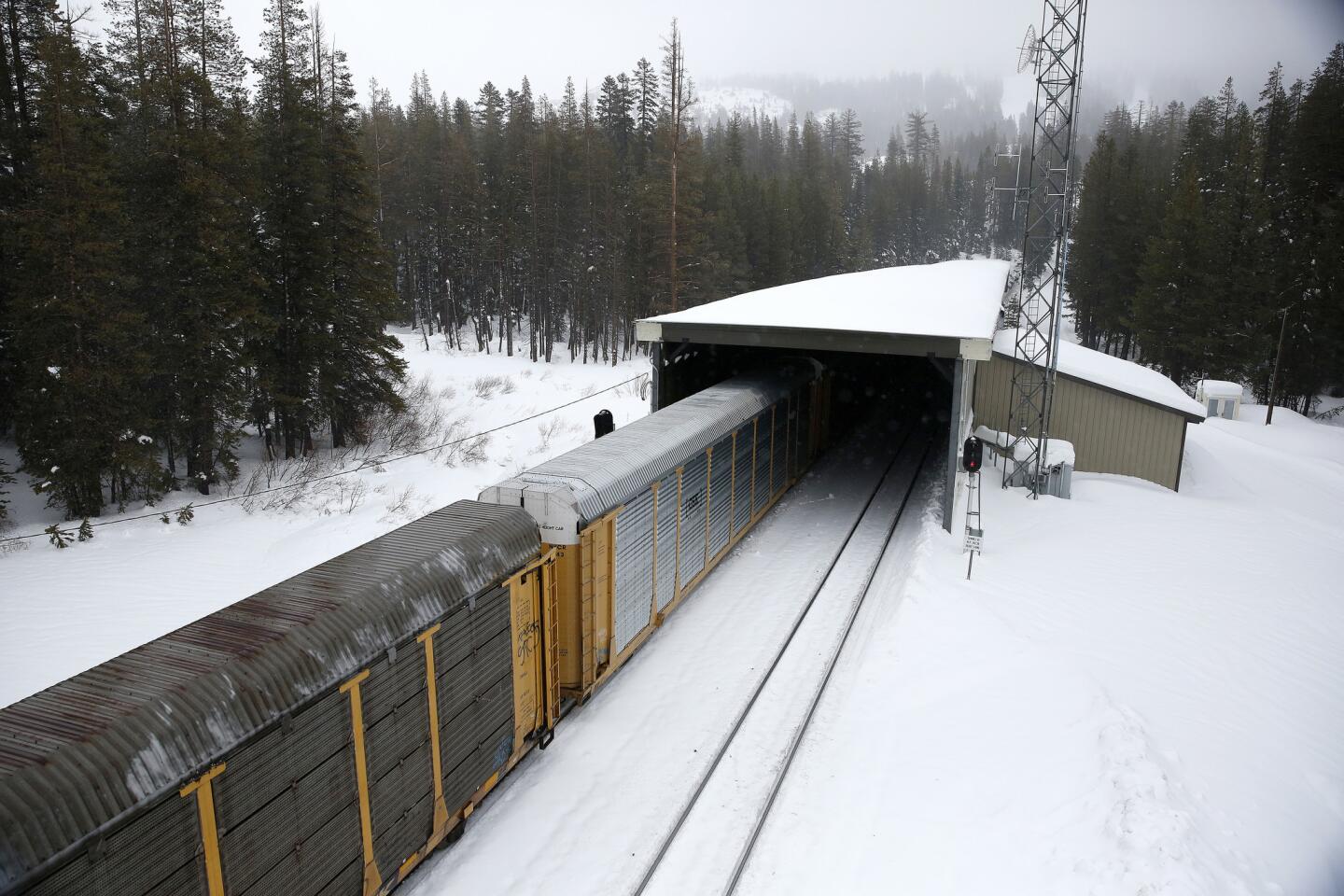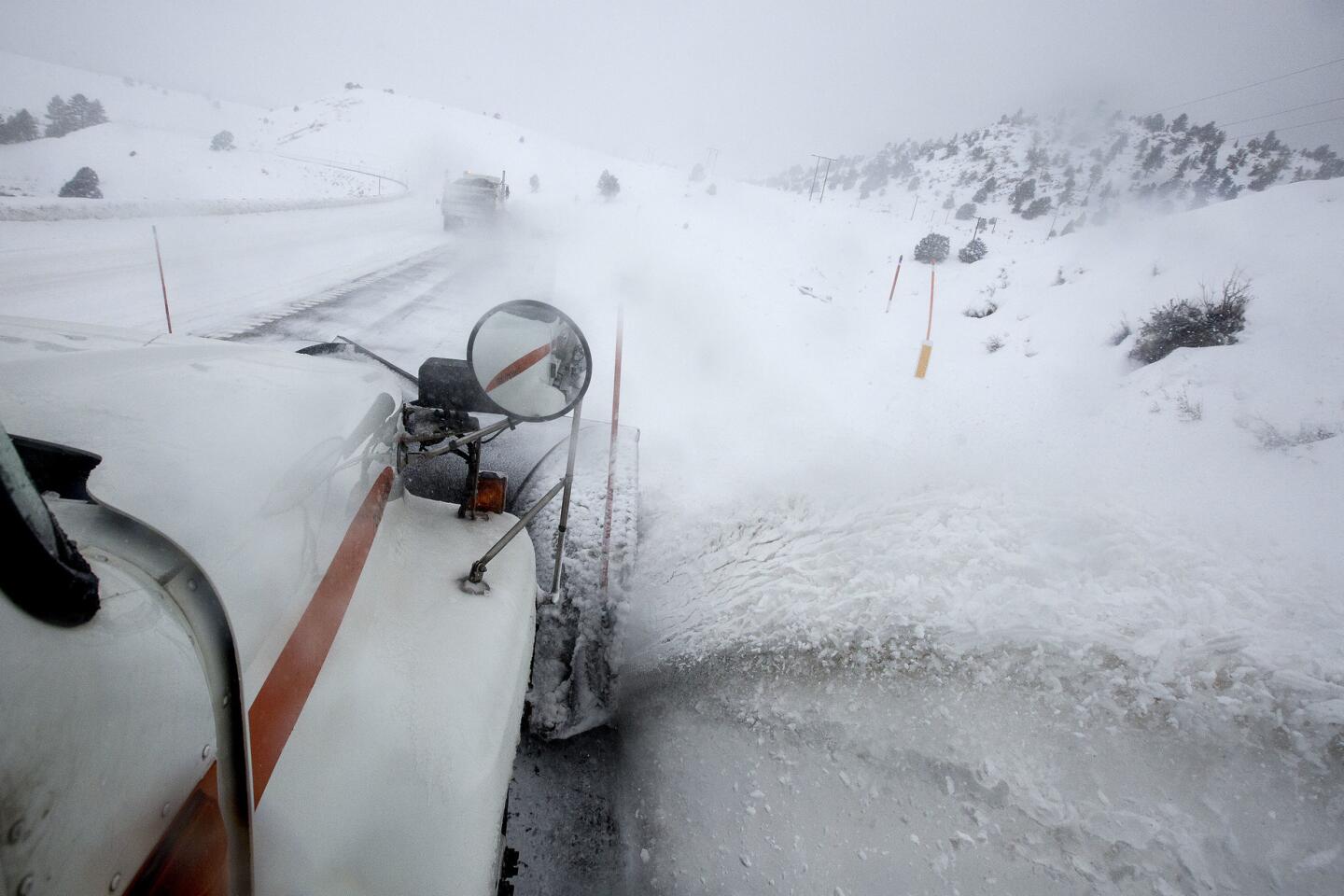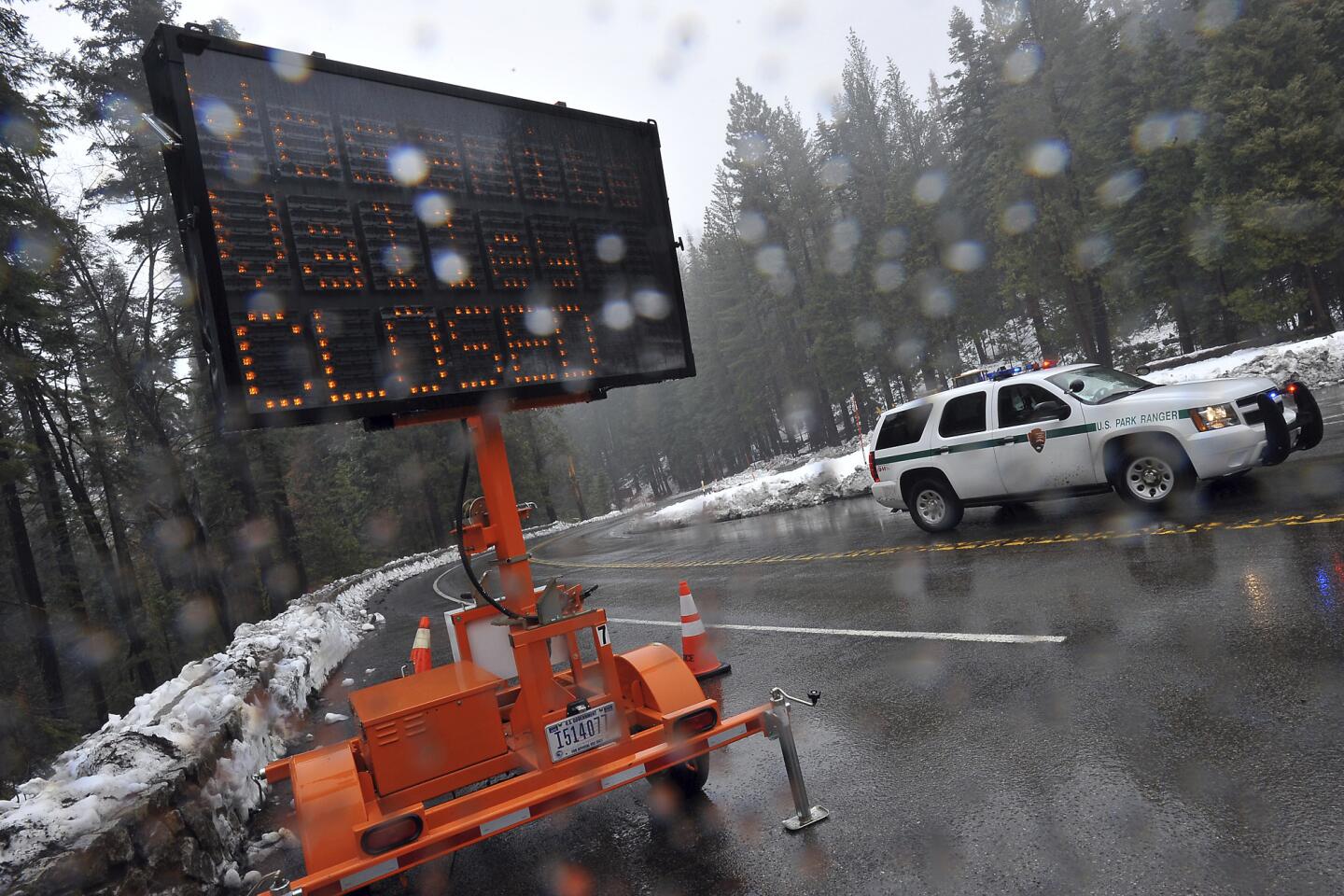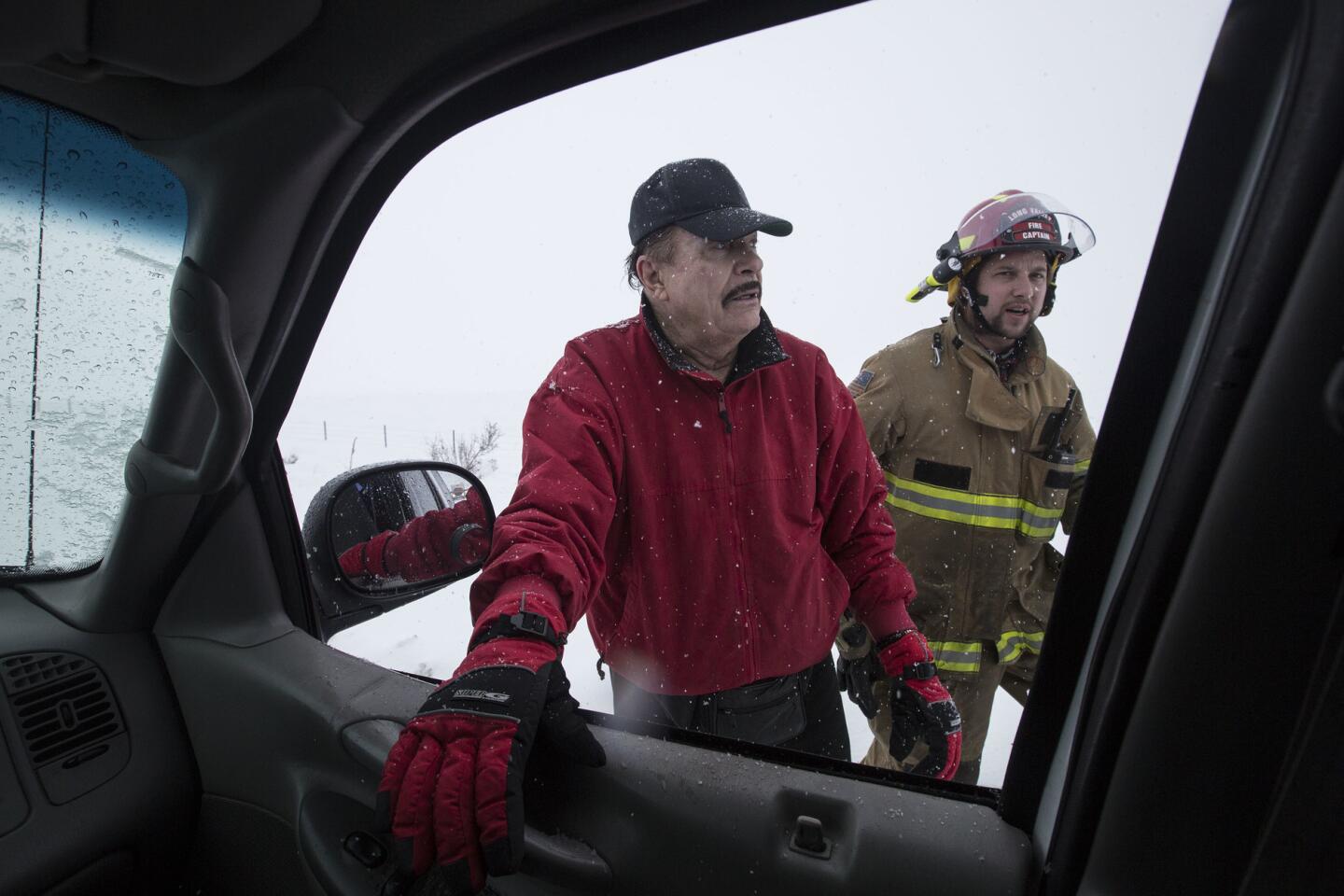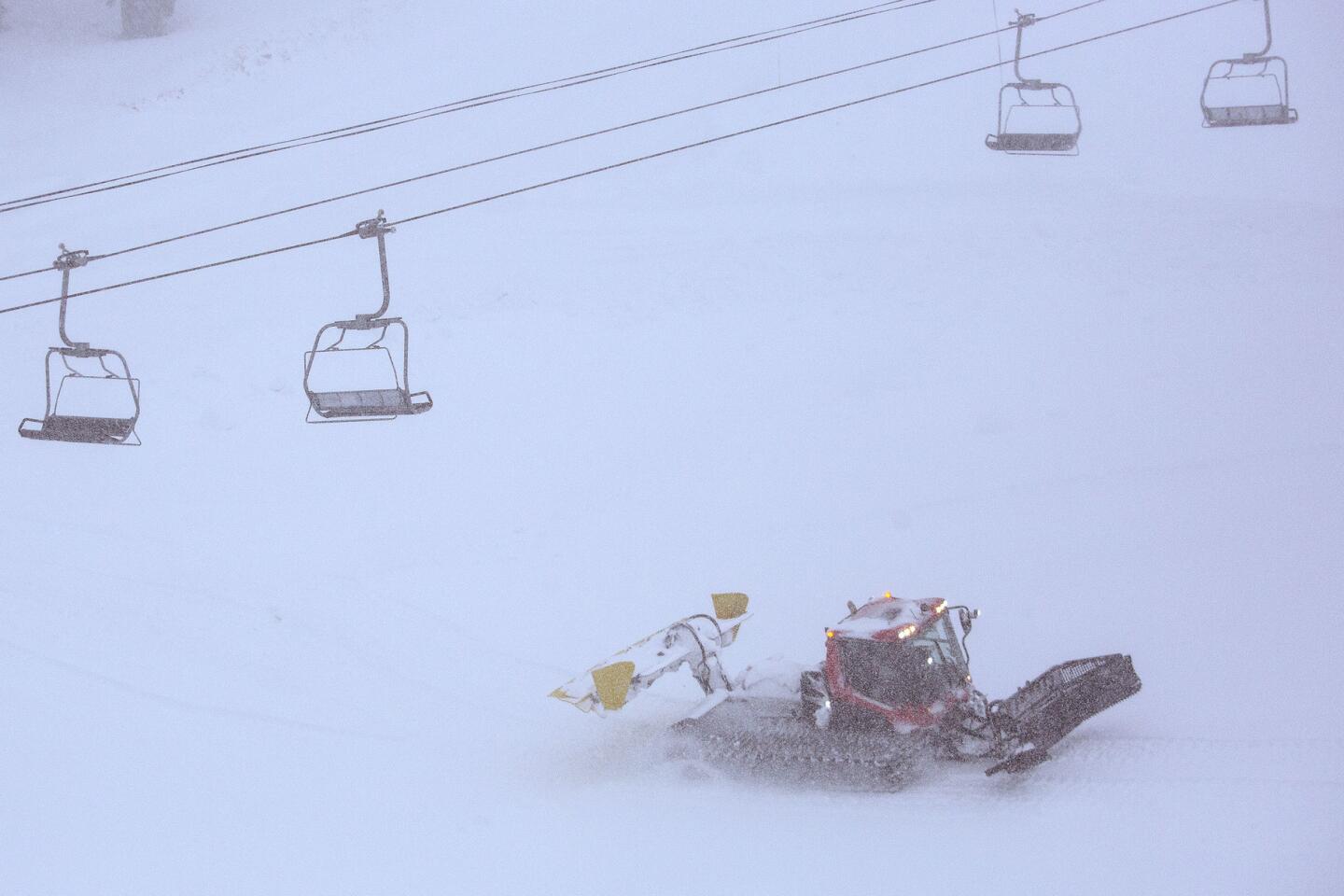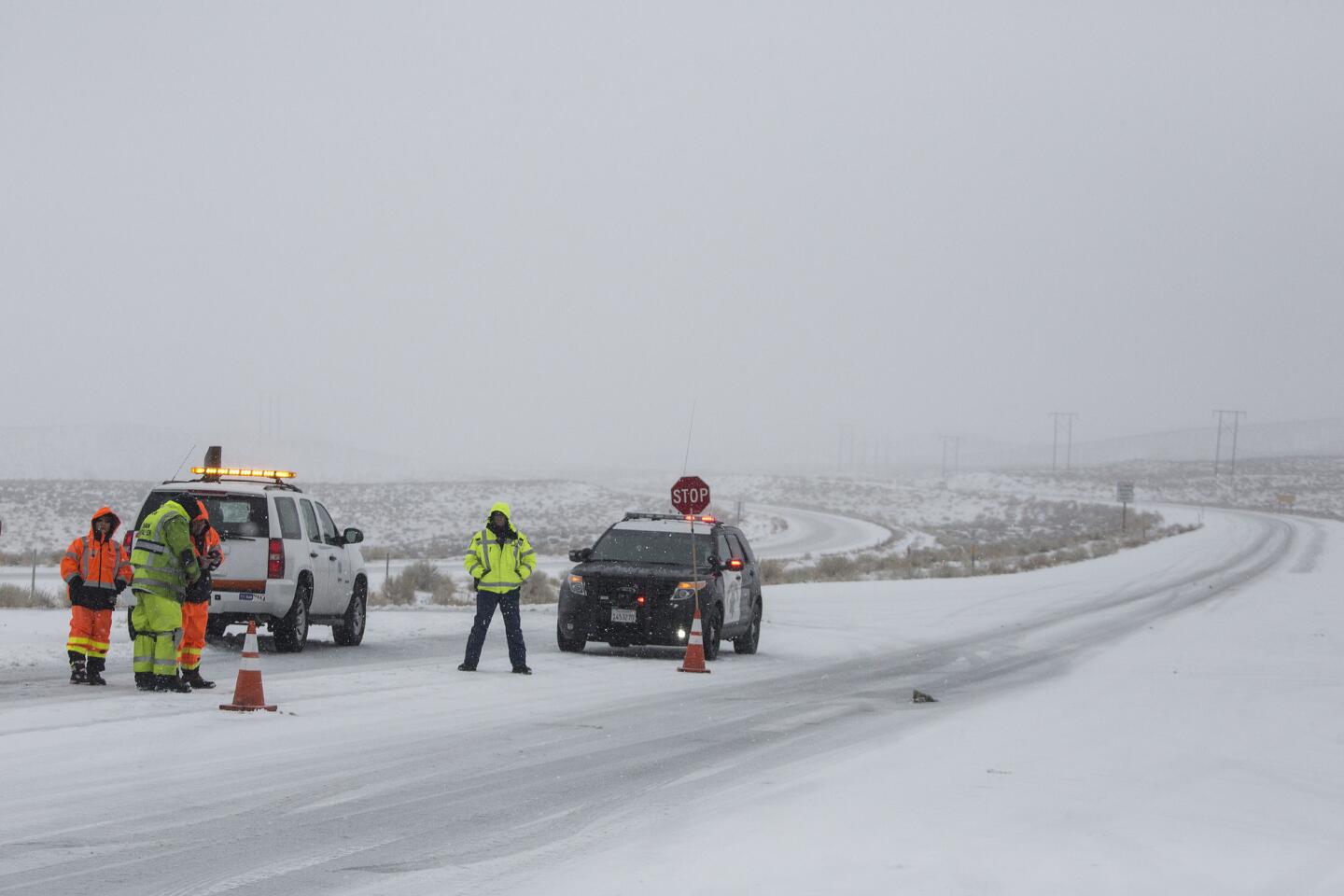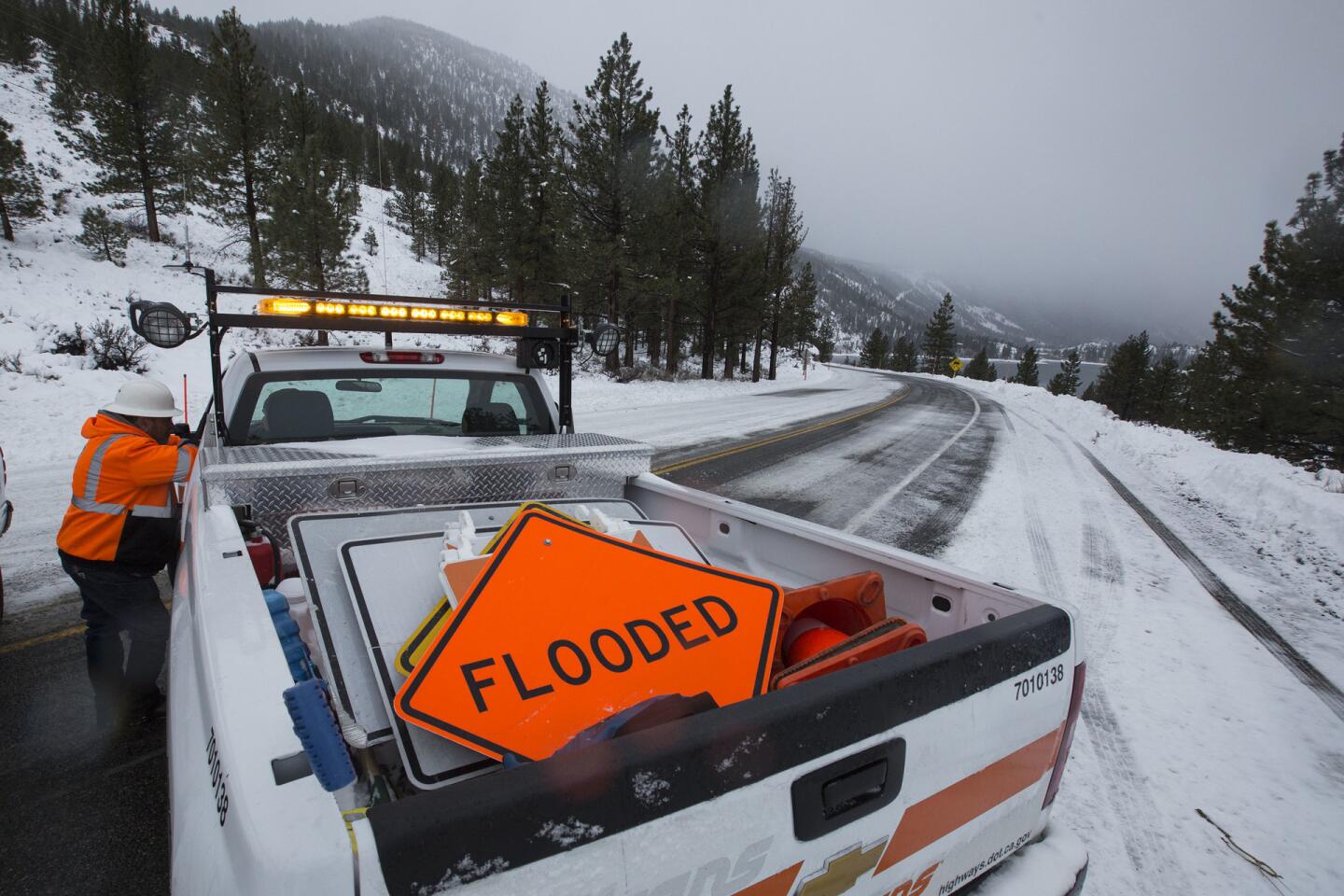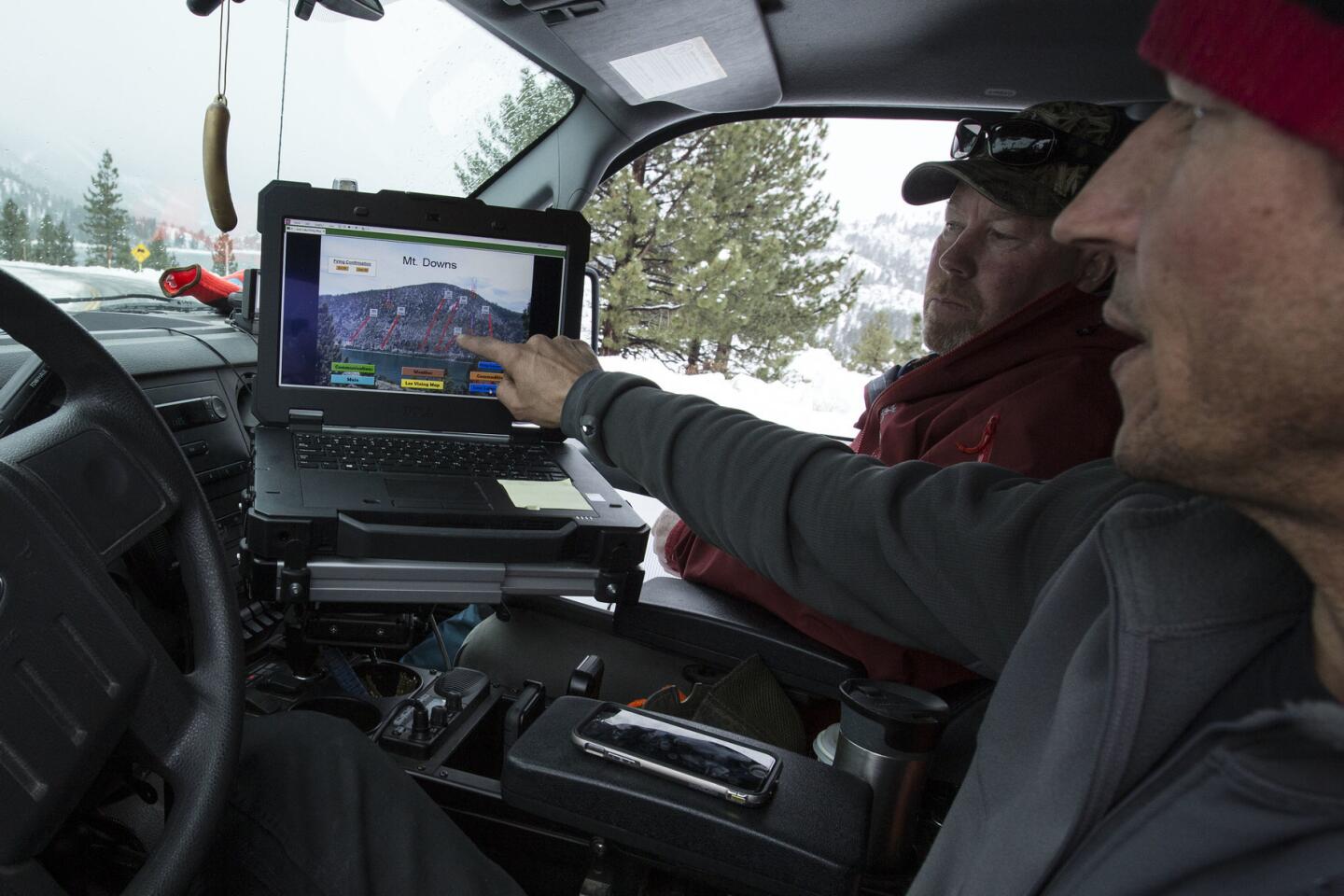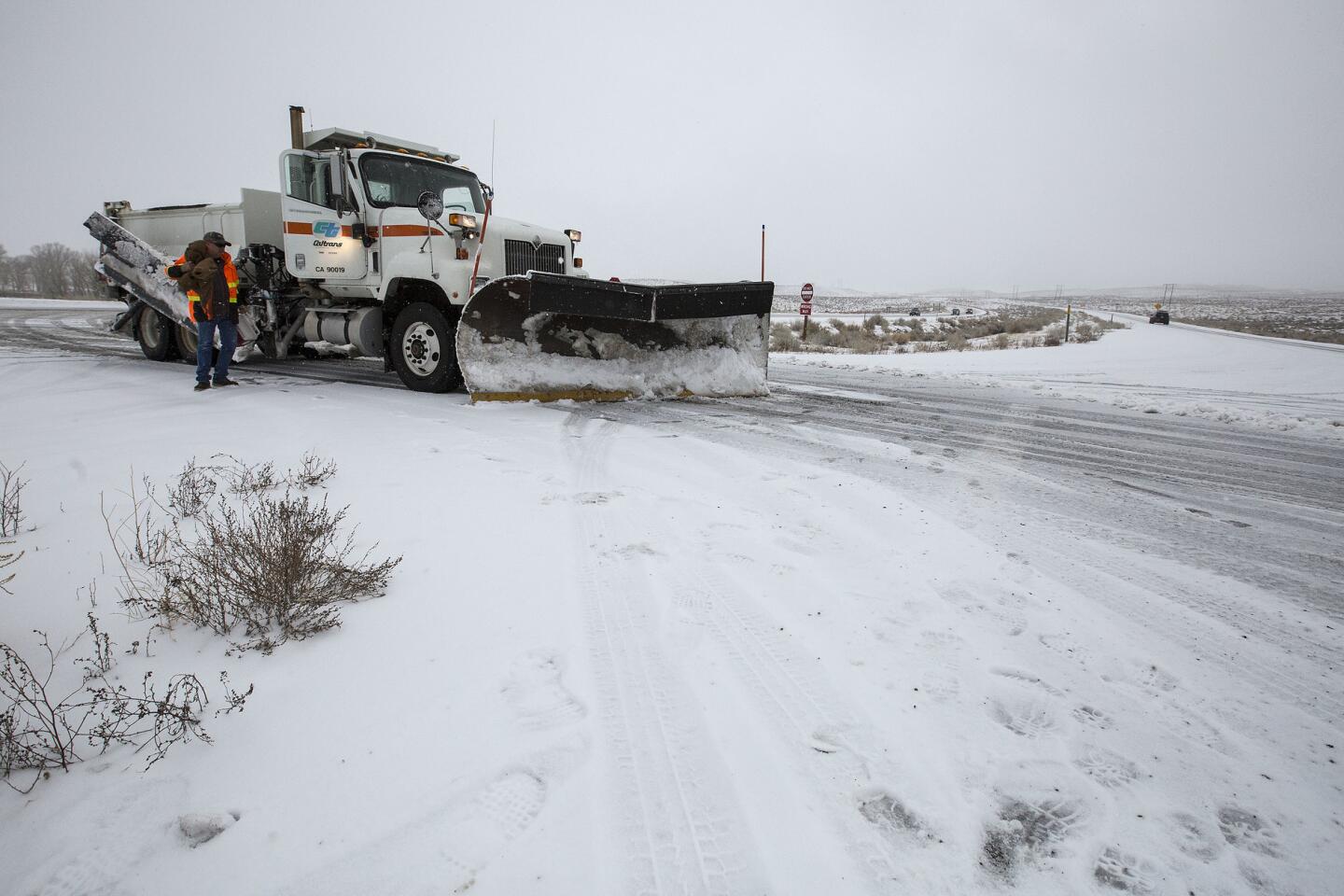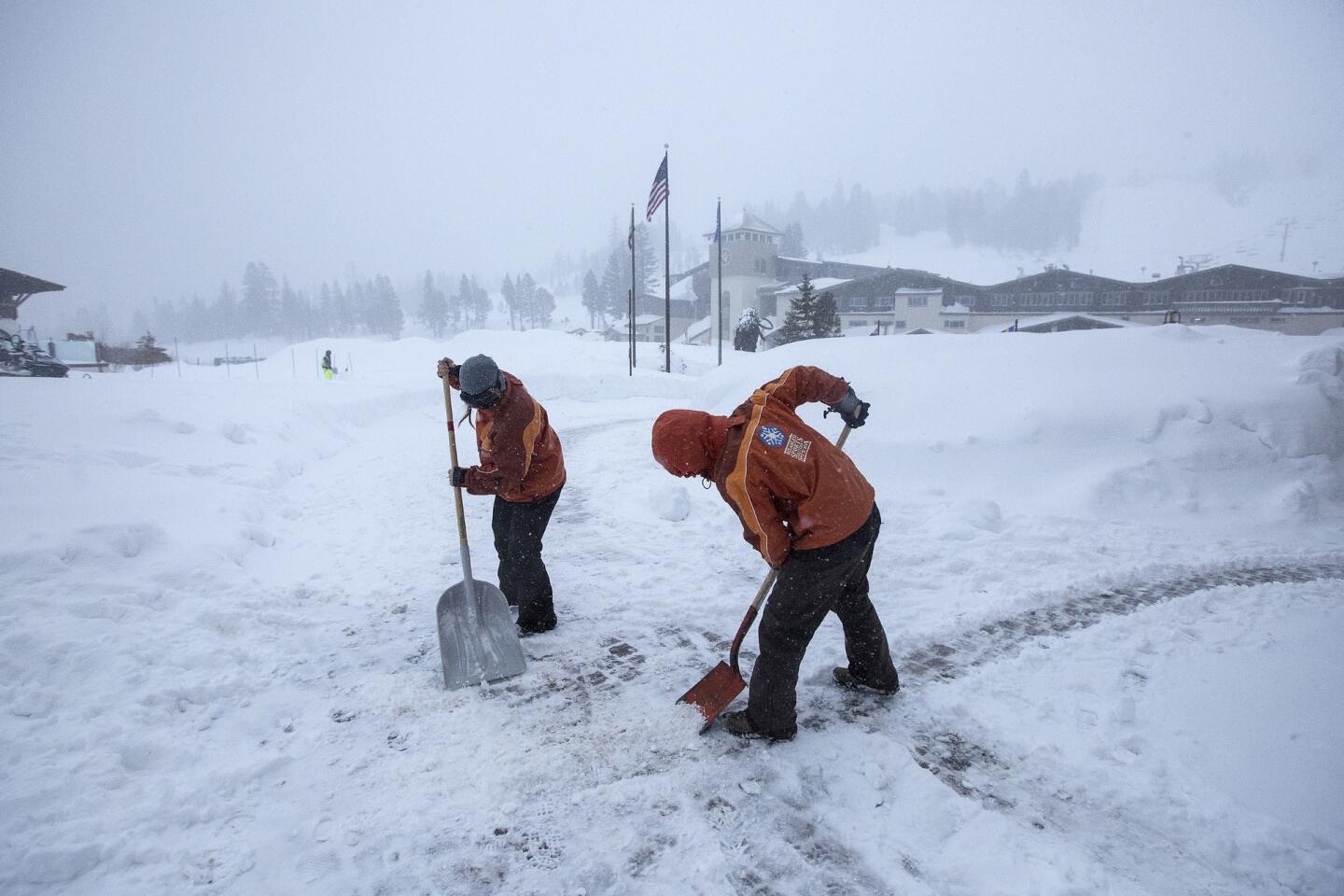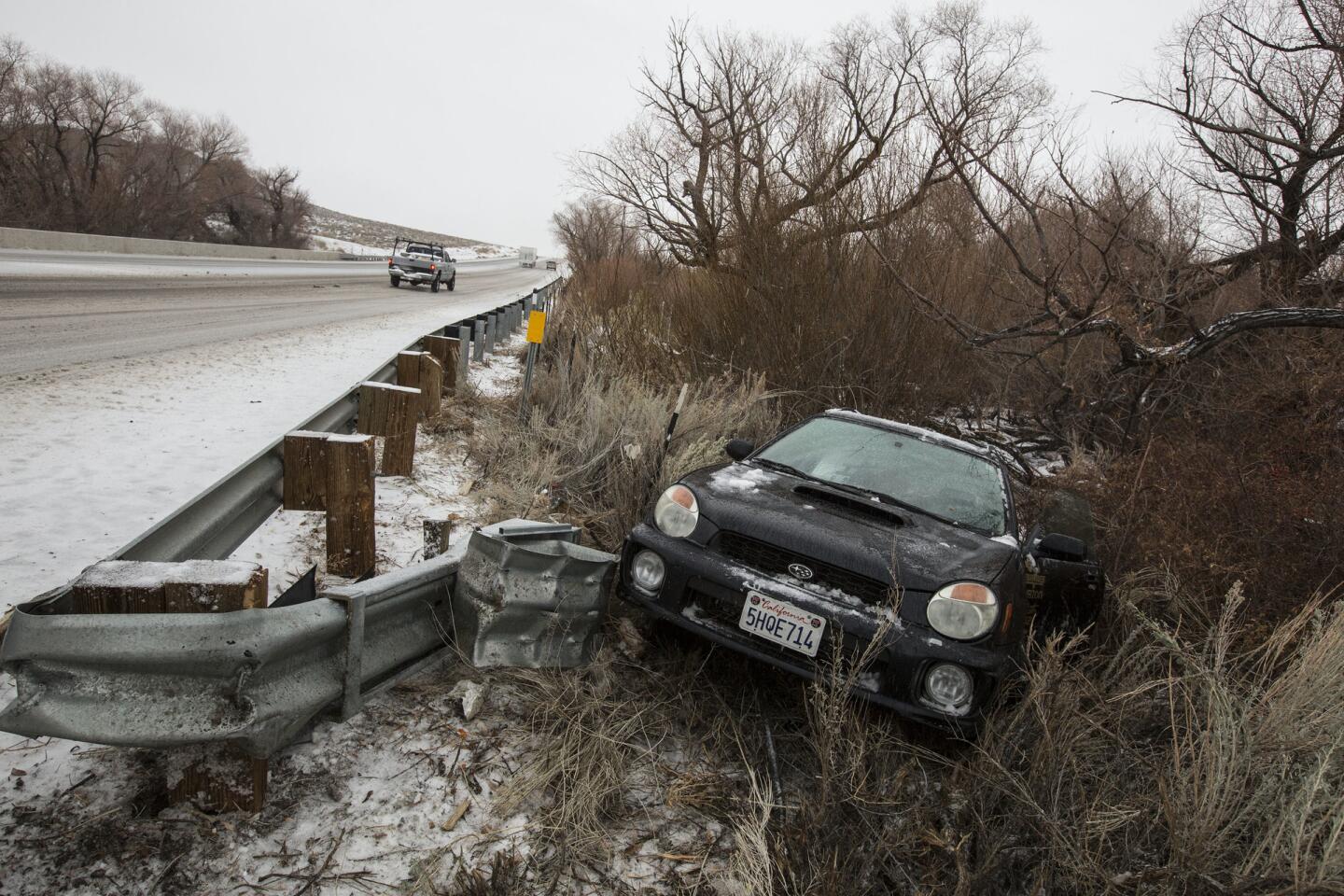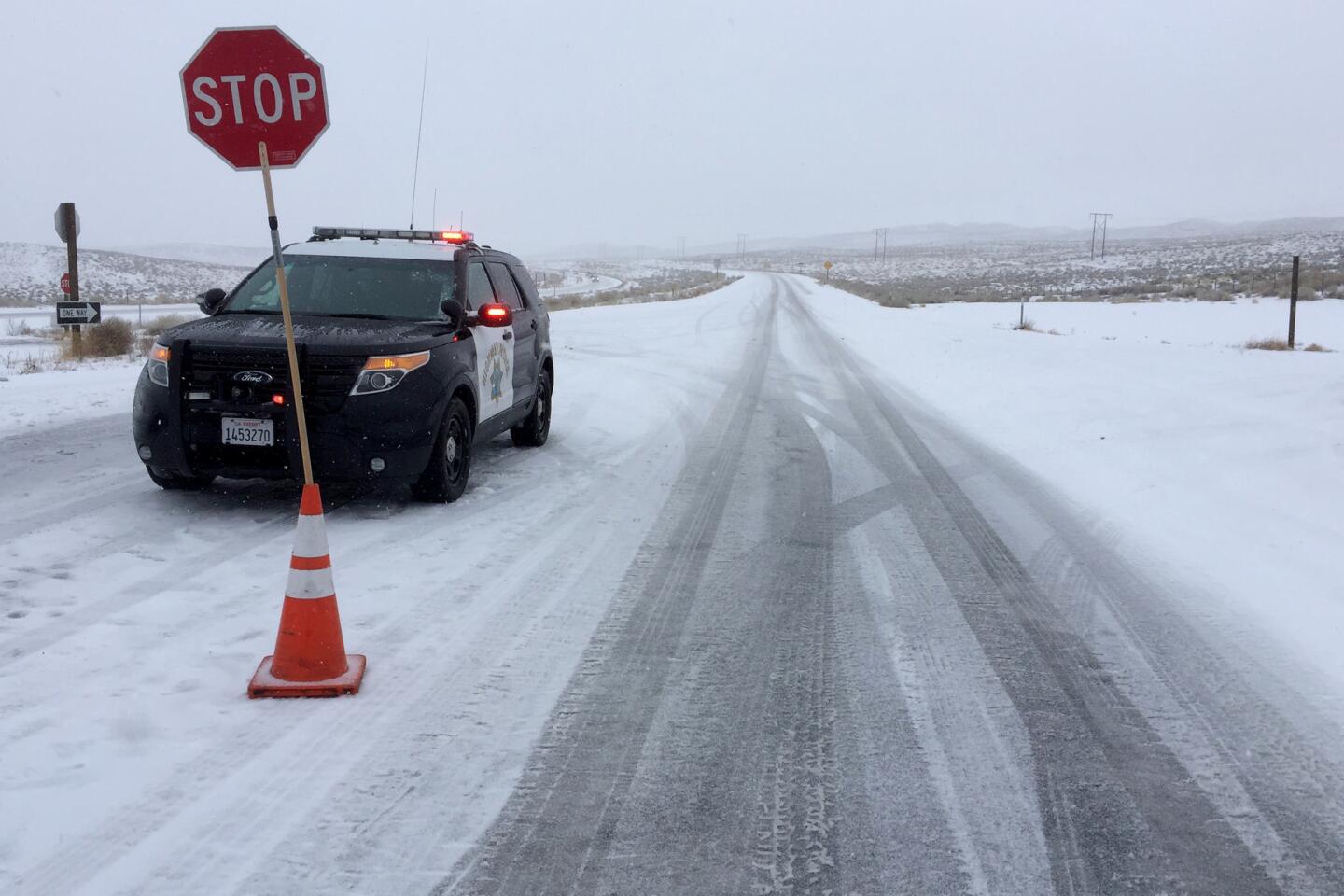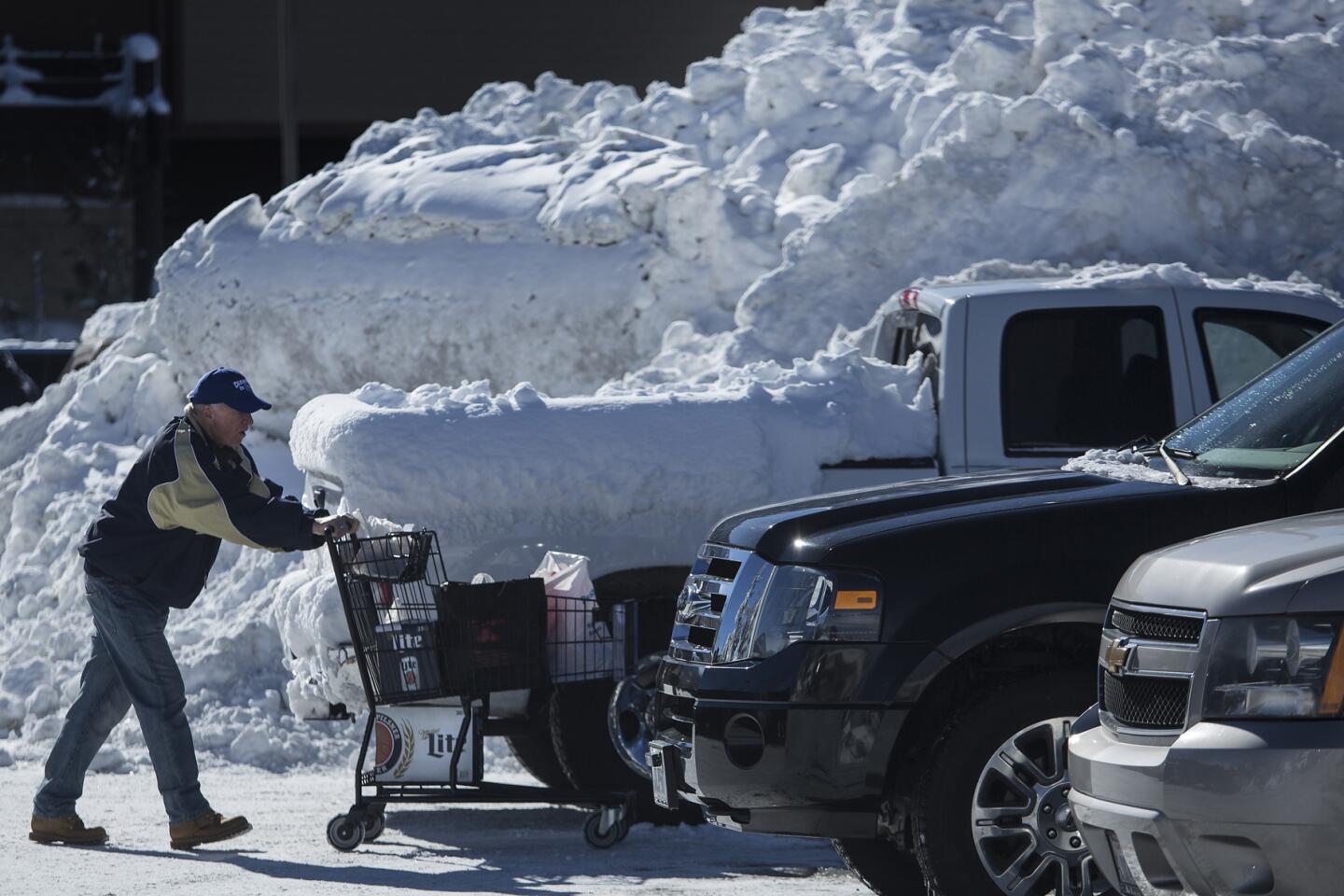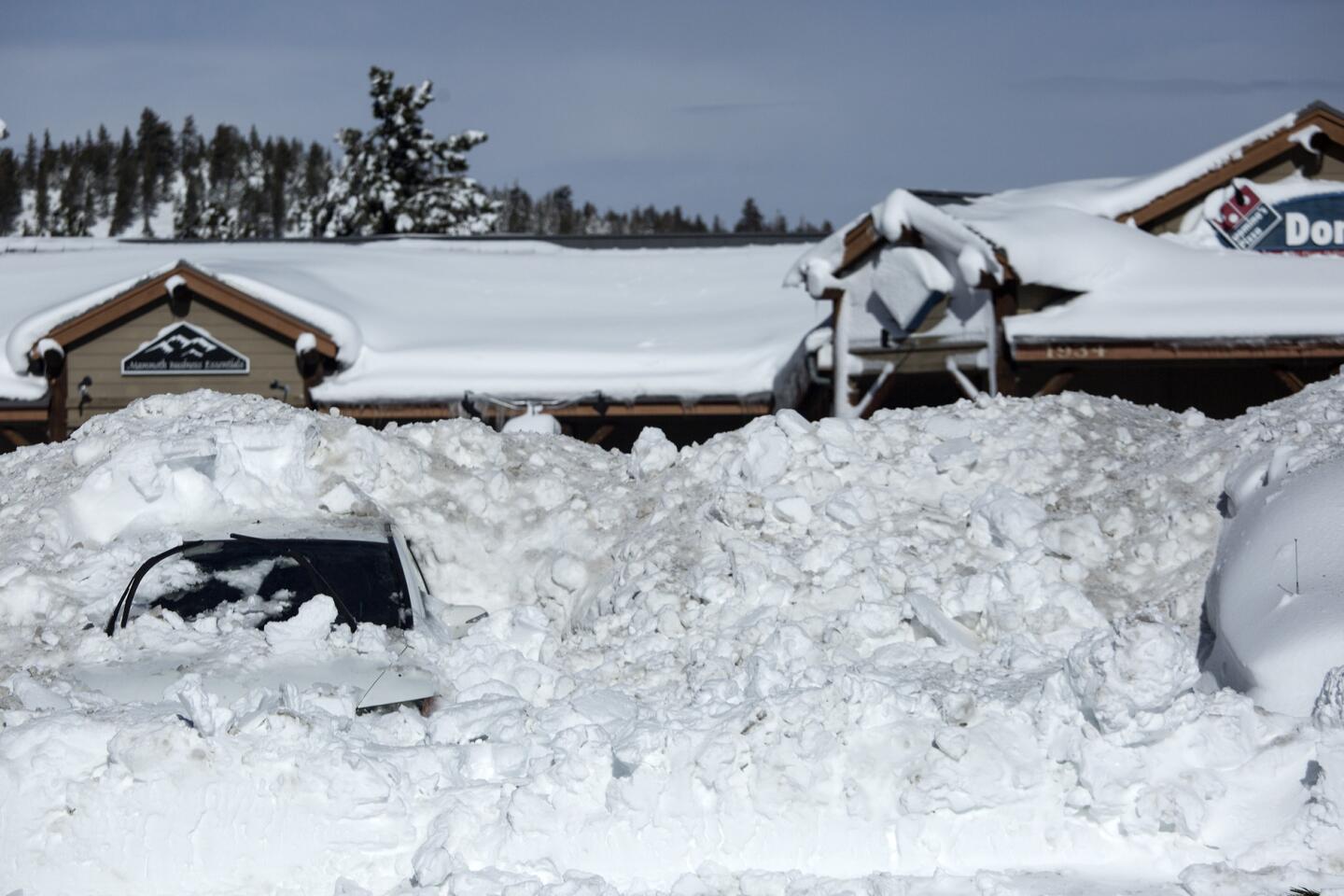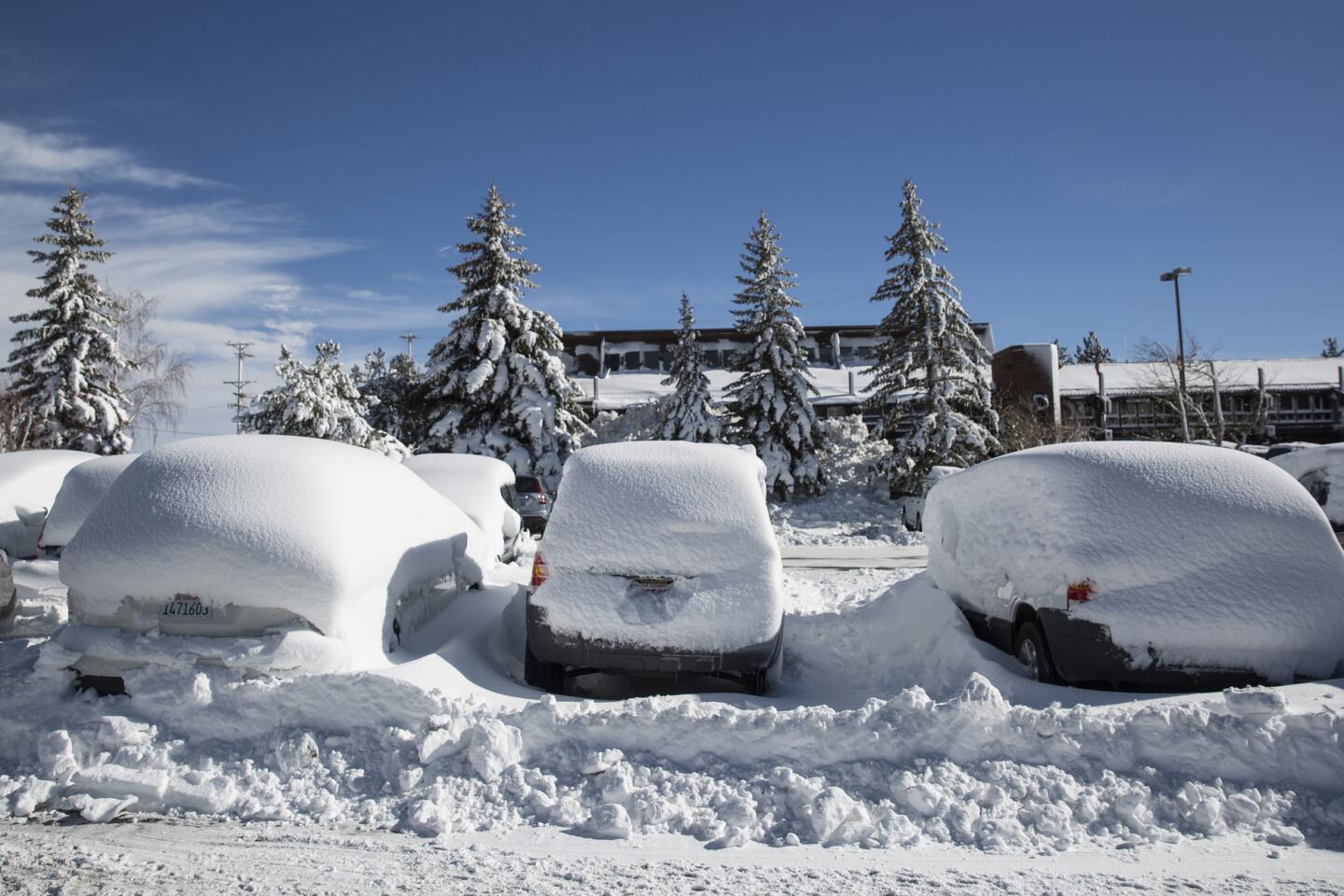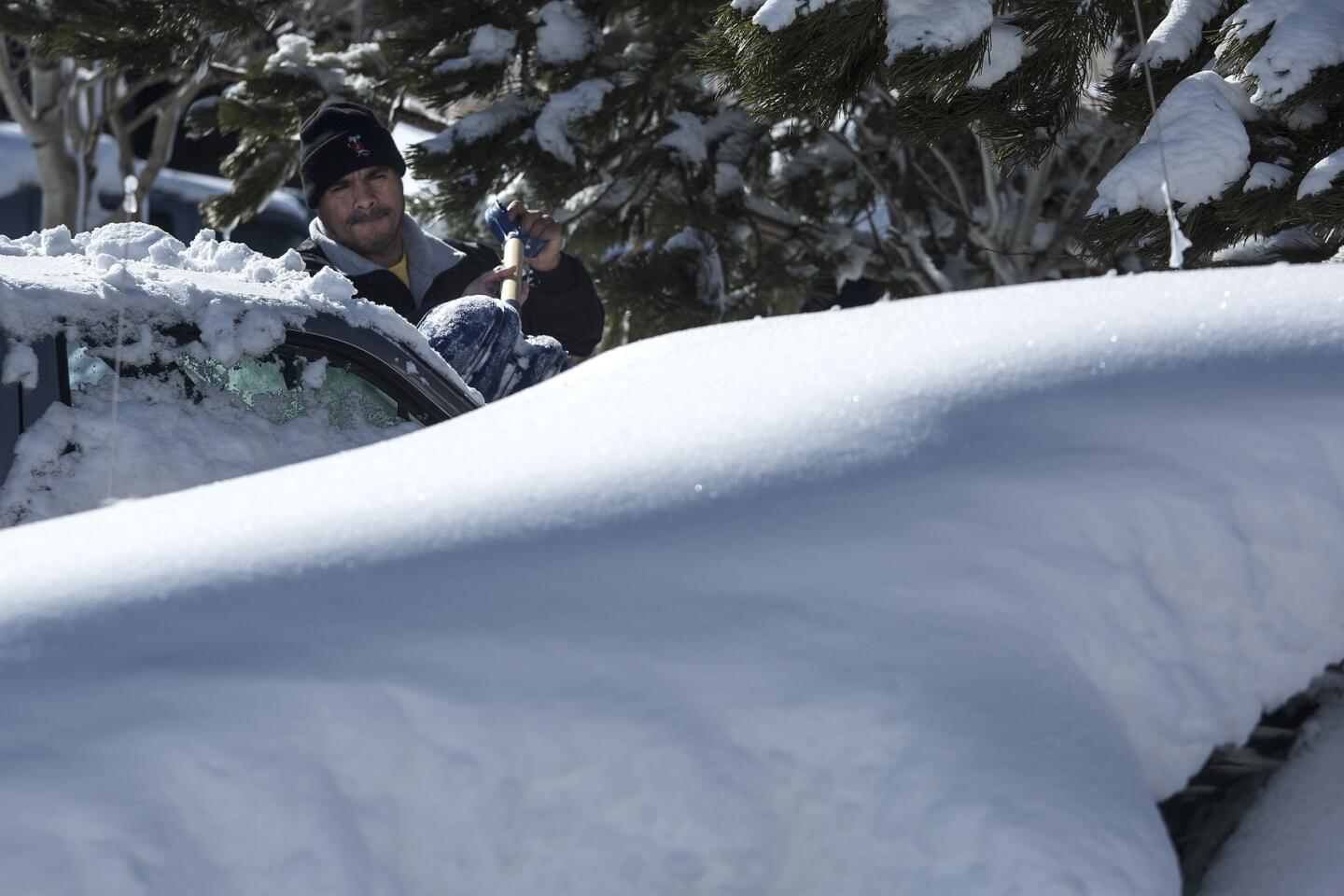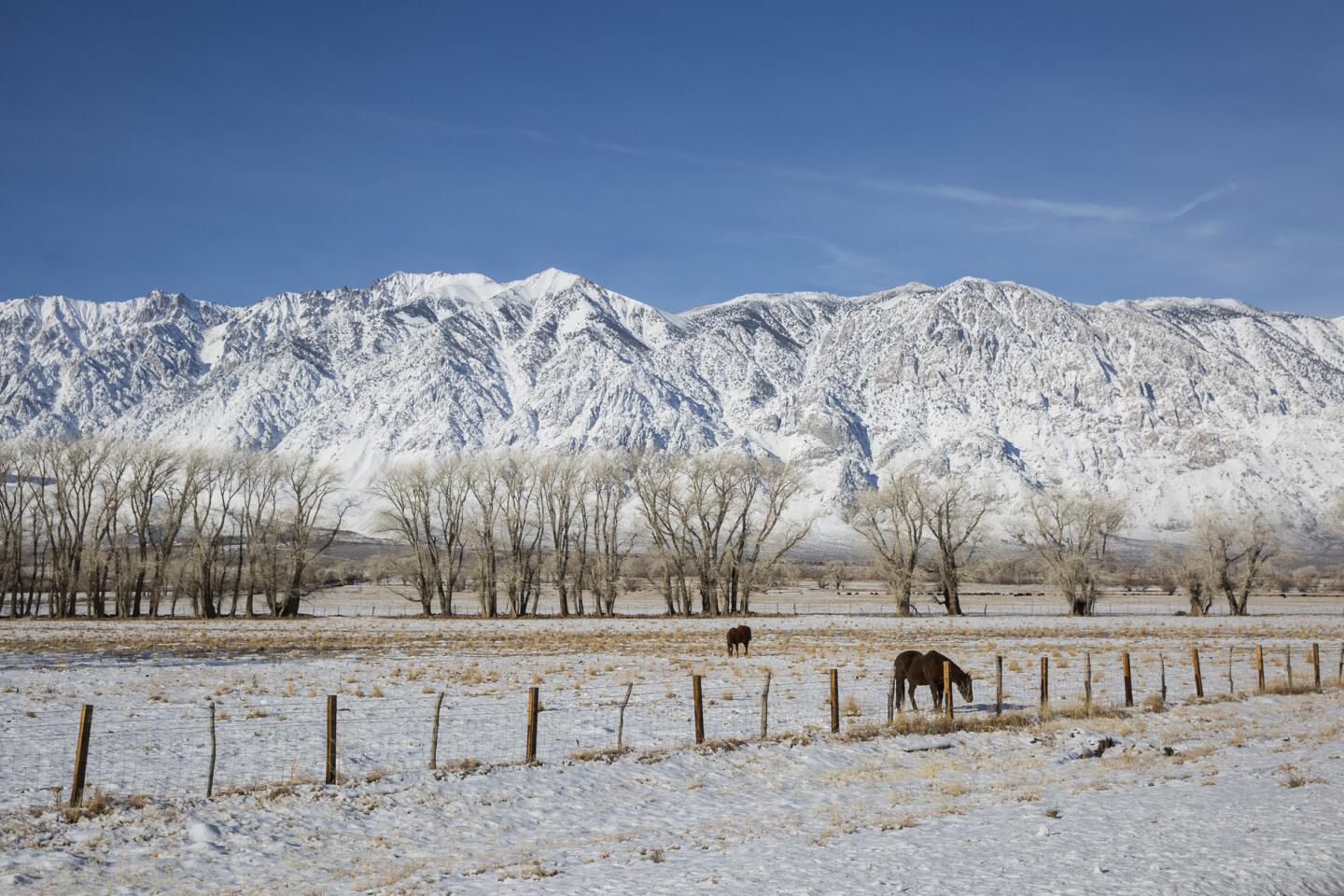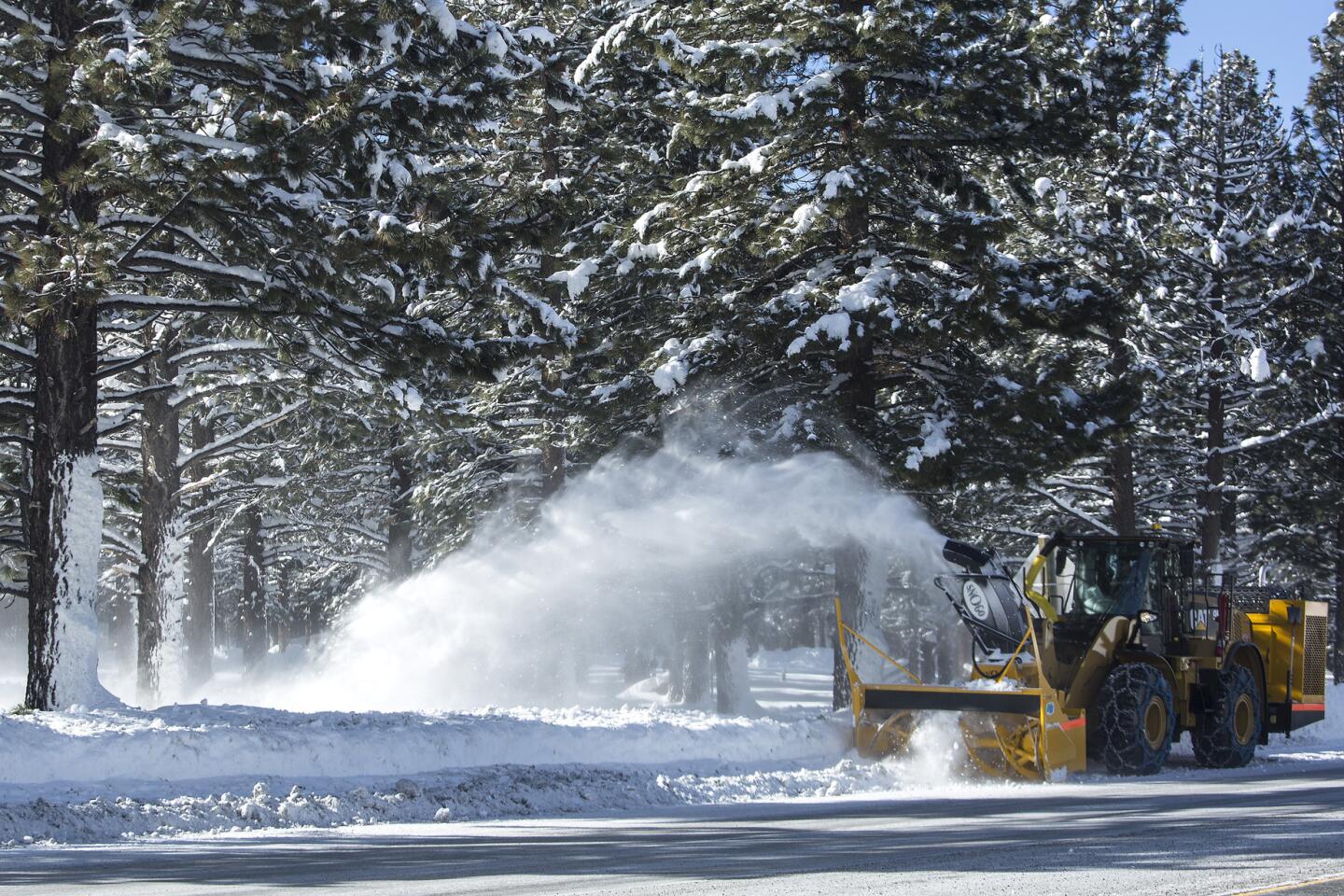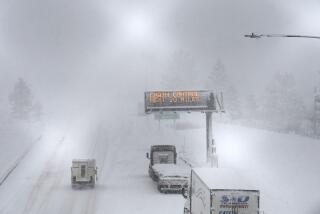Monster storm barrels into Northern California; woman killed by falling tree amid heavy winds

Atmospheric rivers are key to California’s rainfall.
Reporting from Mammoth Lakes, Calif. — The strongest part of a series of storms barreled into Northern California on Sunday, bringing flooding, heavy snow and concerns about avalanches.
Officials reported scattered flooding and mudslides throughout the region, including a washed out road in Windsor that required the rescue of two people. Local authorities were watching rising water levels at several key rivers including the Truckee, Merced, American and Russian.
An “extreme” avalanche warning was issued for parts of the Sierra Nevada Mountains Sunday because of heavy snow. In Mammoth Lakes, officials said higher elevations recorded 48 inches of snow in the last two days.
Winds topped 50 mph in some areas. A woman was killed in the East Bay suburb of San Ramon on Saturday when she was struck by a falling tree at a golf course amid heavy winds.
Up to 12 inches of rain is expected to fall on areas below 8,500 feet beginning Saturday morning, and up to 7 feet of snow could bury higher elevations, according to the National Weather Service. Forecasters said the storm was packing the same wallop as one that hit Northern California in 2005, causing $300 million in damage.
This weekend’s system could bring 36 consecutive hours of heavy rain from Mammoth Mountain to Susanville, in Lassen County. Though that is good news for California, which is entering its sixth year of drought, the coming rain could melt already standing snow — feeding watersheds swollen from storms earlier this week, forecasters said.
“It’s going to be a busy weekend,” said Edan Weishahn, a meteorologist with the National Weather Service in Reno, sighing.
The rain moved in late Friday and continued into Saturday morning, with the most powerful punch expected later in the day.
In the eastern Sierra Nevada, snow continued to fall at higher elevations while rain drizzled lower down as officials warned that wetter, rainier conditions on tap for later this weekend could spell trouble.
Officials toiling to keep highways clear said they were concerned about a warmer phase of the storm that could fall as rain even at higher elevations, melting the built-up snow and unleashing mudslides, flooding and avalanches.
“It’s the rain over the snow that we’re worried about,” said Greg Miller, a Caltrans maintenance manager. “We’ve had snow since Christmas, but now with the warmer trend, we’re worried about water.”
With storm drains frozen, he said, an influx of rain could send water and mud into roadways.
Miller said crews were taking special precautions to prevent rockslides from a segment of U.S. 395 near Lee Vining and avalanches from several other critical transportation corridors.
Friday morning, Caltrans closed part of California 120 near June Lake while a crew set out off remotely detonated charges to clear avalanche-prone slopes of accumulating snow.
Crews were plowing, sanding and blowing snow from roadways around the clock in 12-hour shifts, Miller said.
The California Highway Patrol responded to several reports of rolled-over vehicles and other snow-related collisions on U.S. 395.
Tire chain restrictions were in effect across much of the Sierra Nevada.
Residents in Mammoth Lakes are concerned that warm rain and slush will dam up behind banks of shoveled snow piled high in empty lots and along roads throughout town, then flow wherever it can find a path, clogging existing drainage systems with debris and ice.
Live updates: Winter weather slams California »
“In this town, we don’t even have rain gutters because they get ripped down by snow,” said Lisa Isaacs, a resident and environmental activist. “So, we’re very worried that this storm will flood homes and garages.”
The National Weather Service issued a flood watch warning for Sunday, and town officials advised residents to stock up on water, food, first aid supplies, clothing and bedding, tools and emergency supplies, along with special items for medical conditions.
On a winter war footing, Mammoth Lakes residents lined up throughout the day on Saturday at the town’s utility yard to load up on 40-pound sandbags they hoped would steer waves of slush away from homes, ground-floor condominiums and businesses.
Among them were Mammoth Lakes residents Greg Newbry, 66, a recently retired Mono County employee, and his wife, Linda Salcido, 67, Mono County’s director of public health.
“I was here in 1982 when this town was wrecked by massive flooding,” Newbry recalled. “Main Street was under 2 feet of water. Businesses closed. The roofs of five mobile homes collapsed under the weight of rain on snow.
“If we get all the rain predicted in the forecasts,” he added, “every slab of concrete at ground level is vulnerable, and we live in a ground-floor condominium.”
As she helped tote 20 sandbags to their vehicle, Salcido said she was concerned about the potential effects of flooding countywide.
“Snow, even lots and lots of it, we can handle,” she said. “But a major flood event would lead to countless challenges.”
Up on Mammoth Mountain, the mood was more upbeat as thousands of skiers and snowboarders raced down slopes that had received as much as 80 inches of snow over the last week alone.
Rising 11,000 feet from a gap in the Sierra Nevada range, Mammoth Mountain’s steep chutes stand in the path of freshly brewed atmospheric river systems. With relatively low mountains to the west of it, Mammoth receives most of their unspent snow.
But big snowfall, high winds, warm rain and rising temperatures are forces that transform pile powder into unstable clumps that set off avalanches. So Mammoth Mountain Resort specialists were bringing snowpacks down with artillery including howitzers.
Down in Mammoth Lakes, Isaacs spent Saturday hoping that “the rain they keep talking about will turn out to be snow.”
“But it’ll probably be like having a giant fire big hose turned on us and we’ll be swamped,” she said with a nervous laugh. “I just hope that my little $150 water pump can keep with it.”
Mammoth Mountain Chief Executive Rusty Gregory had few answers. “The main topic of conversation over cocktails on Sunday night,” he mused, “will be about what actually happened.”
As snow and rain continued to fall over the Sierra Nevada, highway patrols and maintenance crews were kept busy Friday responding to snow-related accidents and icy road conditions.
Steve Coons operated a massive Caltrans wing plow. Its engine strained as it worked in tandem with another truck to clear and sand two northbound lanes of U.S. 395 north of Bishop, a key transportation corridor along the Eastern Sierra Nevada.
From behind the wheel of the rumbling truck, Coons can feel the weight of the heavy, wet snow as it pushes against the plow blade and is shoved to the side of the highway.
“The truck is really chugging,” he said. “It’s going to be a long day.”
Coons monitors closely the consistency of the snow, which wavers between soft, large flakes and icy shards. The more that falls as rain and ice, the more he worries it will make the roads slick and cause serious trouble for drivers.
“As soon as it gets cold all this ices up,” Coons said. “Not good.”
He and other plow operators are on the roads 24 hours a day, working 12-hour shifts. They will have no shortage of snow to clear with the series of storm cells expected to continue dumping moisture over the area for days.
“Our guys have pretty much been on since Christmas, and it’s not letting up,” said Greg Miller, maintenance manager for Caltrans District 9, which includes Inyo, Mono and eastern Kern counties.
The storm was also bringing wind gusts that topped 50 mph. Officials said they were low snow and icy conditions on Interstate 5 and 80 as well as U.S. 50 and some mountain highways.
The National Weather Service on Saturday released a new timeline for the storms moving through the region:
Saturday: Moderate to heavy snow in mountain areas.
Sunday: Heaviest rain and snow, with risks of flooding.
Monday: Showers and snow continue, with continued flood risk.
Tuesday: New storm moves in, lower snow levels, flood risk.
Wednesday: Showers and snow, with rivers running high.
“We’re expecting heavy, heavy rain. It starts out as snow then turns to rain then turns to snow again,” Hammitt said. “We’re concerned about the melt increasing waterways and all the lakes.”
Hammitt recalled storms in 1997 and 2005 when runoff overwhelmed local rivers and creeks and sent water into roads and homes, lifting some buildings off their foundations.
“We have streams, creeks, rivers. We have lakes and ponds,” Hammitt said. “Anybody near a water source could be in jeopardy depending on the severity of the storm.”
Two sinkholes have been reported on El Dorado County roads as a result of three days of rain this week. Residents have already filled 12,000 sandbags in preparation for the storm and an additional 20,000 were on the way in, Hammitt said.
“Anytime it’s Mother Nature, you have to be ready,” Hammitt said.
While Northern California faced the brunt of the storms, a less powerful system moved into Southern California overnight, bringing scattered showers Saturday morning. The rain was harder to the north along the Central Coast. The wet conditions should continue through the weekend.
But much of the concern is focused on the Bay Area and Sierra.
“It’s a once-in-10-year event,” said Zach Tolby, a meteorologist with the National Weather Service in Reno. “It’s the strongest storm we’ve seen in a long time, the kind of setup we look for to get significant flooding.”
Indeed, large swaths of the Bay Area, Sierra foothills, Central Coast and parts of the Sacramento Valley were under flash-flood warnings. Flood concerns are heightened because officials fear that the snow may quickly melt due to heavy rain.
The so-called atmospheric river of airborne moisture known as the “Pineapple Express” will be felt across much of the state this weekend, though rain will be much heavier in the north than in the south.
“It’s going to be like buckets of water for a fairly sustained period of time,” Tolby said.
Wind gusts on mountaintops could top 130 mph in the northern Sierra, which is typical, Tolby said. At lower elevations gusts could reach 30 or 40 mph, he said, “but that’s an average windy day for us.”
Tolby said the storm is packing the same wallop as an atmospheric river that hit Northern California a decade ago that caused $300 million in damage, according to the U.S. Geological Survey.
Angelenos may remember the 2005-06 storm because it was the first time it rained on the Rose Parade in 51 years. But Tolby, who lives in Lake Tahoe, remembers the storm differently.
“It was pretty wild. I was here in 2005 and it was definitely the hardest rain I’d ever seen. It didn’t stop for 24 hours,” he said.
This weekend’s storm could bring 36 straight hours of heavy rain from Mammoth Mountain to Susanville, Tolby said.
Below clear blue skies Friday, people in the snow-shrouded ski town of Mammoth Lakes were gleeful about the prospect of several more feet of snow.
Yet some also worried that the big, wet storm could dump so much rain and snow that it could shut down some ski runs or roads.
In preparation, snowplows were scraping icy roadways. Excavators and snowblower operators stayed busy clearing and moving huge piles of snow. Some cars sat abandoned on the roadside or at gas stations, covered with thick blankets of snow from the most recent storm.
Outside Kittredge Sports, store manager Terry Lucian took advantage of the clear weather to shovel away some of the mounds of snow that had built up outside the entrance.
“If the storm comes in as wet as they’re talking about, it’ll make for a big mess,” the 60-year-old said as he scooped icy snow off the entrance to the A-frame building.
Lucian said recent storms definitely helped to boost business, but he worried some skiers traveling to the area this weekend could be in for disappointment if storm conditions worsen to the point that they shut down parts of Mammoth Mountain.
“Everybody wants the snow, they just don’t want it while they’re here,” the 39-year Mammoth resident said. “It’ll be a rough couple of days, but we need the water. So it’s going to be OK.”
Up north, South Lake Tahoe Mayor Austin Sass urged residents to prepare for the storm.
“If at all possible, get up on your roof and get off whatever snow you have on there because the moisture combined with the snow will be extremely heavy and we’re worried about the integrity of your roof structure,” Sass tweeted Friday.
Do not go outside Sunday or Monday, he told his constituents.
“When the snow comes mixed with the rain, it’s going to be an absolute mess. So whatever you can do stay home, and most importantly, stay safe,” he said.
In the mountains, the rain could saturate the snow and trigger early melt, feeding extra runoff into watersheds already swollen from a week of rain.
“A combination of intense rain on saturated soils will lead to excessive runoff,” the National Weather Service said in its weekend forecast.
The Carson, Truckee and Susan rivers are all expected to become overwhelmed, and nearby communities may become increasingly isolated if the deluge triggers mud and rock slides.
Weather officials issued a flood watch from Saturday to Wednesday that covers much of Northern California and extends down through the Sierra to Tehachapi.
In Mono County, authorities offered sandbags to residents in preparation for the rain. In Yosemite National Park, officials announced Friday that the park would remain open through the wet weekend, but access to popular Yosemite Valley would be closed.
Earlier in the week, up to 2 feet of snow fell in less than 24 hours in the Tahoe basin on Wednesday, at times coming down at more than 2 inches an hour.
The Sierra Avalanche Center reported a slight improvement in backcountry conditions. The risk of avalanche was lowered to “considerable” even as the threat increased of historically large avalanches caused by slabs of snowpack as thick as 8 feet above a weak layer of ice laid down by a mid-December rain.
Near Lake Tahoe on Thursday, two skiers were caught in an avalanche that closed a local highway. But they were not injured, officials said.
Sierra residents are preparing for a third onslaught over the weekend, bringing up to 12 inches of rain below 8,500 feet, and more snow above that. A fourth storm system is forecast to roll across Northern California two days after that.
After the weekend storm, another rain-making system is expected to hit Northern California on Tuesday.
For all the problems the storms may cause, it will bring more good news for California’s six-year drought. Officials have said steady rain in Northern California the last few months has filled reservoirs and increased the once-anemic snowpack.
They emphasize the storms won’t end the drought. But if the rains keep up for spring, they could make a major dent.
St John reported from Colfax, Calif., Serna from Los Angeles, Barboza from Mammoth Lakes, Calif.
ALSO
With snow piling up in the Sierra, what will it take to end California’s drought?
Crashed helicopter and 2 bodies are found in Port of Los Angeles
Suspect in killings of Long Beach mother, 4-year-old daughter will represent himself at trial
UPDATES:
7:45 a.m. , Jan. 8: This post was updated with overnight news. 9:45 p.m.: This post was updated with death of woman.
4:45 p.m.: This story was updated with new details about road conditions from Caltrans.
3:45 p.m.: This article was updated with new details about residents of Mammoth Lakes preparing for a band of warm rain and possible flooding.
2:50 p.m.: This article was updated with new details about road conditions
11:15 a.m.: This article was updated with a revised weather forecast.
10:30 a.m.: This article was updated with a new forecast from the National Weather Service.
8:25 a.m.: This article was updated with information about road conditions.
7:30 a.m.: This article was updated with revised forecasts and rain reports in Southern California.
6 a.m., Jan. 7: This article was updated with storm developments.
9:30 p.m.: This article was updated with rain falling in Bay Area.
7:25 p.m.: This article was updated with information about flood risk.
3:40 p.m.: Jan. 6: This article was updated with details on storm preparations in the Sierra Nevada.
10:50 a.m. Jan. 6: This article was updated with comments from Sierra Nevada residents.
7:45 a.m. Jan. 6: This article was updated with new forecast details.
9:25 p.m.: This article was updated with information on the flood watch.
4:20 p.m. This post was updated with information on California’s drought.
3:11 p.m. This post was updated with information about L.A. rains.
2:10 p.m.: This post was updated with maps and updated forecast information.
This post was originally published at 12:20 p.m. Jan. 5.
More to Read
Sign up for Essential California
The most important California stories and recommendations in your inbox every morning.
You may occasionally receive promotional content from the Los Angeles Times.
